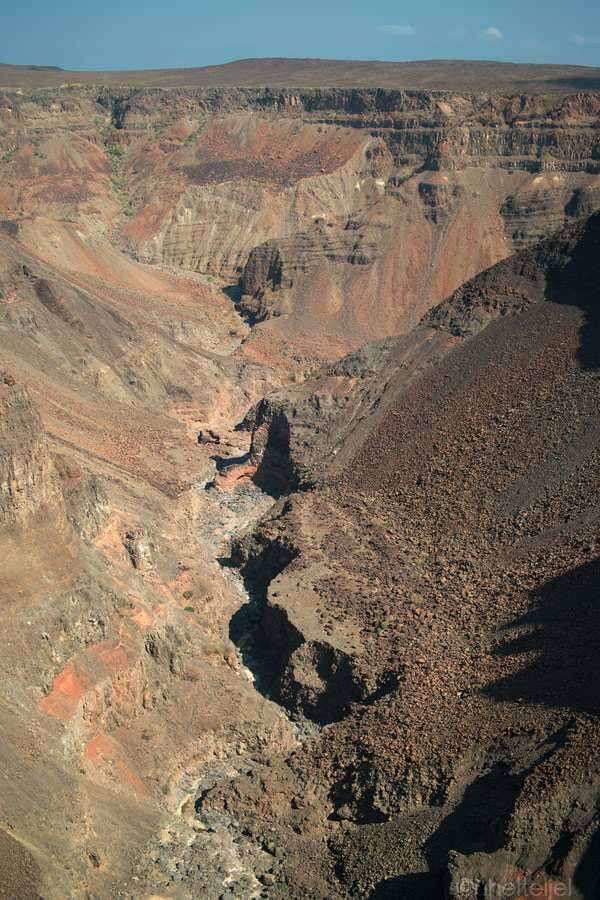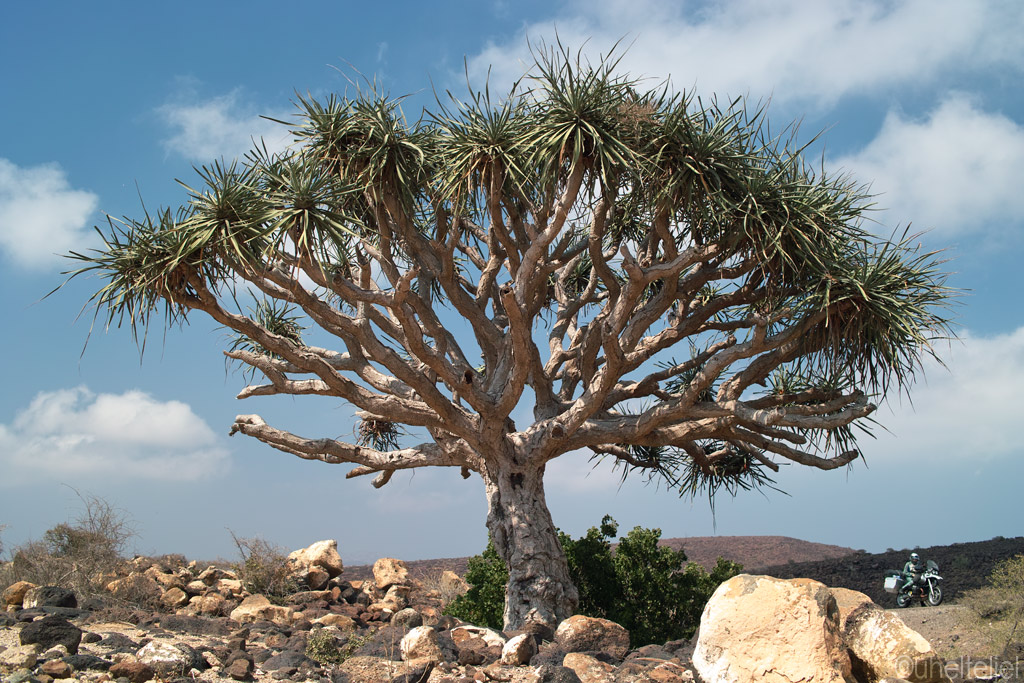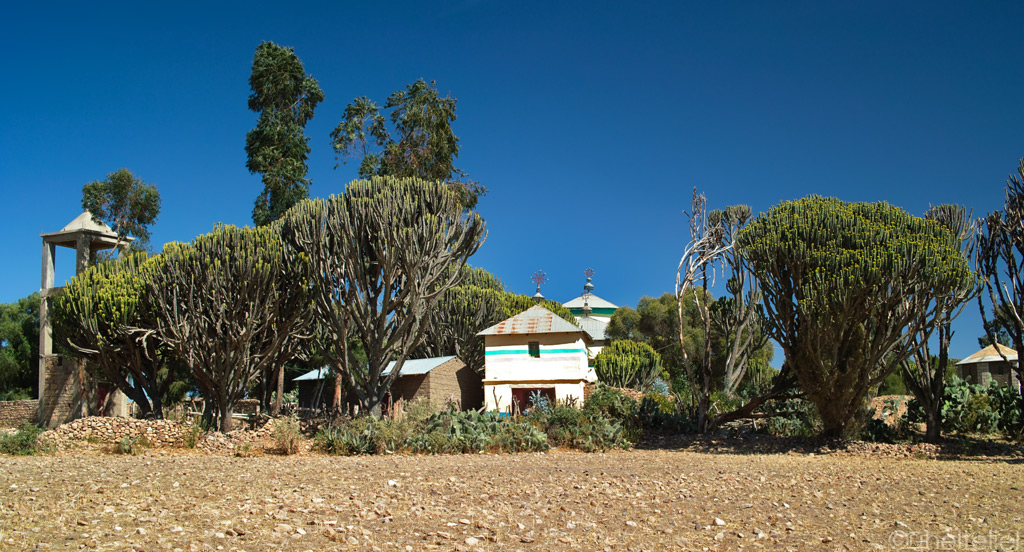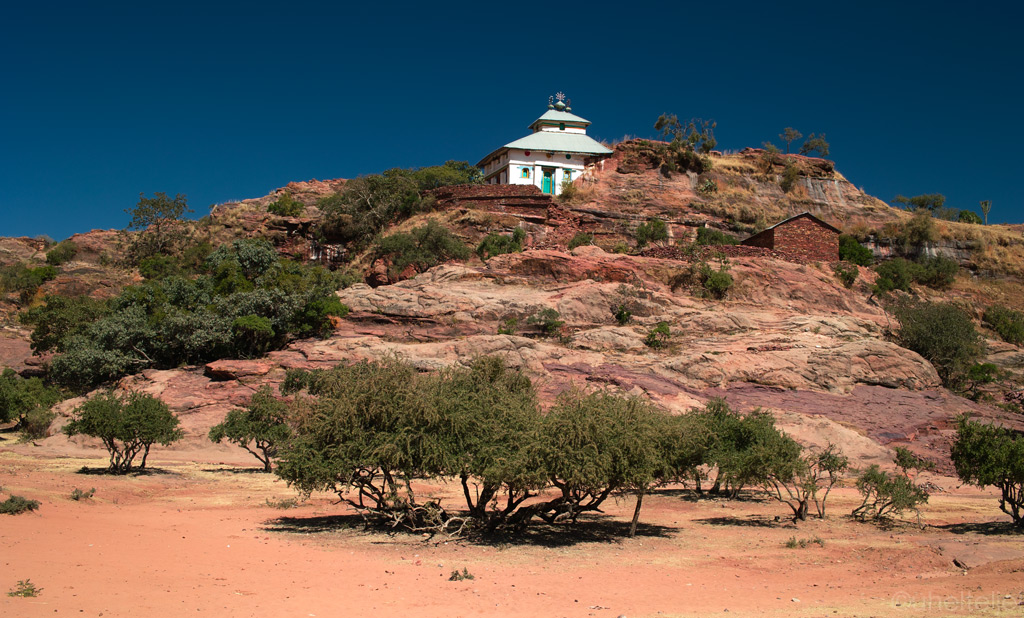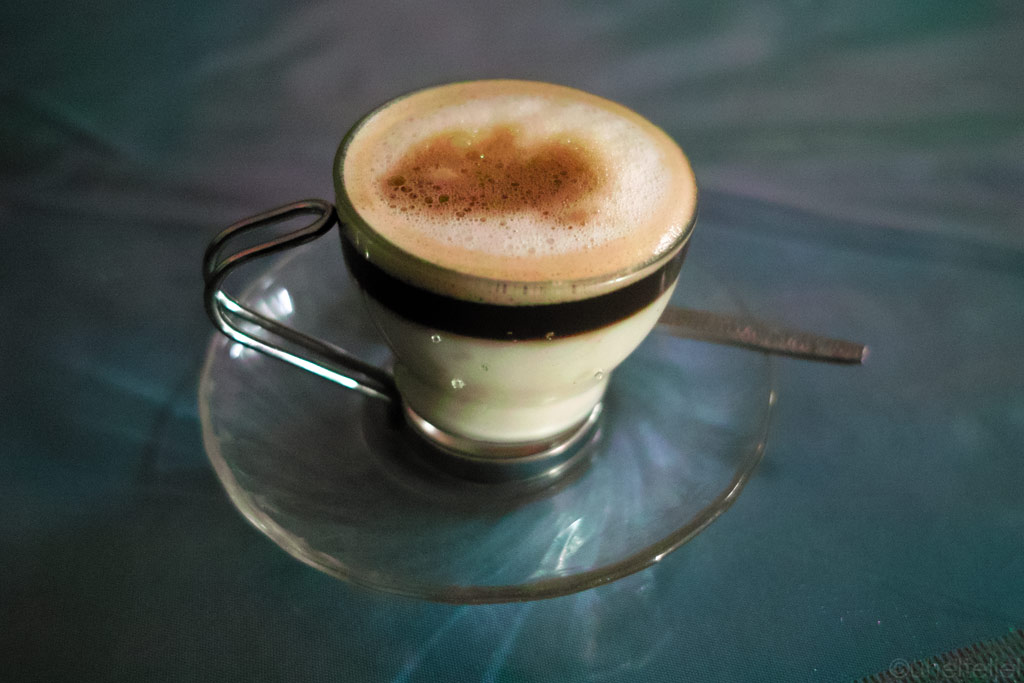Our first two weeks in Africa were not quite Shakira and cheery black ladies had depicted. Djibouti is an expensive place, and although you do not have to look hard to find some decent steak and fresh baguette - heritage from French colonial times - after the sophistication of the Middle East, our first stop in Africa is far from being sleek or even appealing. The streets are lined with rubbish and which ever trajectory you choose, beggars and kids waiting for hand-outs are everywhere. But we had no choice but to linger because due to some recent change in Ethiopian visa policy the only embassy that would issue us, Estonians, visas for Ethiopia, was the one located in Stockholm, Sweden. It would have been great to send our passports for processing while in Sana'a, Yemen, where staying is cheap and at the same time enjoyable, but at the time we were there no cargo was leaving Yemen to Europe due to the printer cartridge incident, so we had to part with our passports while in Djibouti.
Of course we trusted our passports to DHL (and not regular post) to be delivered to the Ethiopian embassy in Sweden and then to be brought back again. I do not know if any other company would have performed better, but DHL truly screwed. They might be fast and efficient when it comes to transit, but it took them five days (!!!) to go and pick the passports up from the embassy once the visas were ready, and even that required expensive international calls and multiple visits to the office in Djibouti - just to get things moving. This was simply frustrating, and of course it all cost a fair bit (even though we were trying hard to keep down the cost by staying at the very cheapest hotel we could find, and cooking rice and lentils on our camping cooker in the very same hotel room, every day), but sure the DHL in Sweden is accusing the DHL in Djibouti, and vice versa. It is not the first time DHL has let us down, so I guess next time we'll be using some other company.
So after two weeks, when we finally had our passports, we just zoomed off towards Ethiopia.
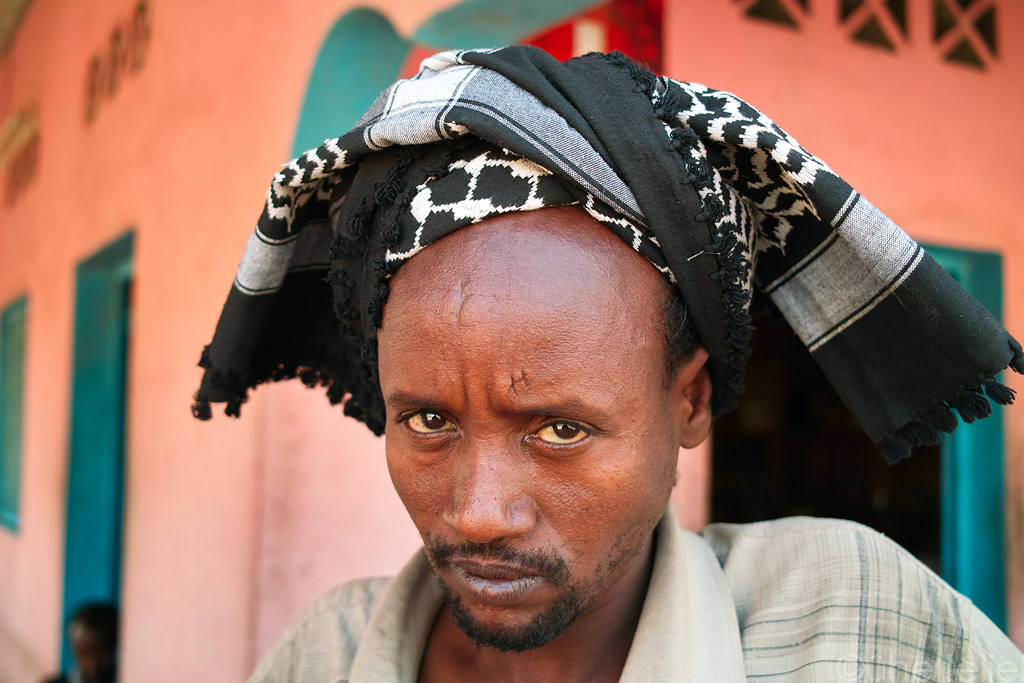
Portrait of a Djibouti man.
Djibouti is a small country and there is not much to see, so on the way to the Ethiopian border we easily managed to squeeze in the major sight - Lac Assal, a salt lake situated at 150 meters below sea level, making it the lowest point on the African continent. Maybe not as syrreal as Salar de Uyuni in Bolivia, it still had its fair share of otherwordliness with turquoise blue waters licking the shores white with salt crystals.

Panorama of Lac Assal - lowest point on African continent (click to enlarge).

(click to enlarge the panorama)
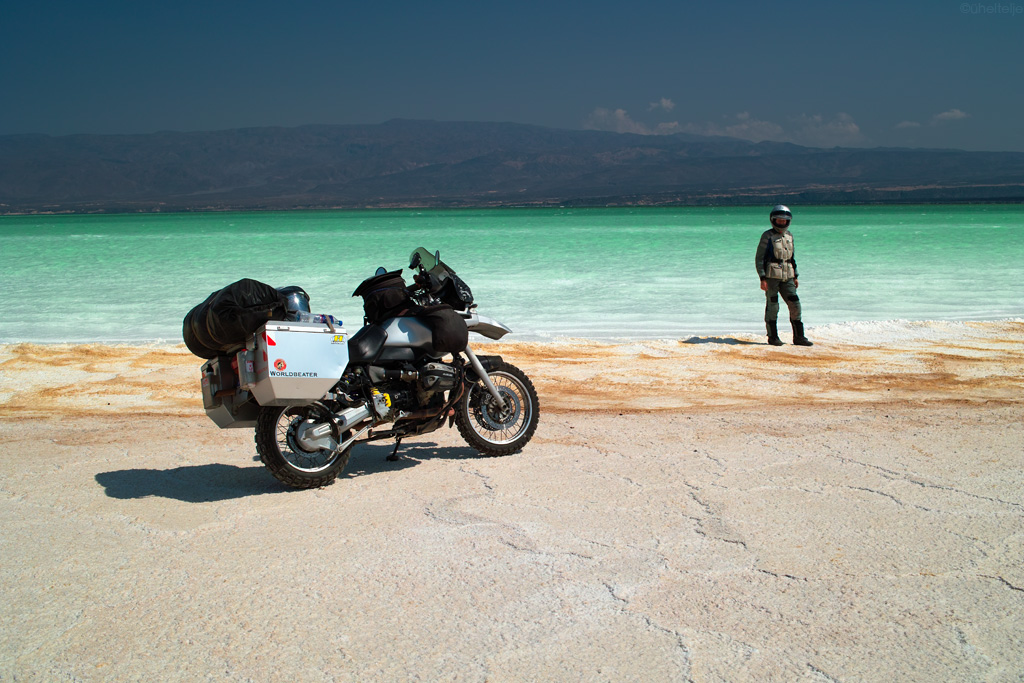
Lac Assal.
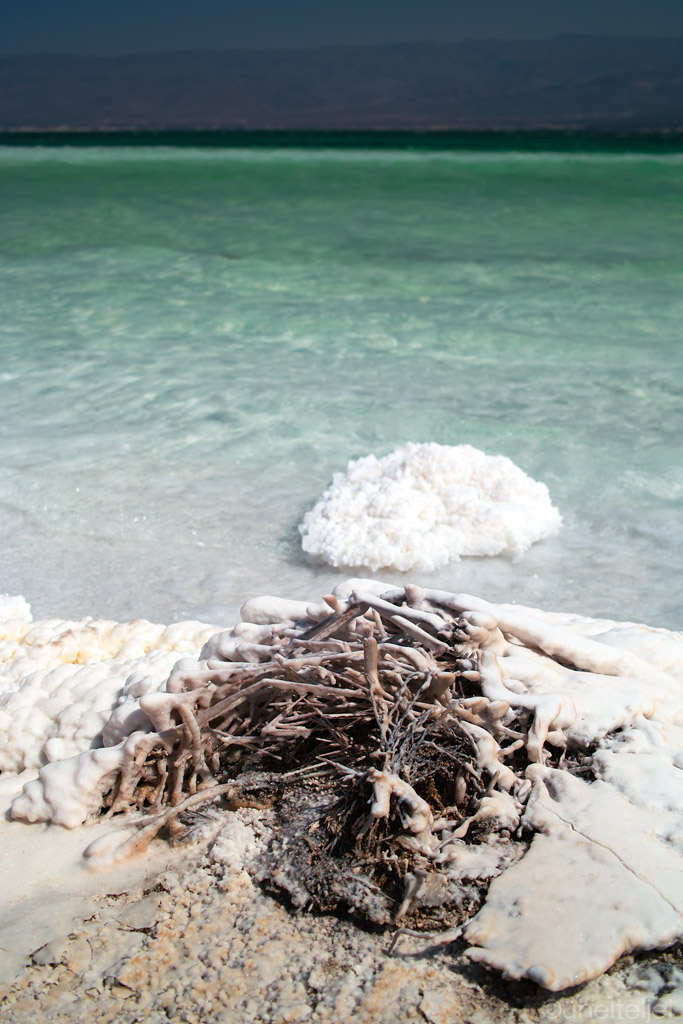
Bush getting covered with salt.
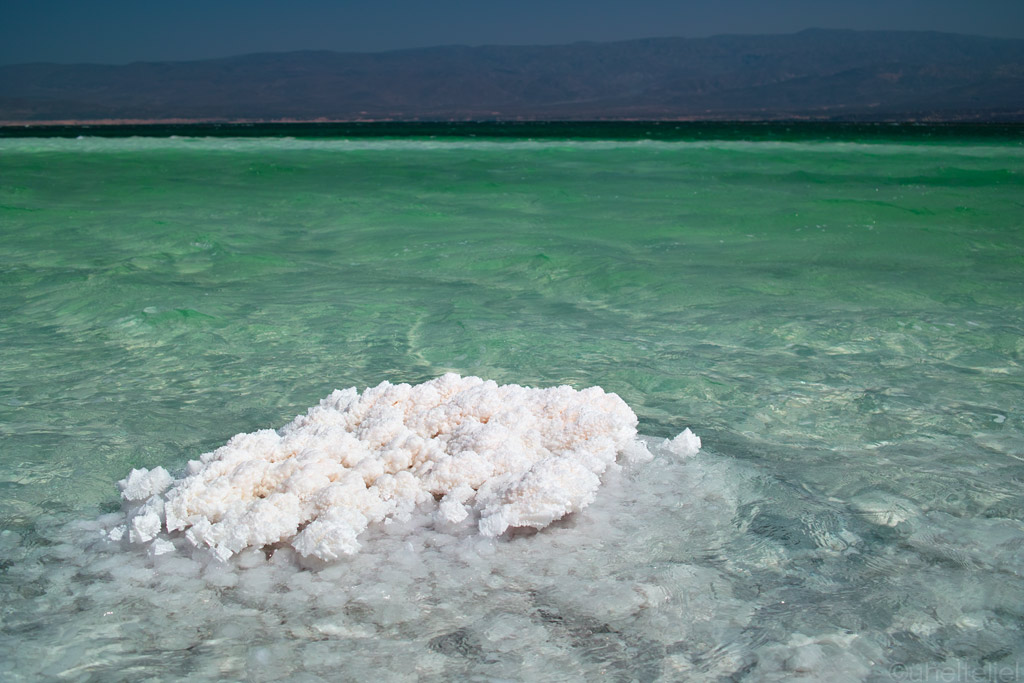
A salt island on Lac Assal.
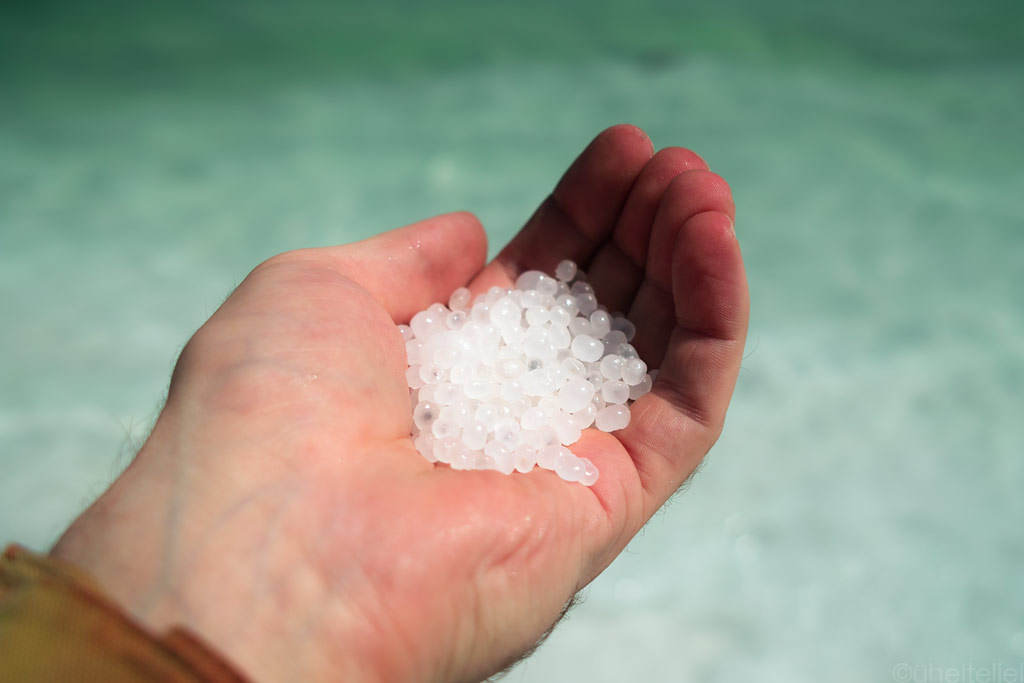
You can take pure salt from the beach of Lac Assal - note the salt forms smooth shapes around small rocks and sand particles.
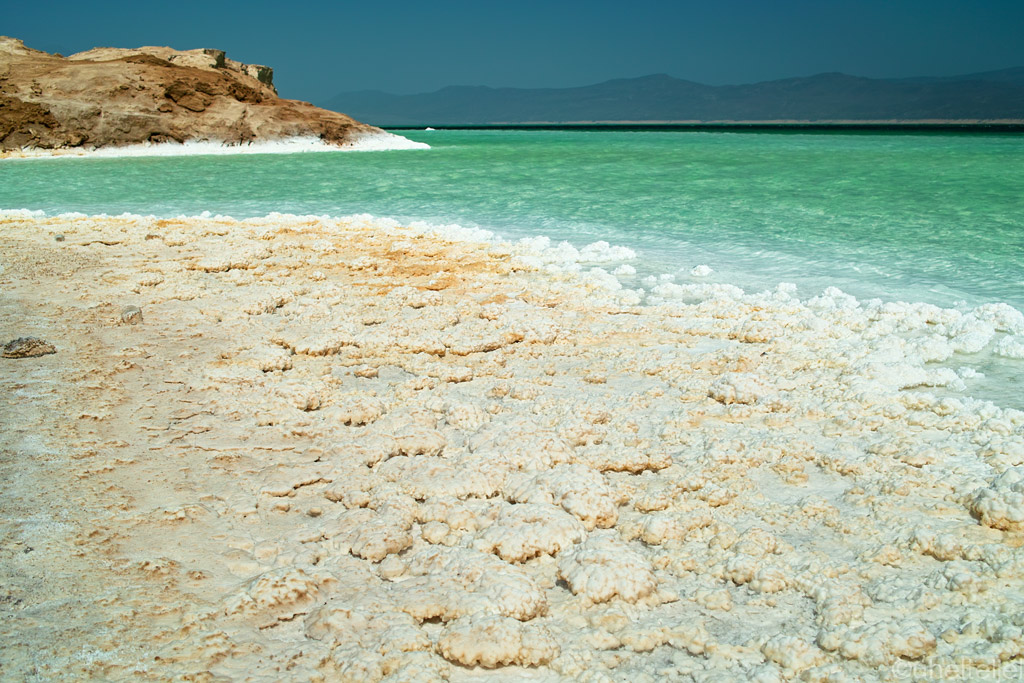
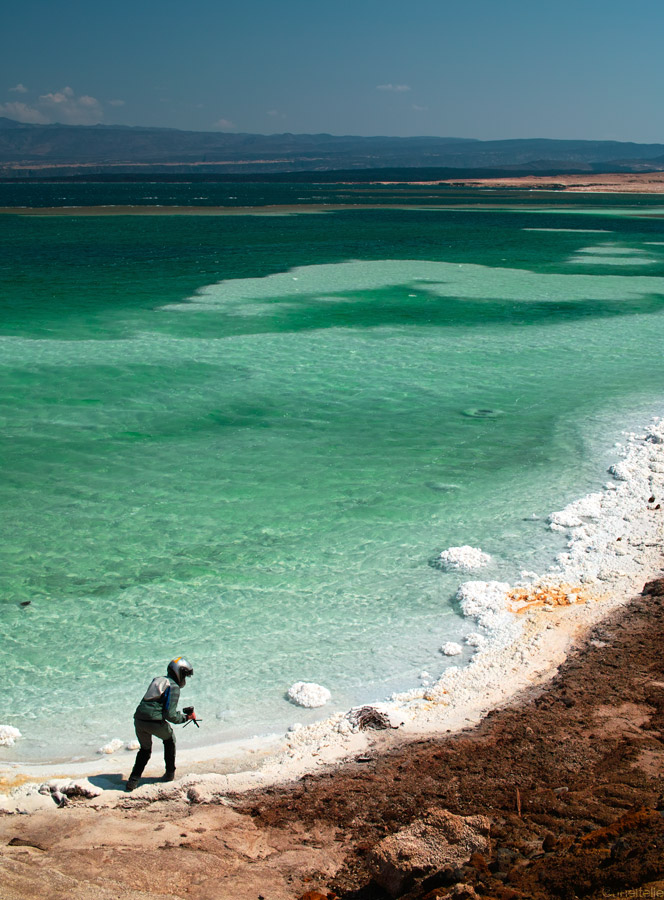
Kariina searching for a good frame.
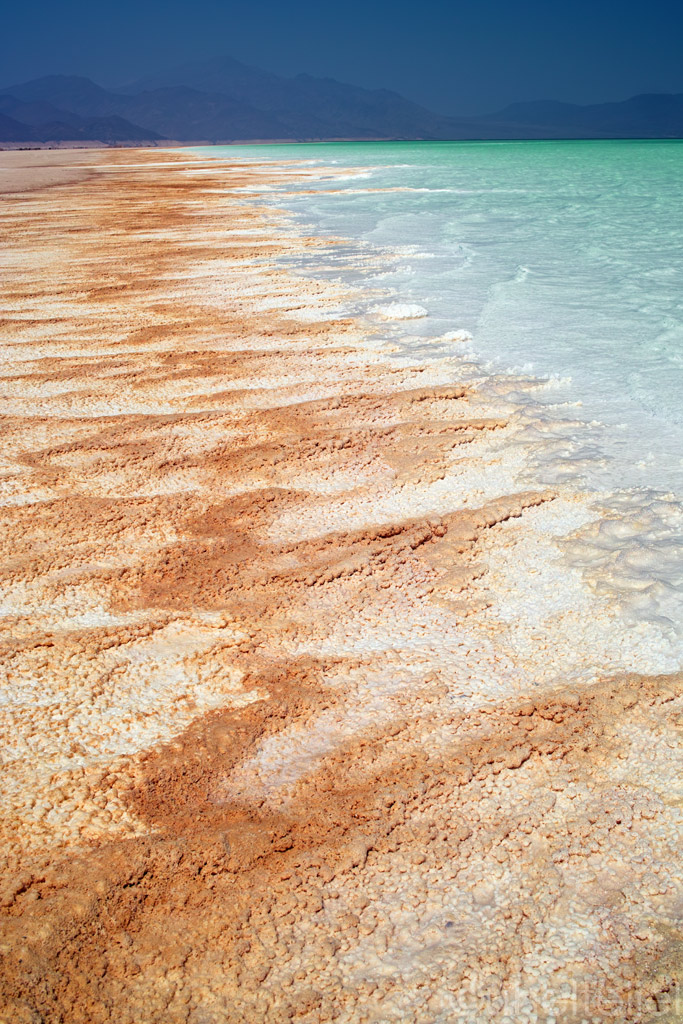
Colours of the Lac Assal beach.
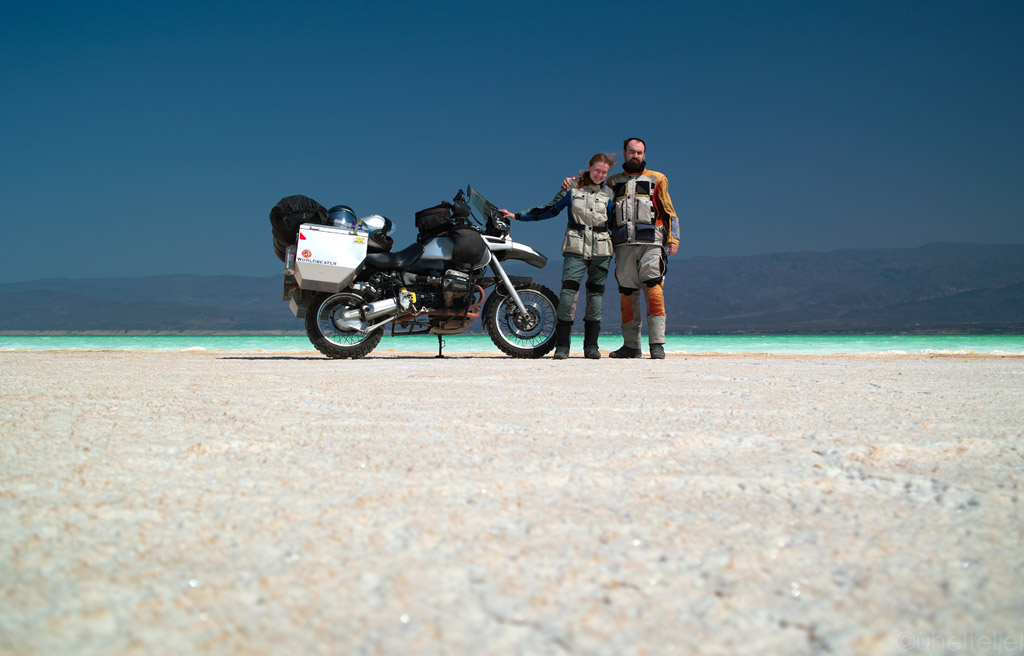
Is it really the lowest point in Africa? Must be worth taking another pic then.
But to be fair, it must be said that not only was it the salt lake that made a positive last impression of Djibouti, but the landscapes and the nature were pretty spectacular, too. We got to see strange trees, canyons and a bunch of monkeys aside the road, so we were impressed and even felt slightly guilty for having had such negative thoughts about Djibouti.
The border crossing to Ethiopia had been making us anxious for a while because many a biker had become stuck on the border due to some very recent requirement by Ethiopian customs authority which says that a Carnet is not enough and one must have a guarantee letter by one's embassy in Addis Abeba saying that they take responsibility for you and your bike. Estonia, of course, has no representation in Ethiopia, so there was no way of getting the letter and we just had to go and try our luck without one. I do not know, maybe it is because the Ethiopian border with Djibouti does not have great significance in terms of tourism (it is crucial, however, in terms of transit to the Red Sea) and the officials there have not been informed of such requirement, or if there is actually no requirement at all (and it is all about greedy officials in certain border posts hoping to make an "exception" in return for some $$$), but the letter was never asked. What a relief!
The 40th country on our journey, Ethiopia greeted us with bright colours, and regardless on incessant "You! You! Money! Money!" coming from the local kids, we felt at home. It was truly good to be on the road again!
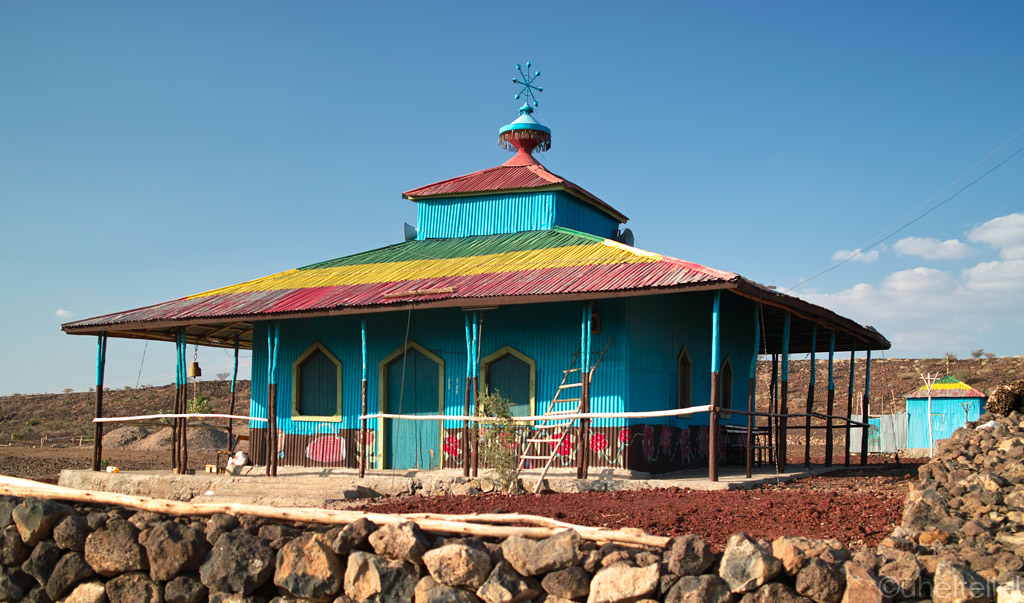
For a long time we hadn't seen churches, this time it's African style!
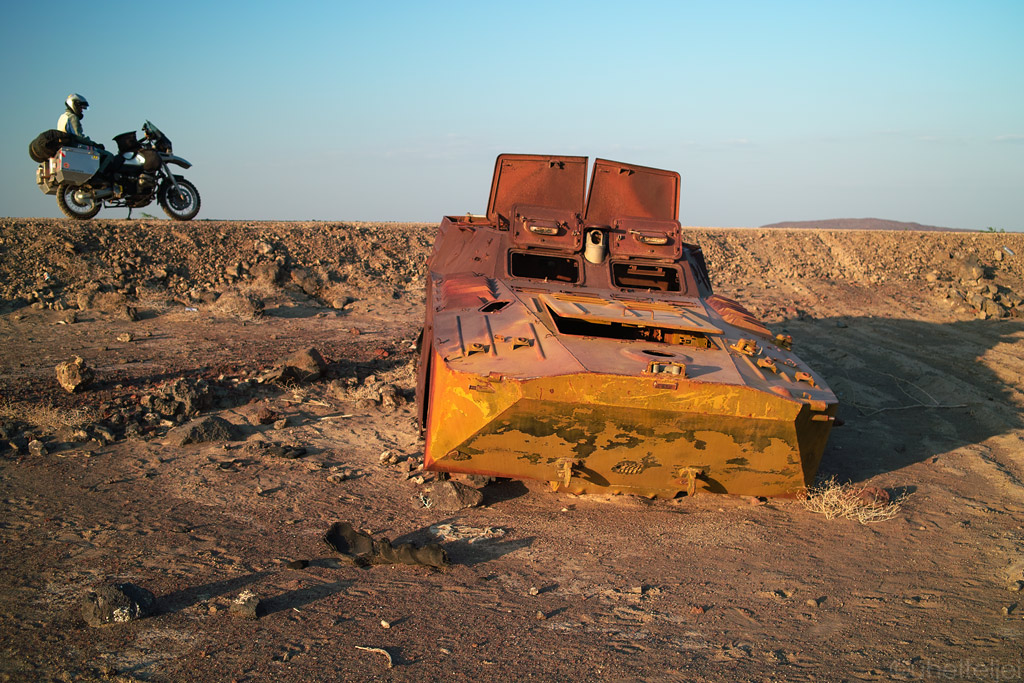
Remains of recent Ethiopia-Eritrea war...
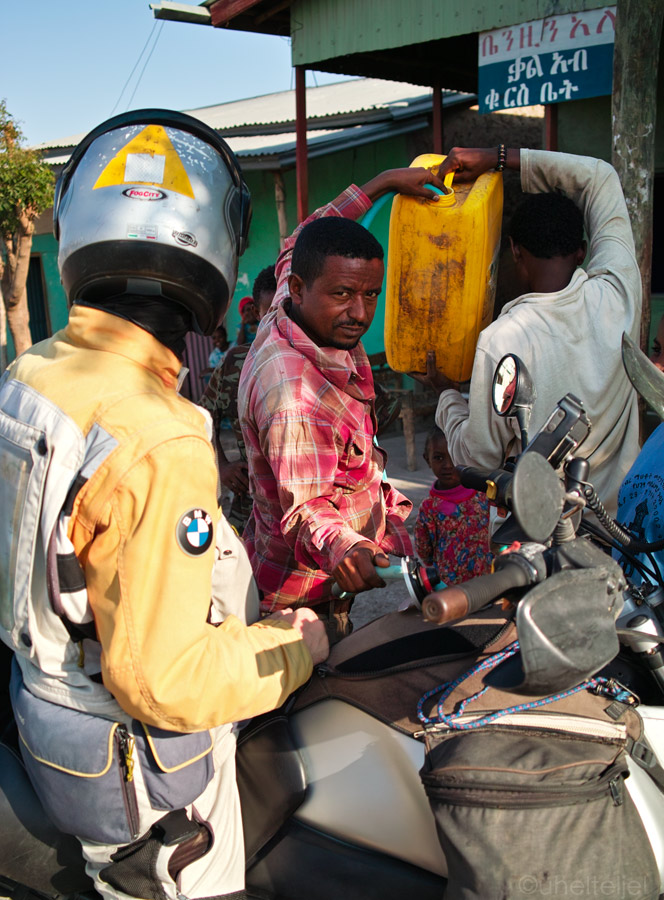
Finding fuel proved to be relatively difficult on our route - fuel stations only offer diesel and gasoline (they call it "benzin") is mostly available from repair garages and private homes on the roadside - served from bottles and canisters.
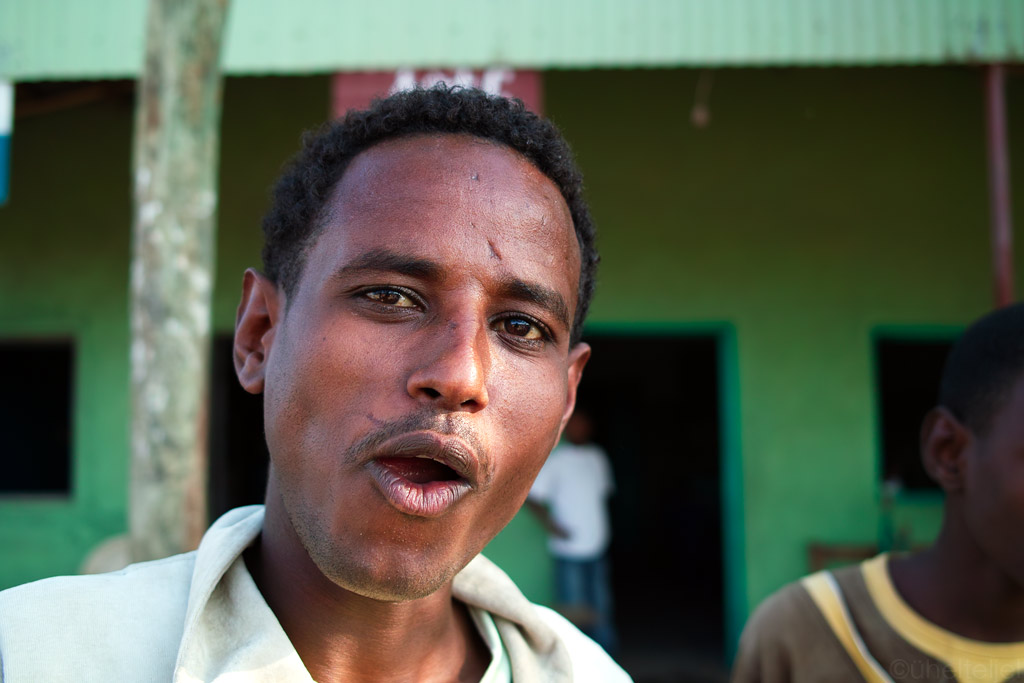
Curious Ethiopian man checking us out.
There is an area in the North-Eastern part of Ethiopia that is called the Danakil Depression and that is pretty special indeed, populated by relatively unfriendly Afar tribesmen and home to glowing lava lakes and salt lakes smelling of sulphur. Never heard of it? We hadn't either. Not many people go there, regardless of all the excitement. It is also where the hottest place on Earth is, with only tracks leading through the sand, and it is damn close to Eritrea that is in a border dispute with Ethiopia. So the bottom line is - you have to go in a group of multiple 4WD-s and have an armed guide with you.
A tour would have eaten a good part of our budget, but we really-really wanted to get at least a glimpse of the Danakil Depression, so we decided to get as close as we could before sand would swallow us or we would be stopped by the police. We got as far as the Lake Afrera where the road ends and things start to heat up before we turned around. No police was there to stop us, but the perspective of digging the heavy bike from the sand in the oppressive heat at a gun point just did not appeal too much. Even there the temperature was +38C, so the common sense won this time.
It was a nice ride though, through endless lava fields and nice mountains.
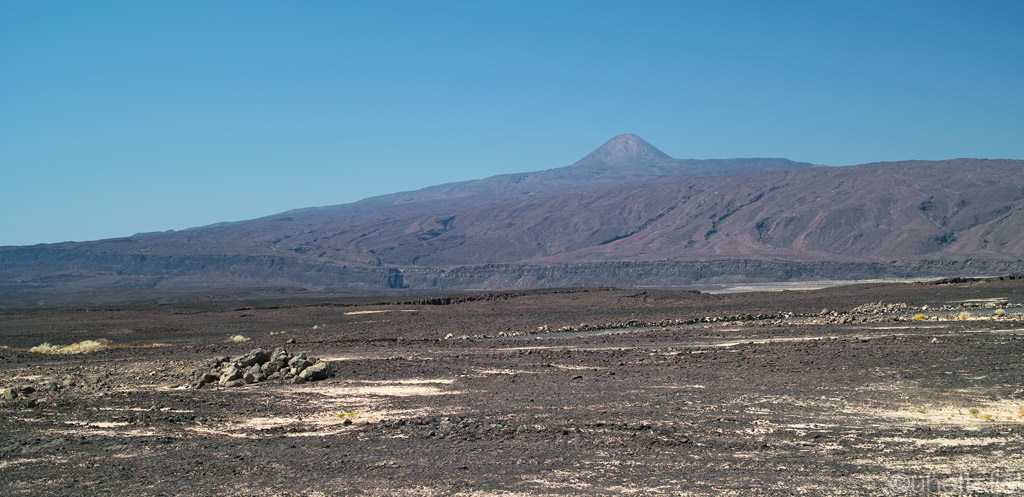
Terara Afrera mountain (volcano).

Panorama of Denakil Depression's lavafields (click to enlarge)
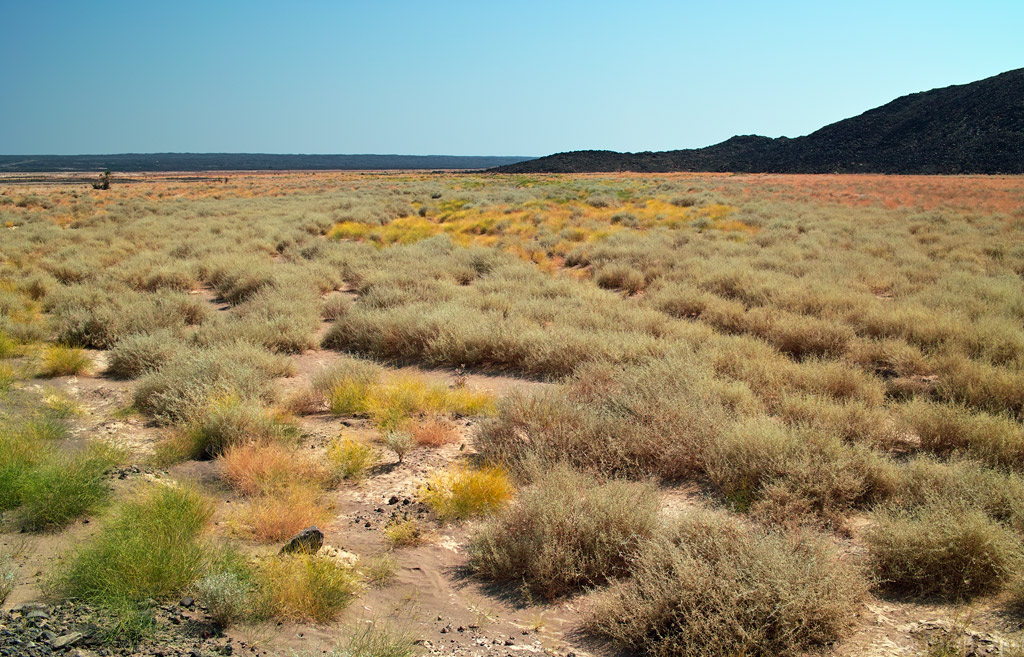
Denakil depression, some 100 meters below ocean level.
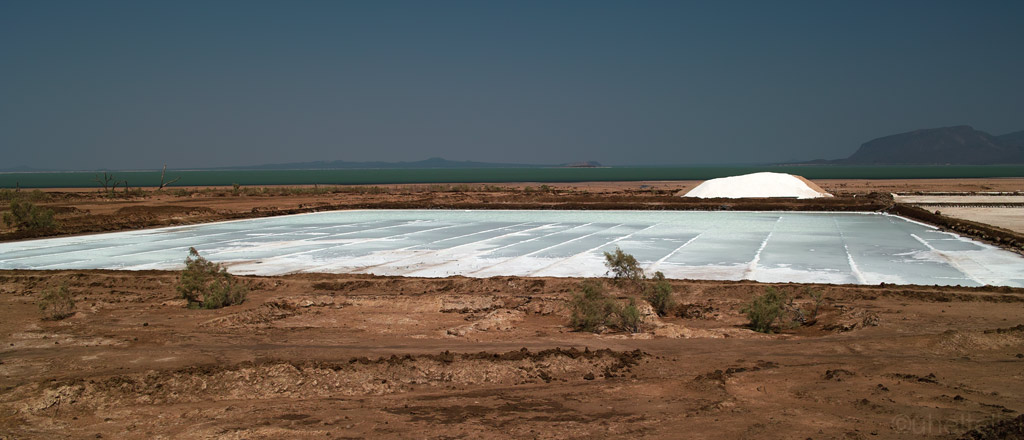
Salt condensing and collecting at the Lake Afera.
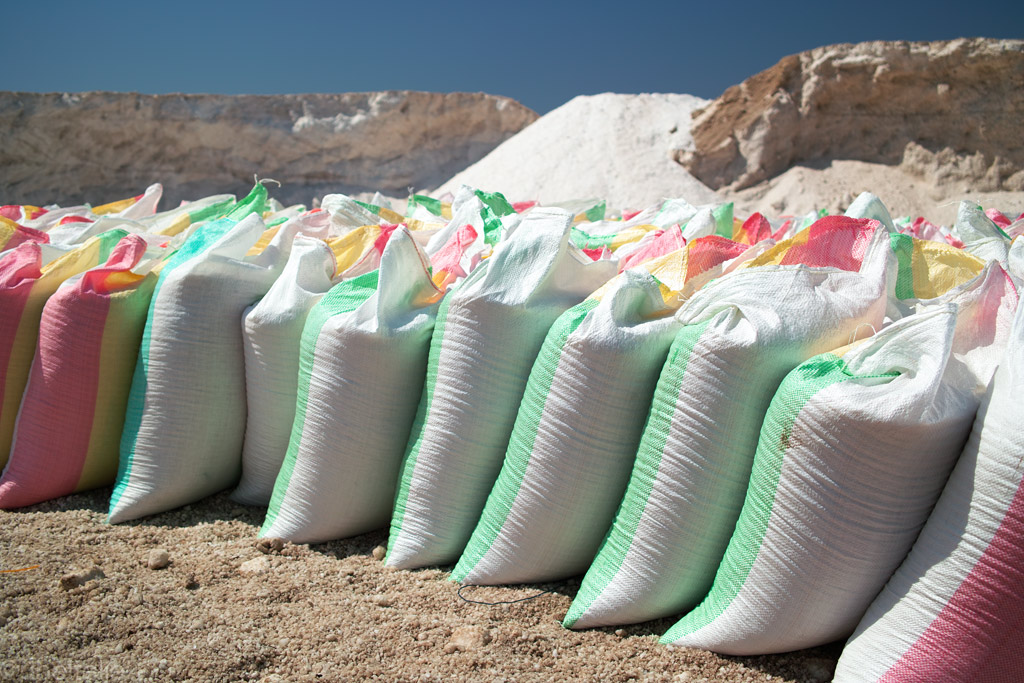
Salt into bags and for sale worldwide - who knows, a pinch of salt for your fried eggs might come from here!?
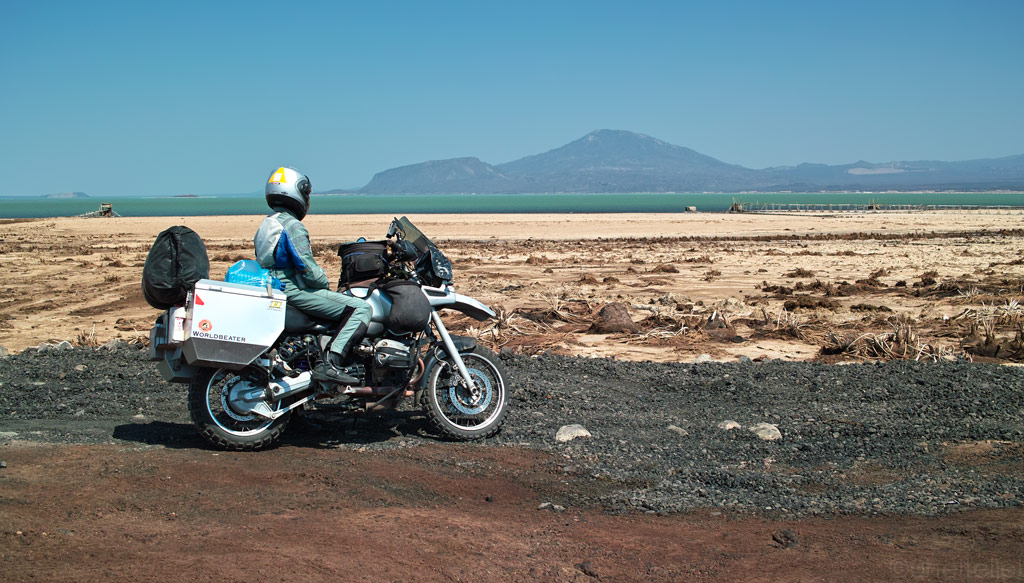
Lake Afrera.
It is funny how some place can grow onto you. We stopped at a random truckdriver motel for the first night in Ethiopia (the sun was setting so we didn't risk riding on to find something more decent), and the next day, backtracking from our little Danakil Depression ride, we decided to spend there another night, although we could have ridden on for a couple of hours more. The shared toilets were stinky, the showers were slimy and the glass in our room door was broken so that hordes of mosquitoes could come feasting on us at night, but there surely was something about the place. Maybe it was the palm trees painted on the walls, or the cheap, good food, or the even cheaper beer (that costs just the same as a bottle of Coke!).
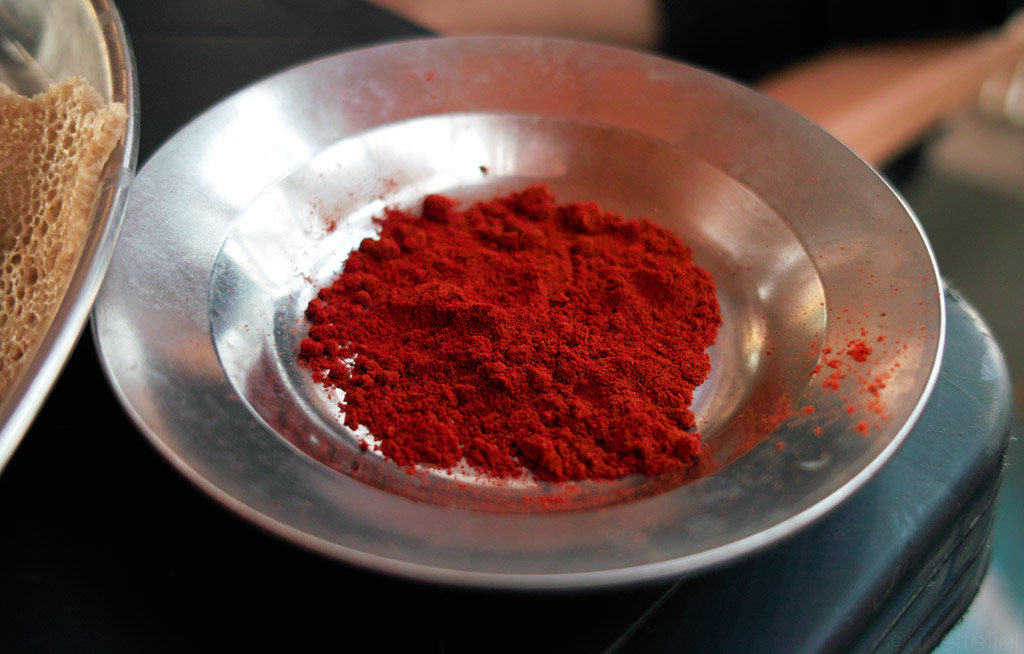
Berbere - a mix of sixteen or so spices.
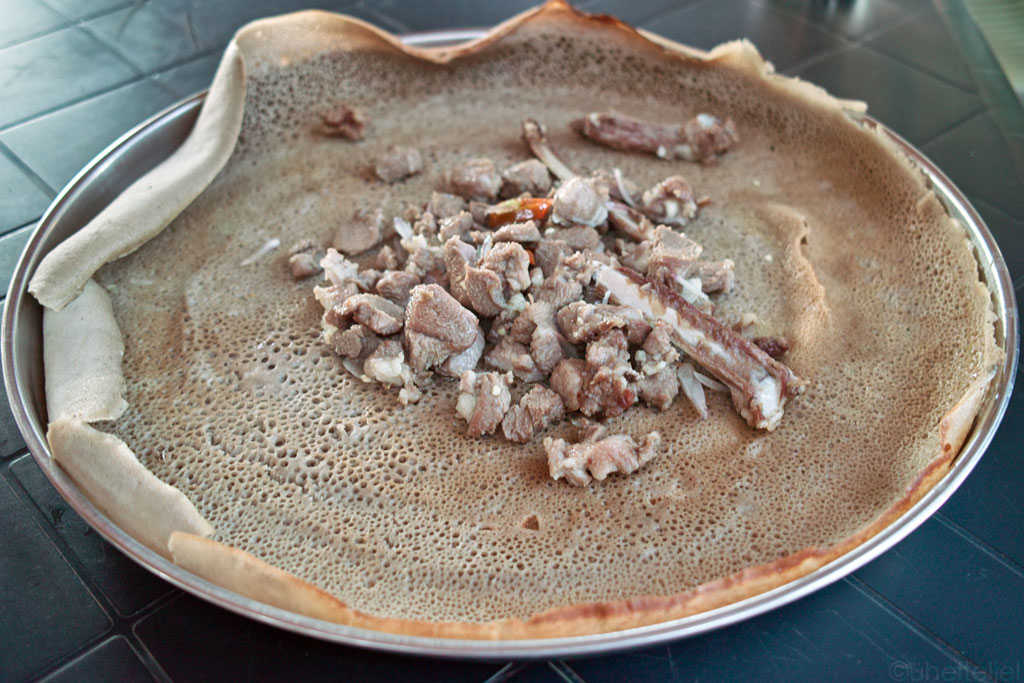
Injera with goat meat.
We left with a good vibe, and the smooth tarmac was singing under the tyres. Then the mountains began, and the road - now gravel - started winding its way up the slopes. Compared to the arid landscapes of the North-East, it was a different world with lots of green and fields spanning as far as the eye could see. Only 15 years ago a huge famine took around a million lives in Ethiopia.
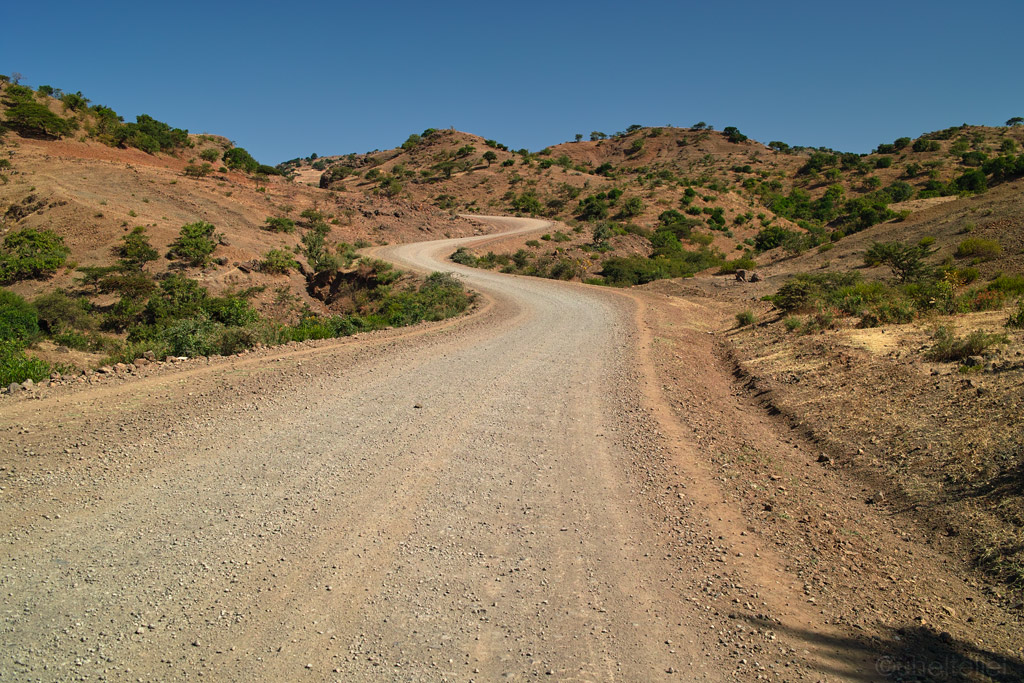
Some roads are very good quality!
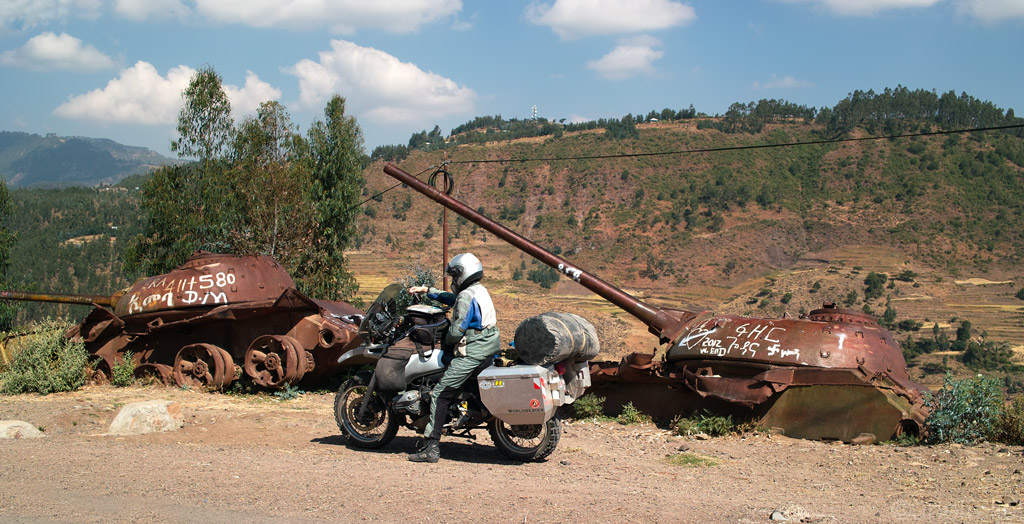
Abandoned tanks - leftover from recent war with Eritrea.
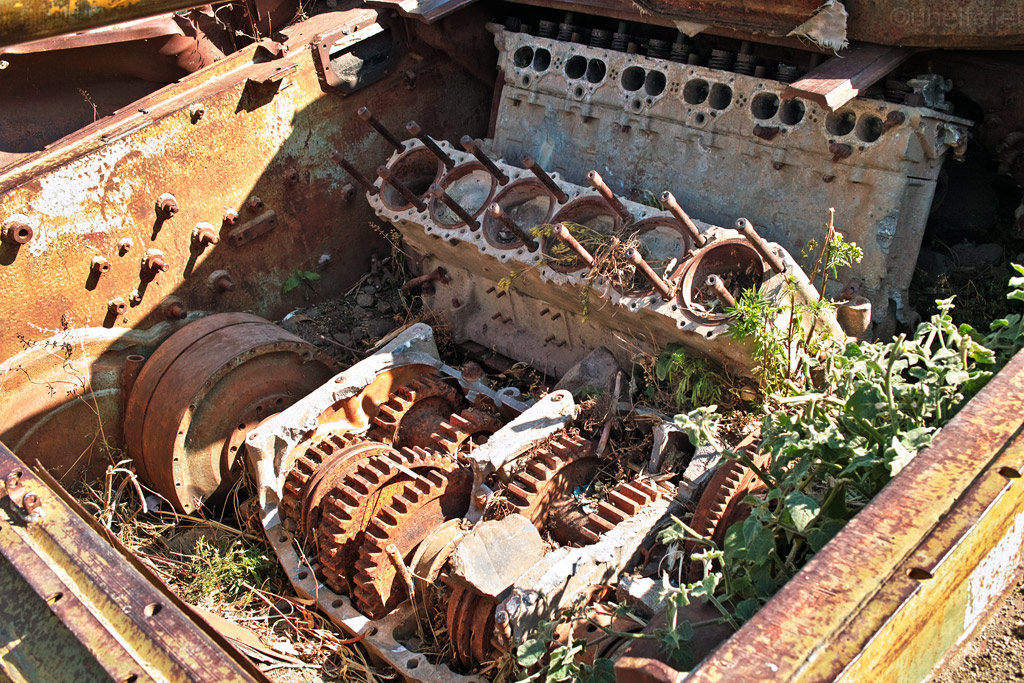
V12 engine with a decent gearbox in one of the tanks.
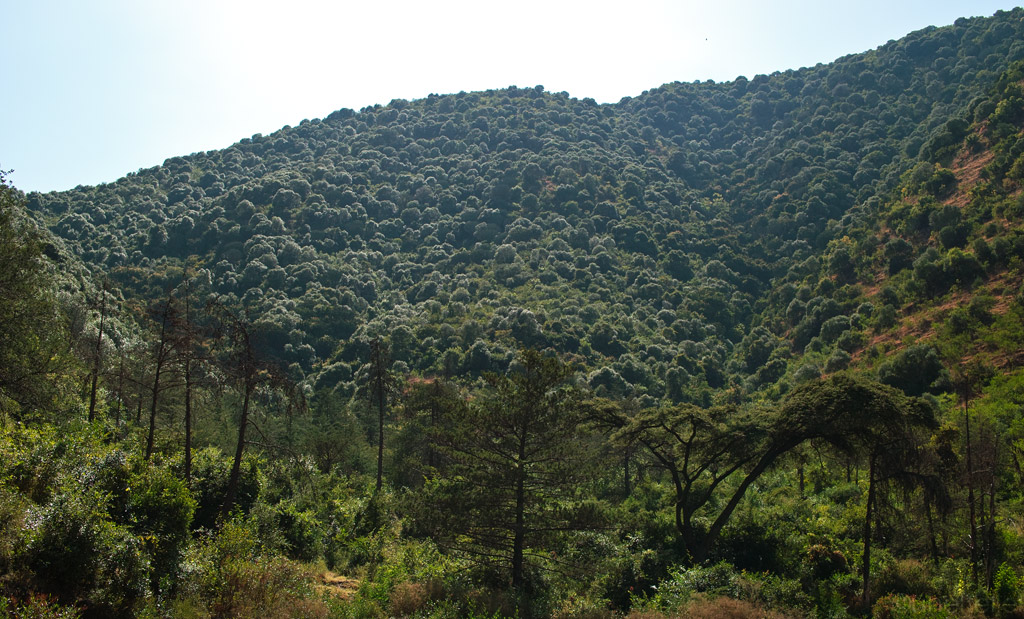
There's loads of green in Ethiopia.
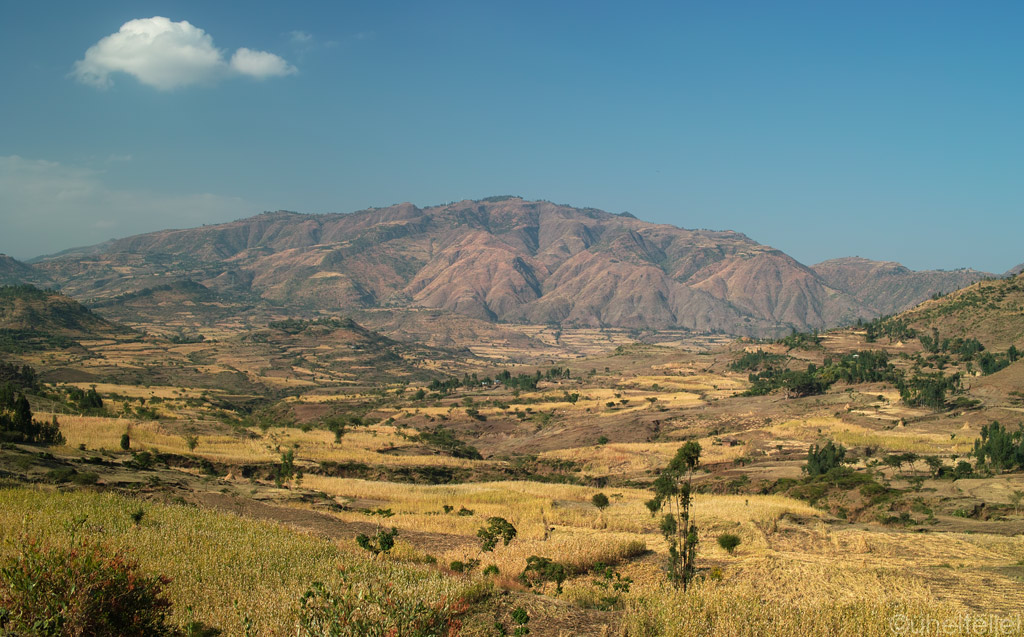
Landscape.
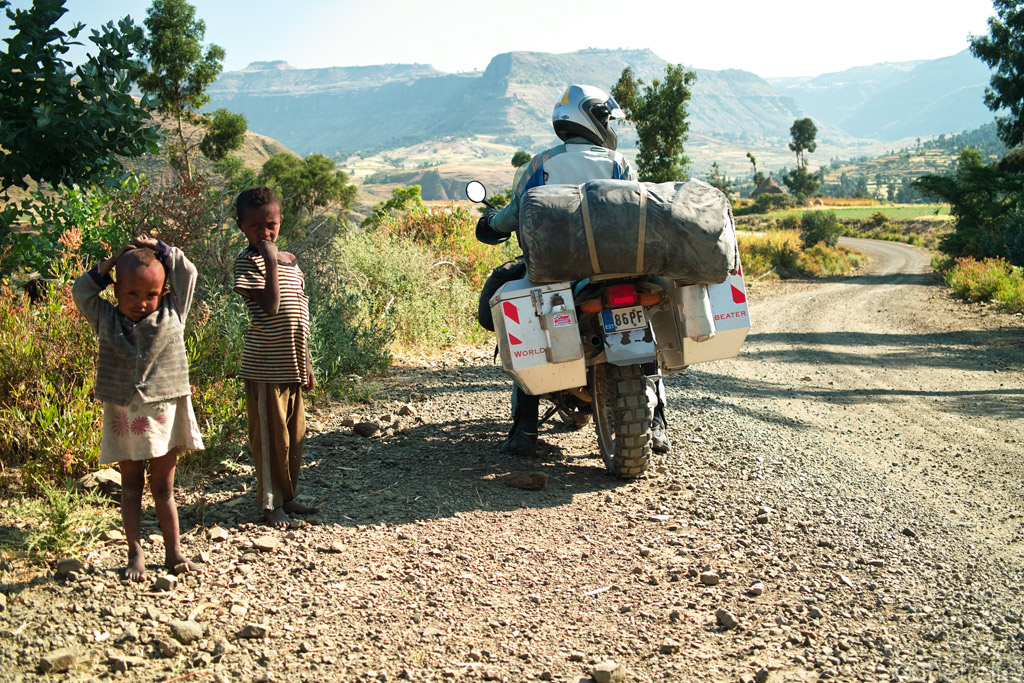
On the road.

Panorama of East-Ethiopian landscapes (click to enlarge each one)





In the mountains, the architecture is quite remarkable with thatched villages resembling something out of a fairy tale.
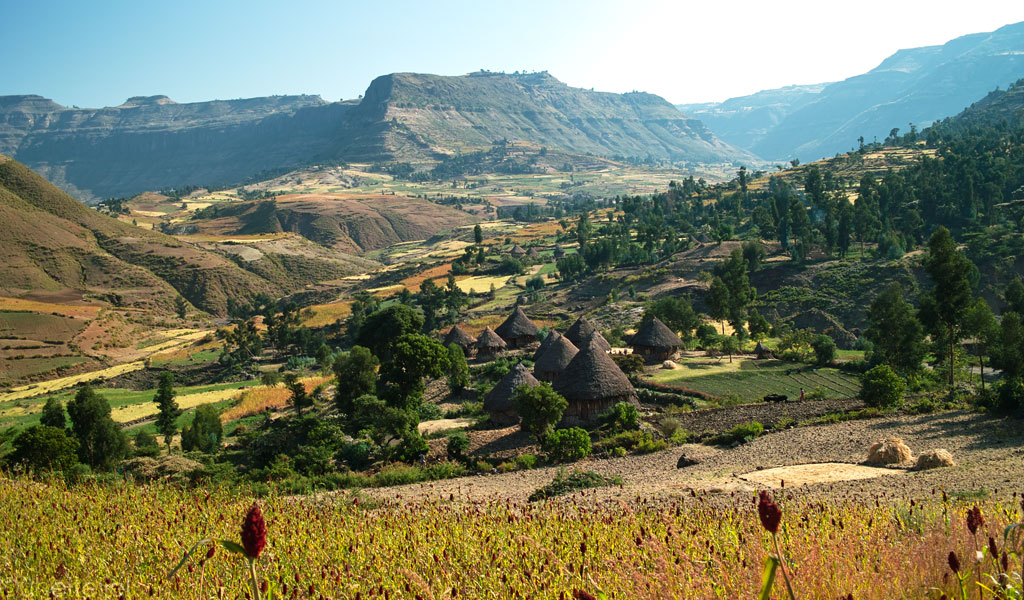
The farirytale land of Ethiopia.
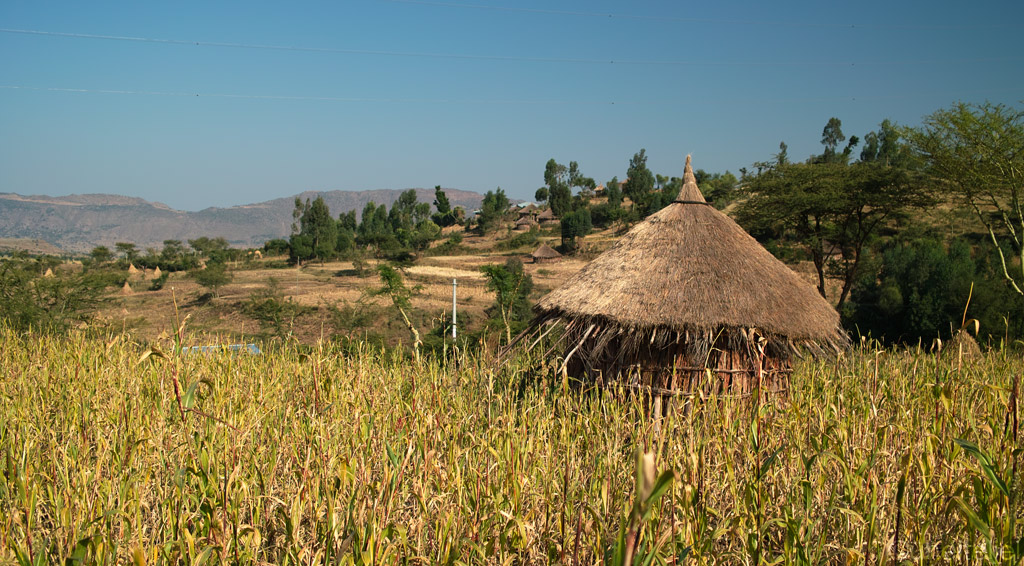
Ethiopian huts blend well with the surrounding environment.
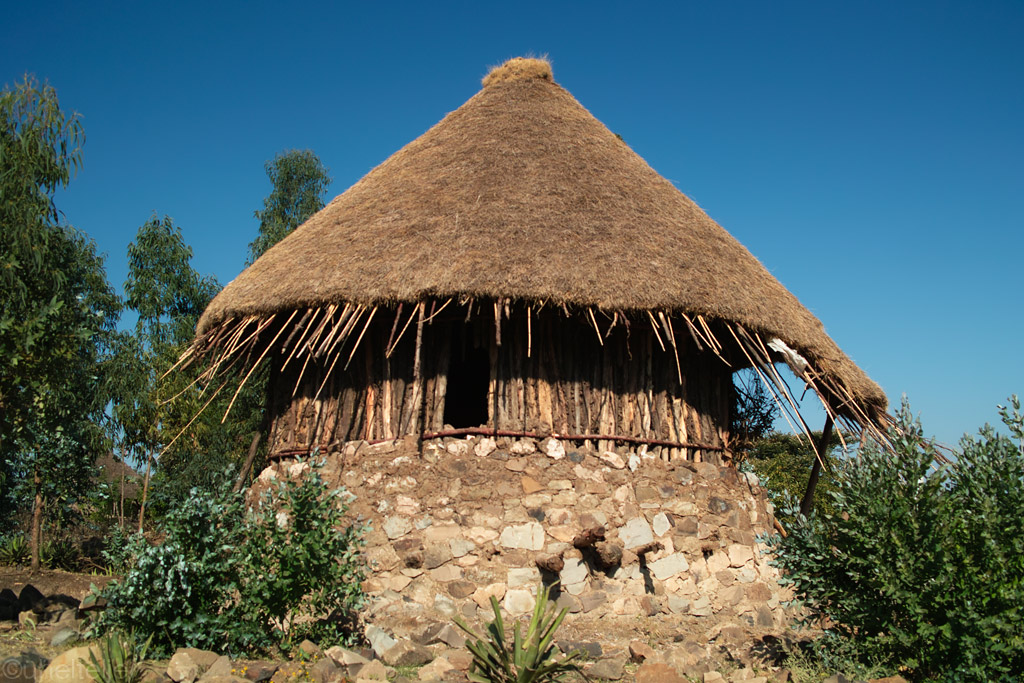
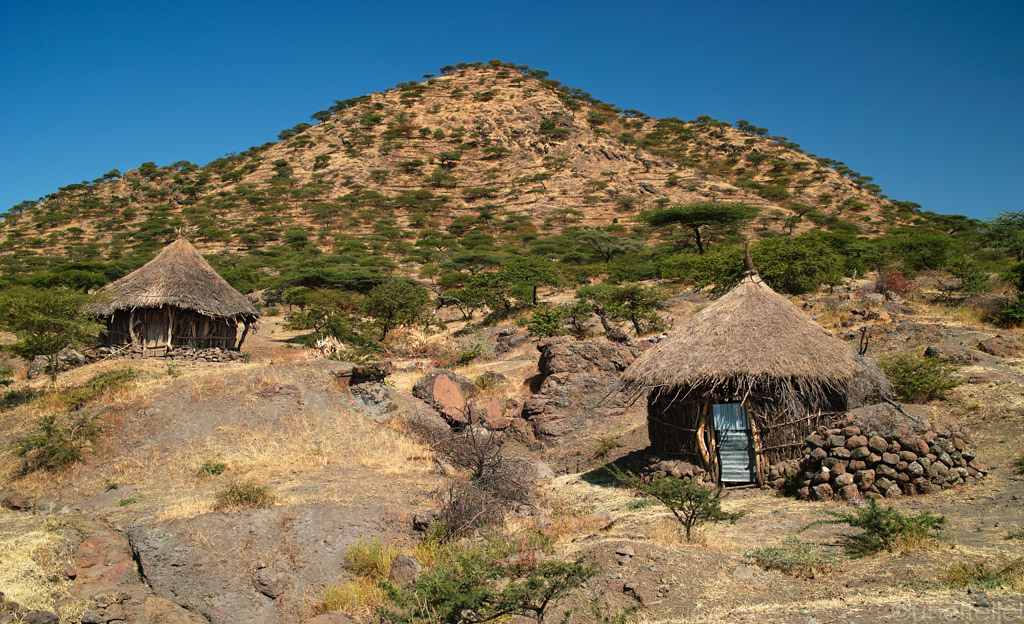
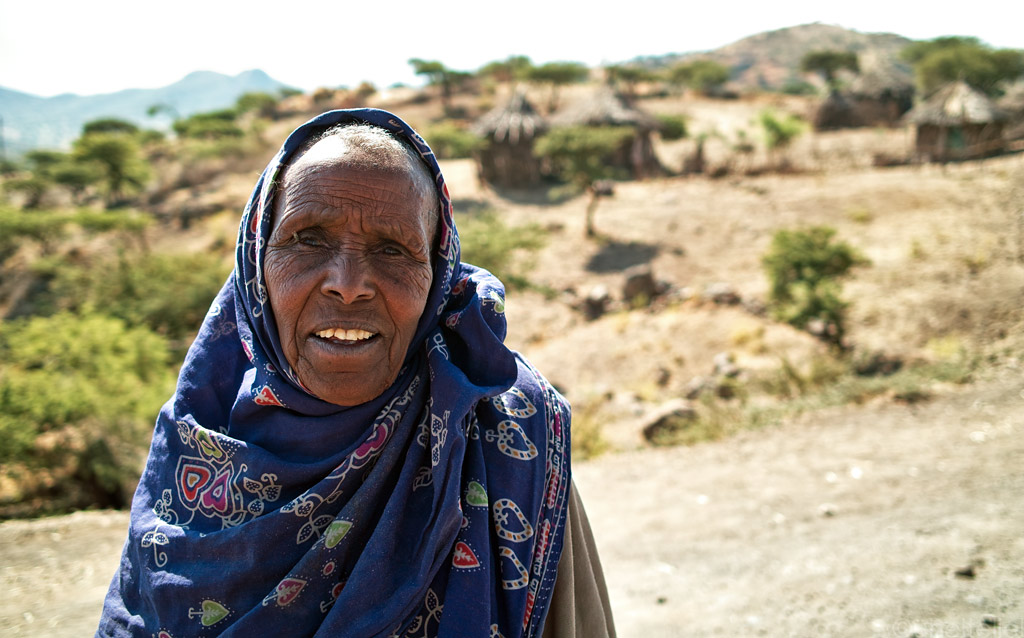
Ethiopian woman in front of her village
The road kept ascending and the air became colder and colder with every hundred meters. Would not have thought we could be freezing in Africa, but that was exactly what we were doing. The people were wrapping themselves up in whatever piece of cloth they could find.
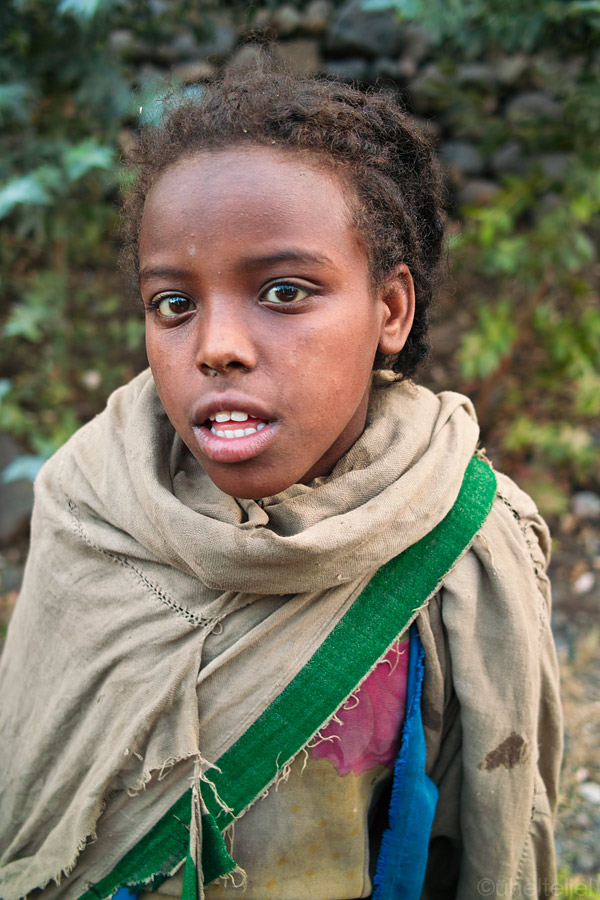
Portrait of Ethiopian girl.
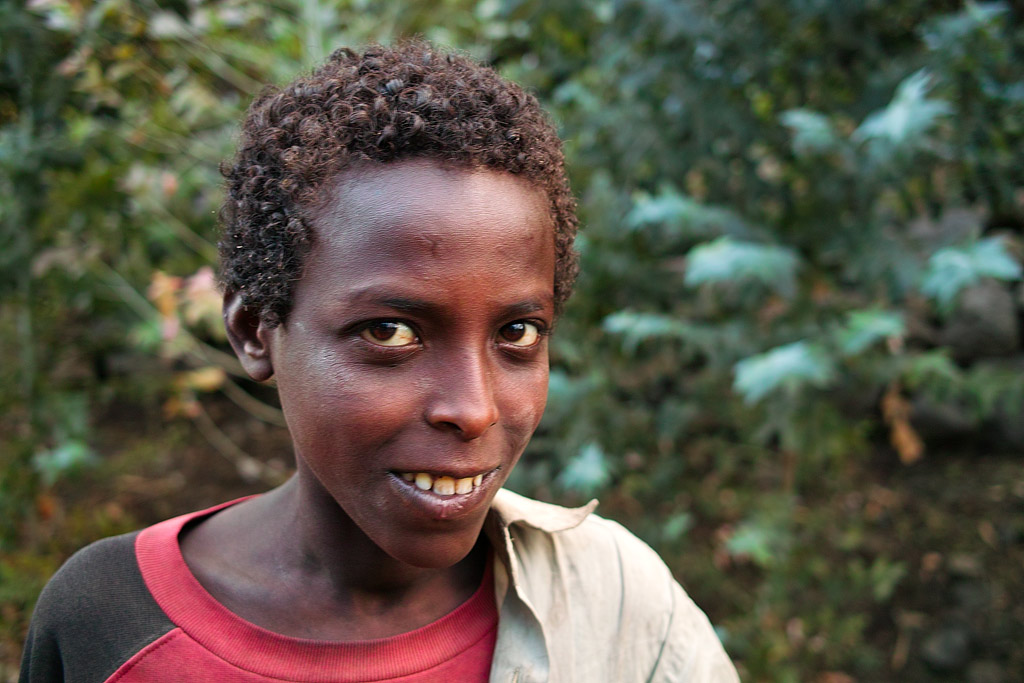
Young man.
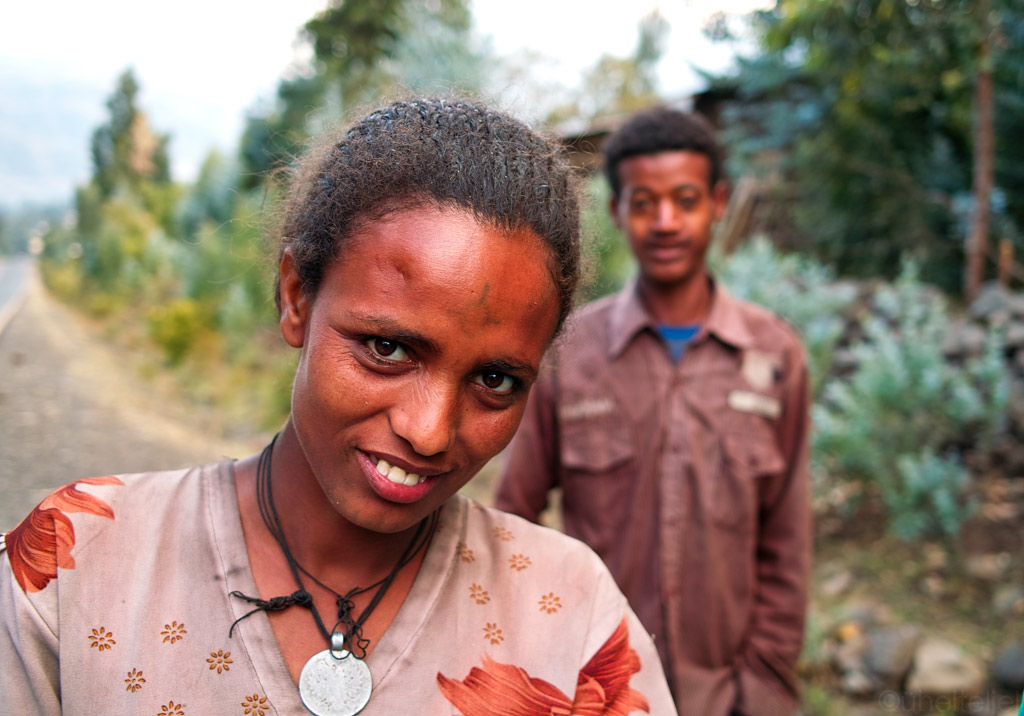
Christian woman - cross on the forehead and drawings under the chin are religious tattoos.
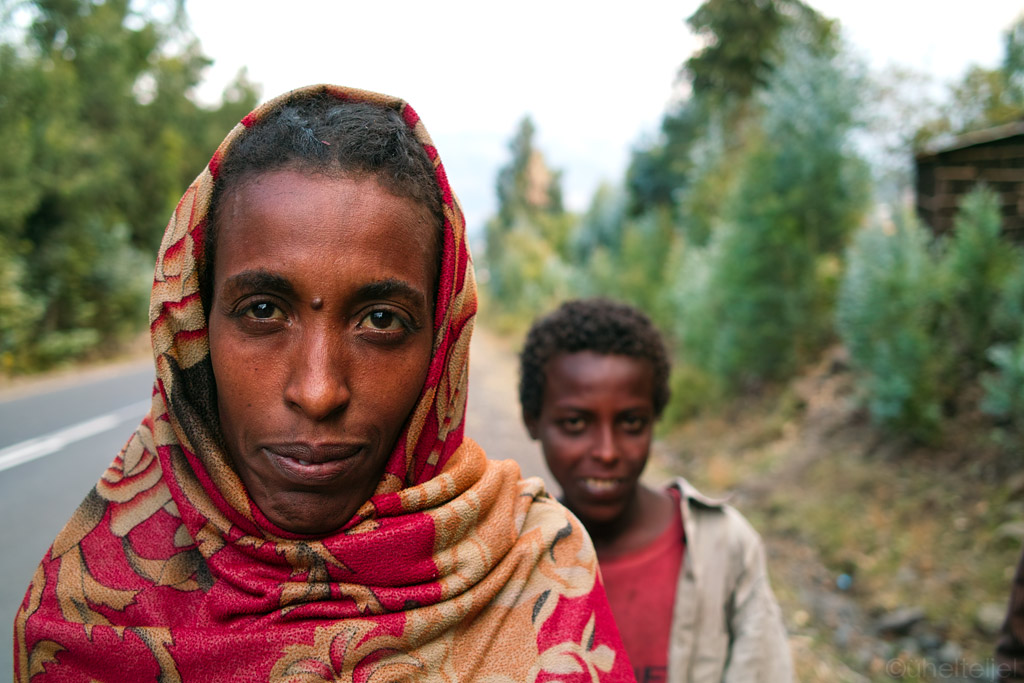
Woman.
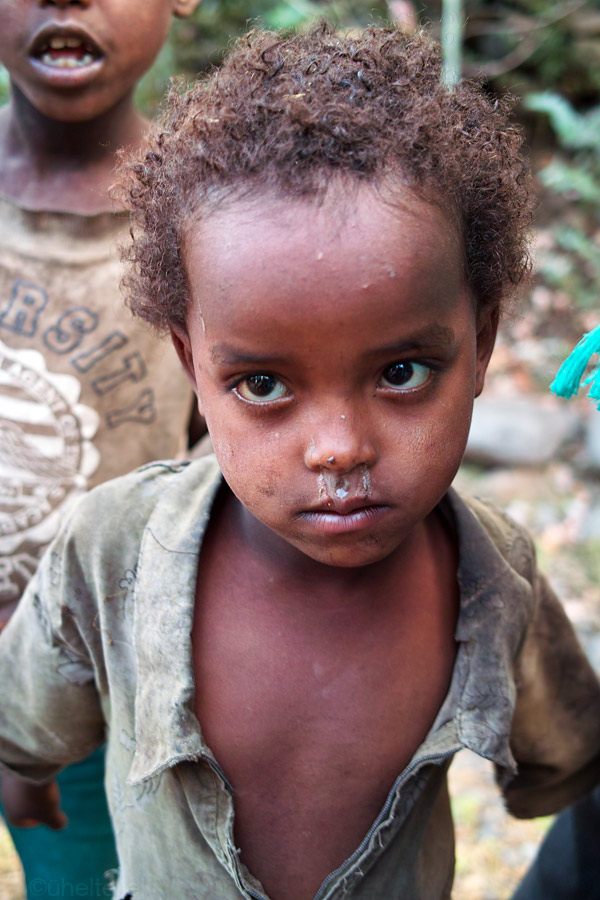
Children.
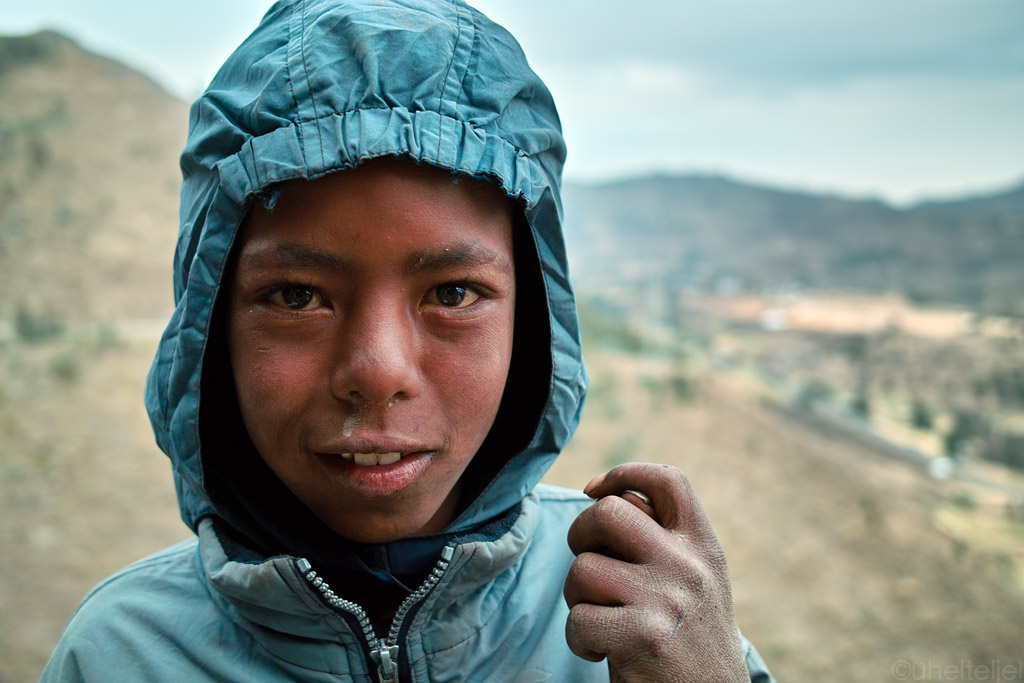
Young shepherd fighting with cold and rain in high Ethiopia (3500 meters above sealevel)
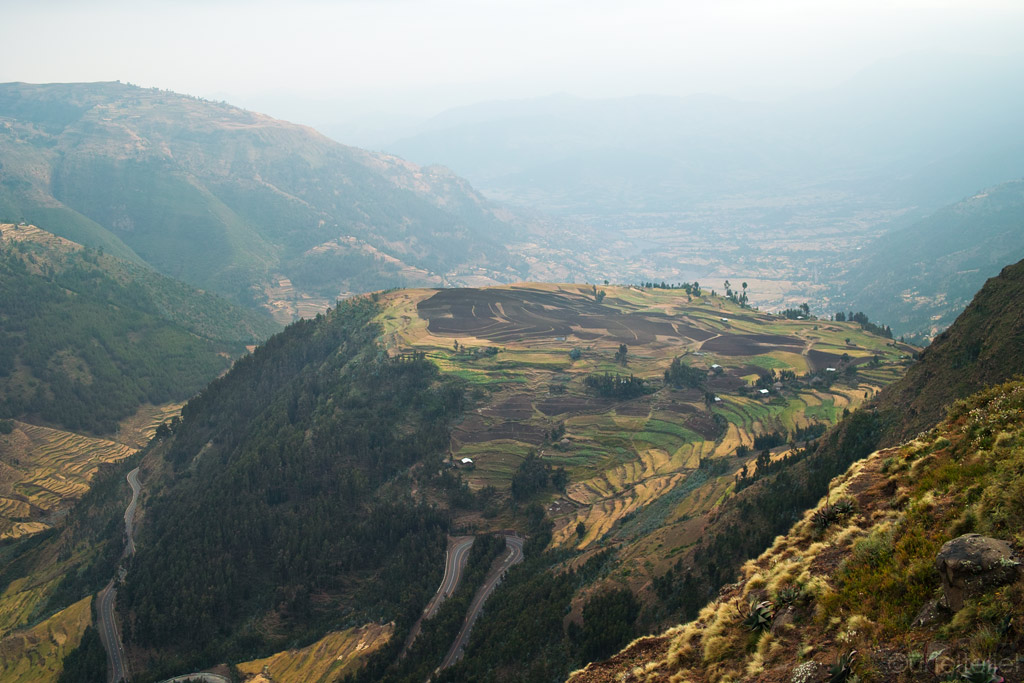
View from 3500 meters (11 400 ft)
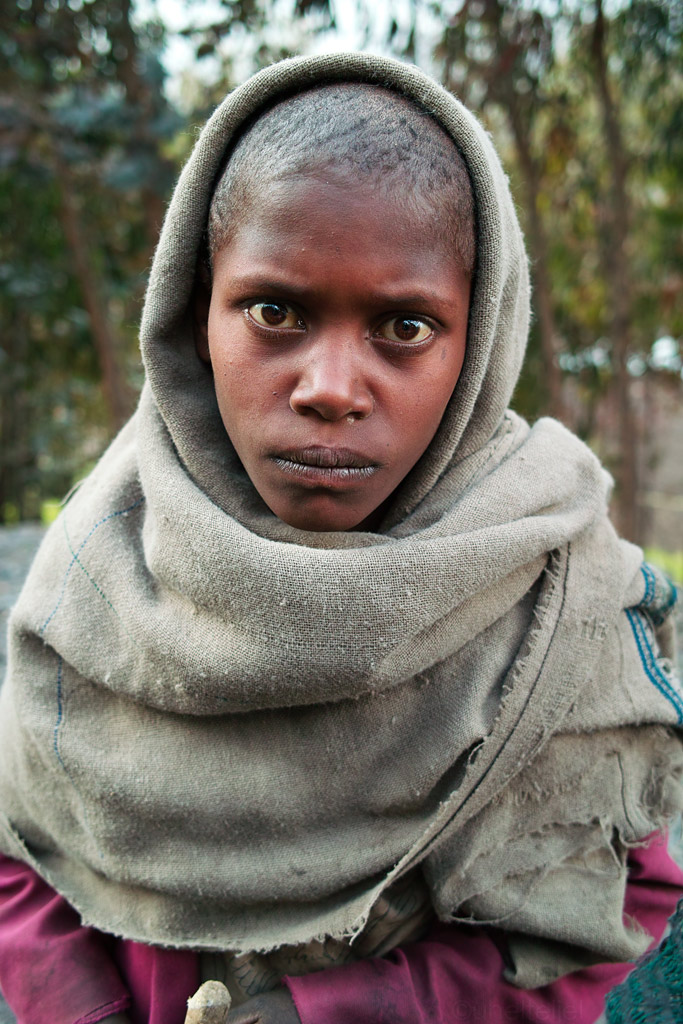
Portrait of a local.
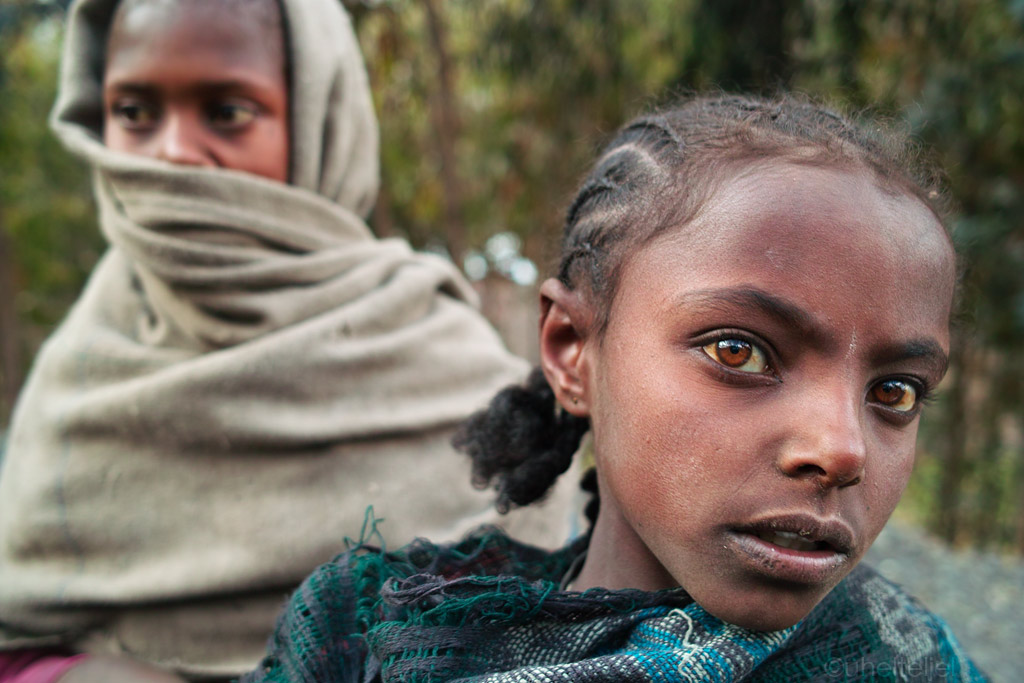
Portrait of a girl with stunning eyes and looks.
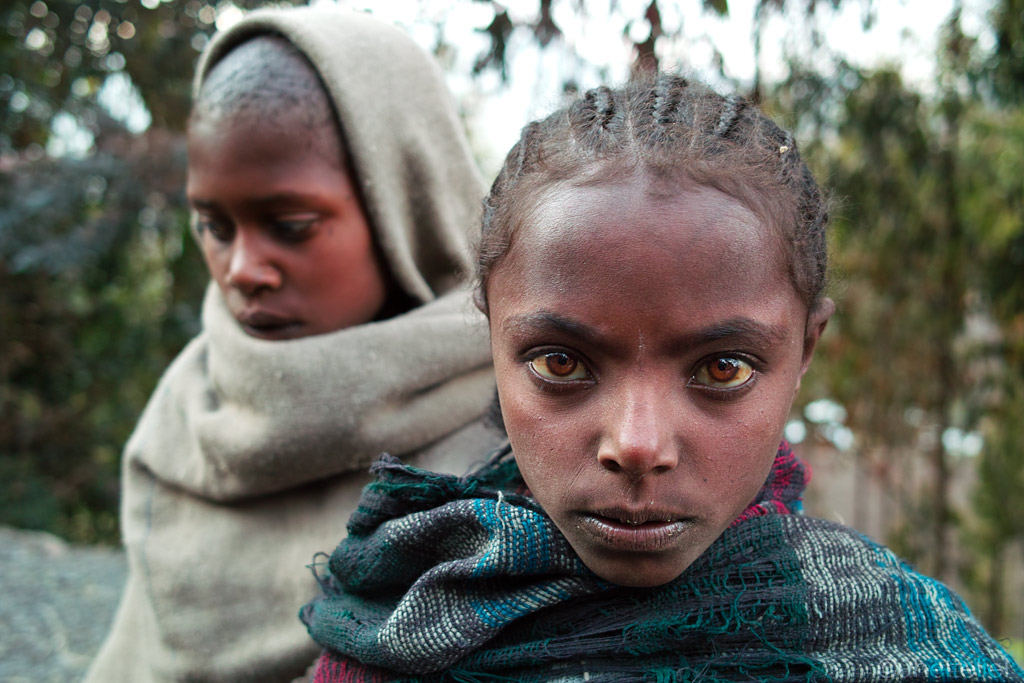
With that look, she could probably be a model in the Western world.
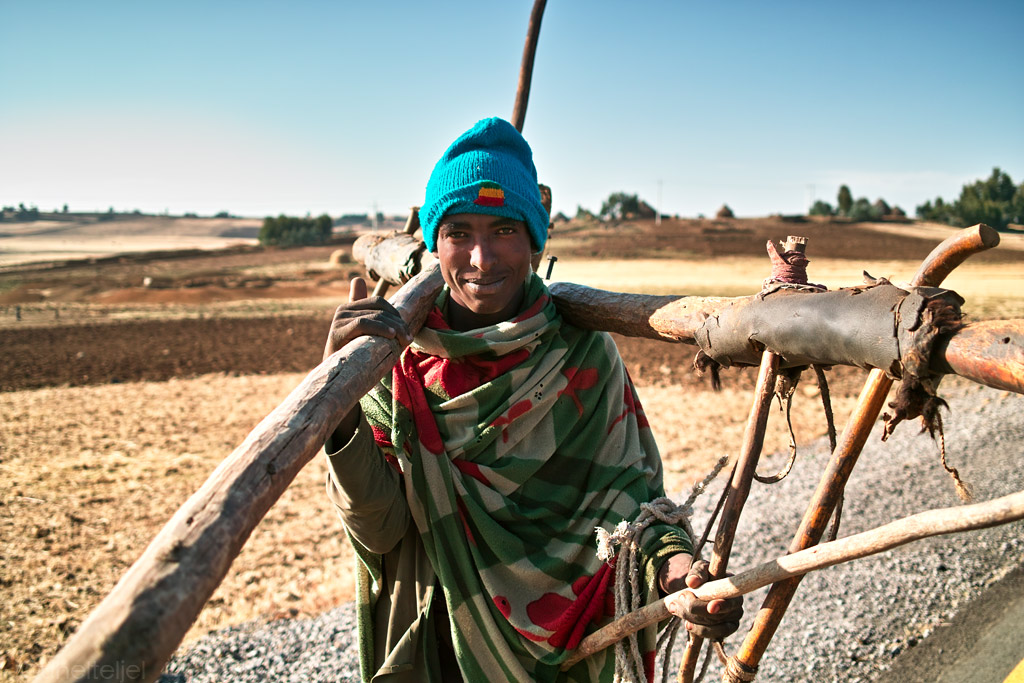
Farmer bringing tools to his field - all is whether man- or bull-power.
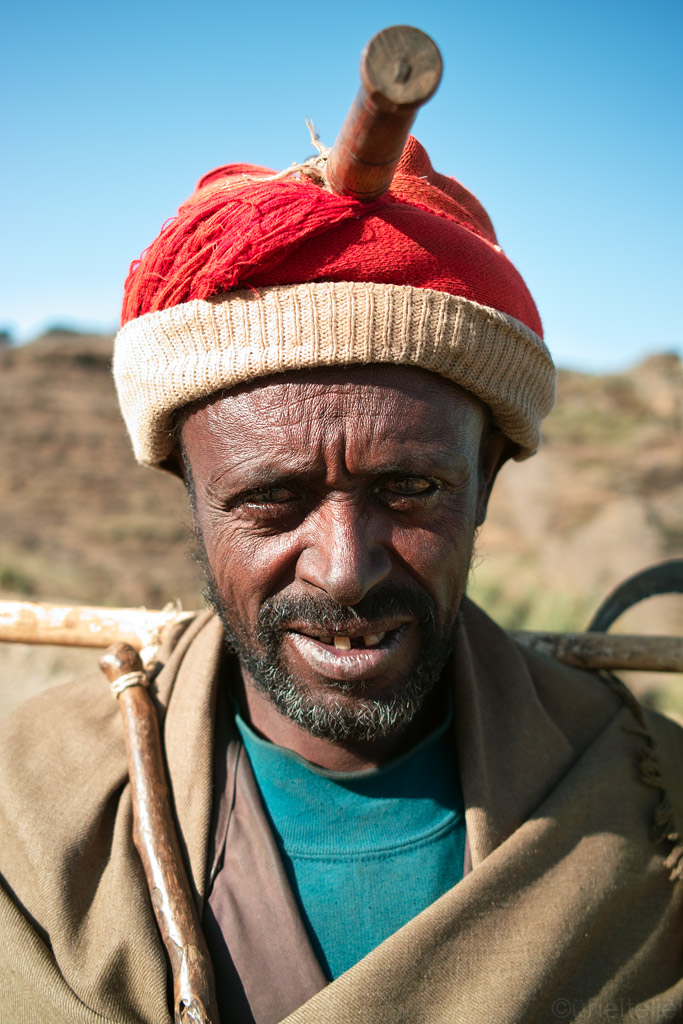
Ethiopian farmer with tools attached to his body.
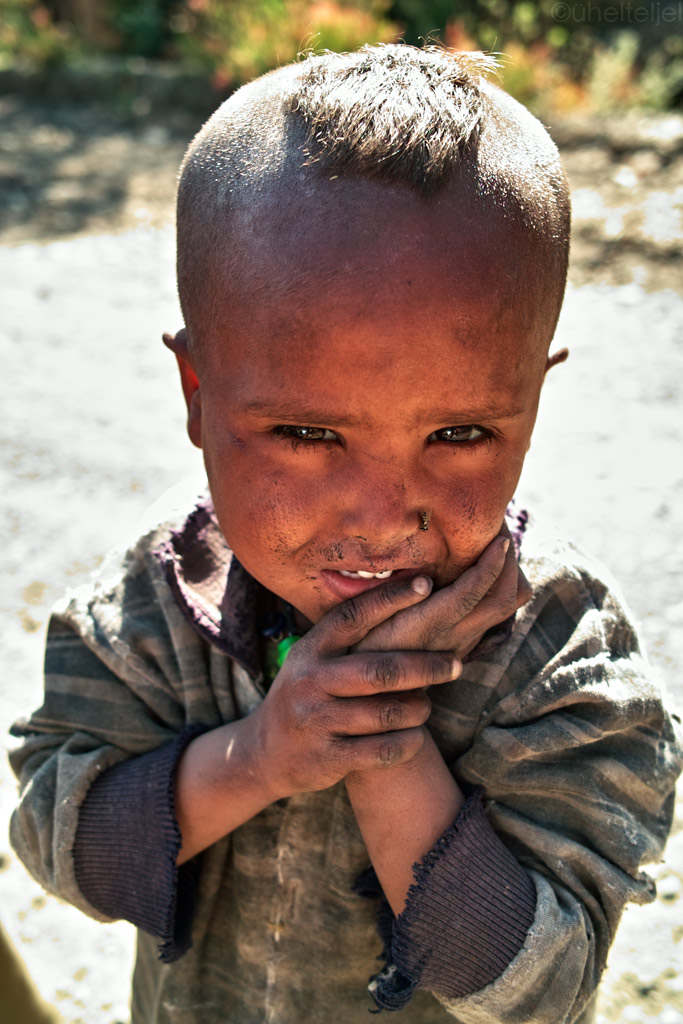
A child.
Then, just before the sun began to really set, we crossed a 3500 meter pass (have we somehow wandered back to the Himalayas???) and found ourselves on a high plateau. The air was oh-so-crisp and the landscapes painted in sunset shades and colours were truly mesmerising.
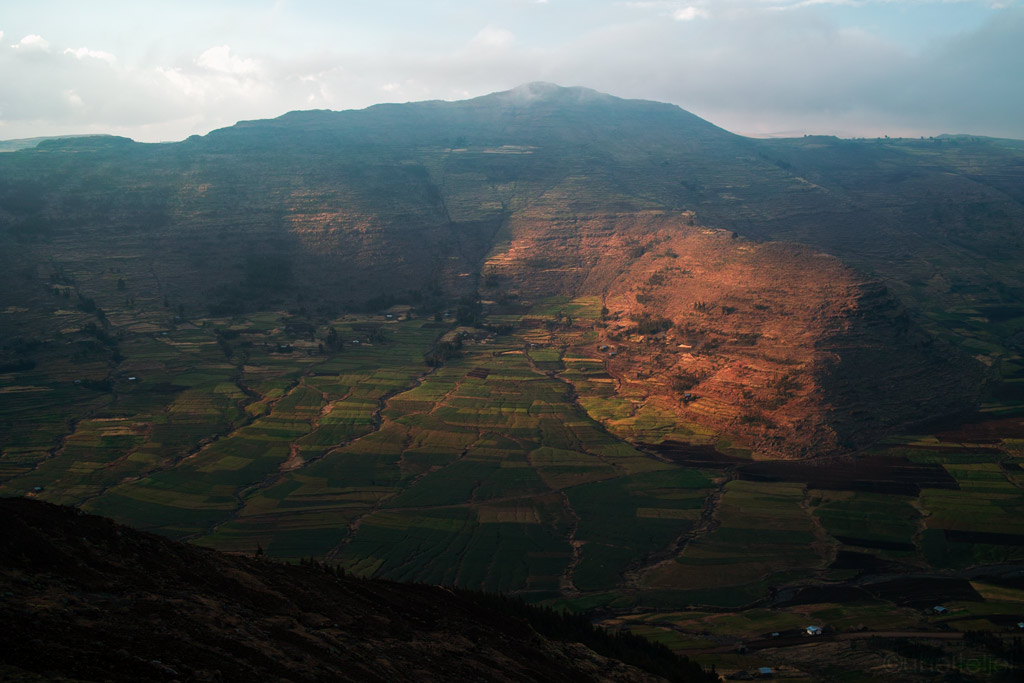
Light play seen from the high Ethiopian plateau.
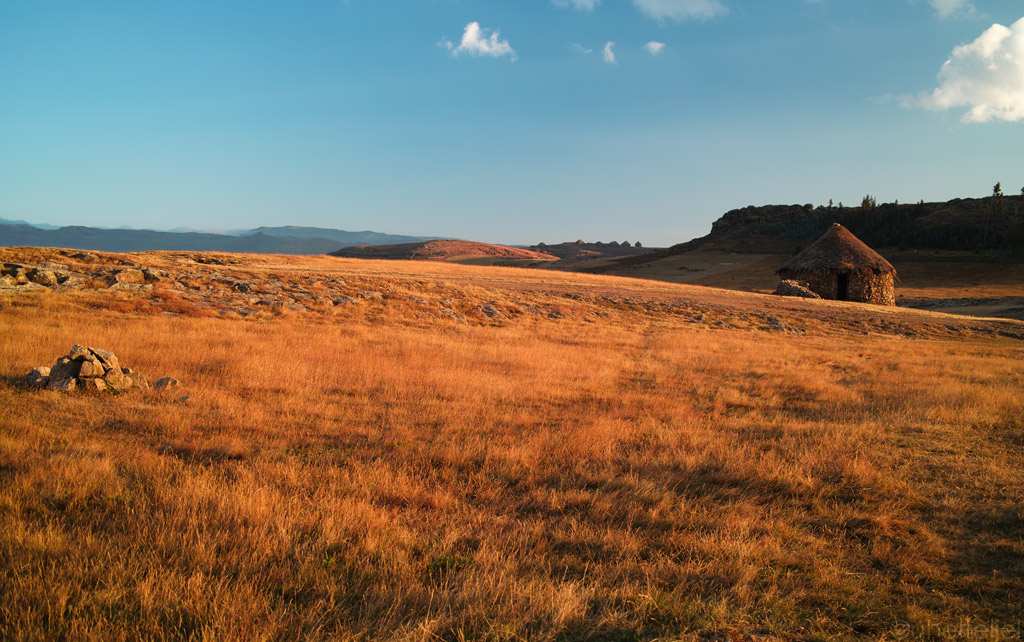
Farmer's field and house on the plateau.
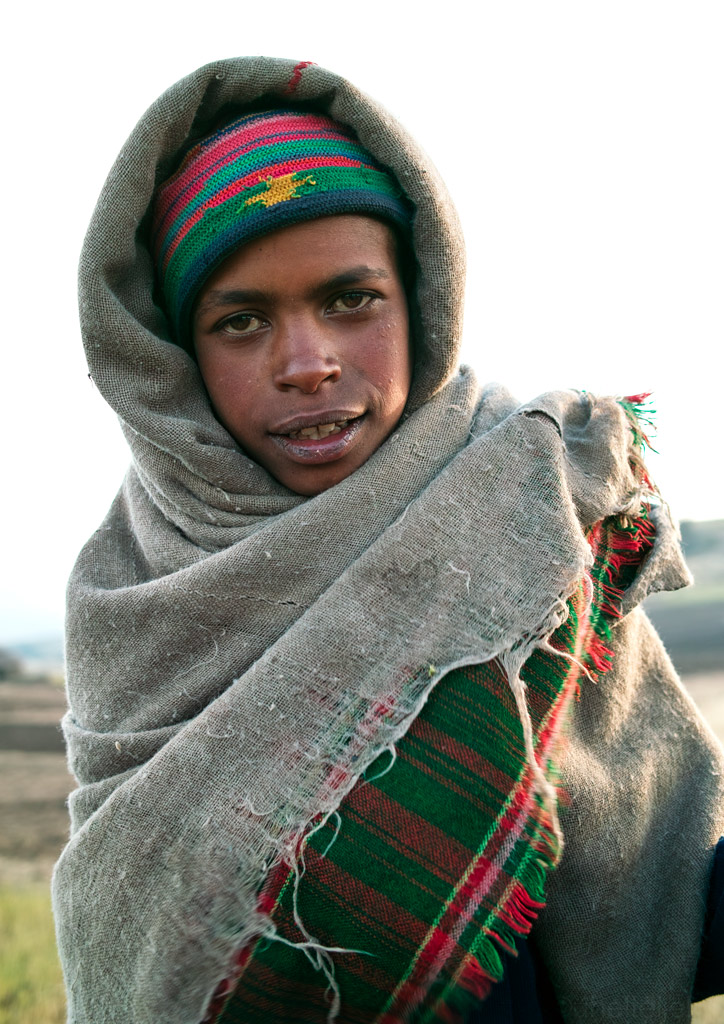
Covered up for the cold.
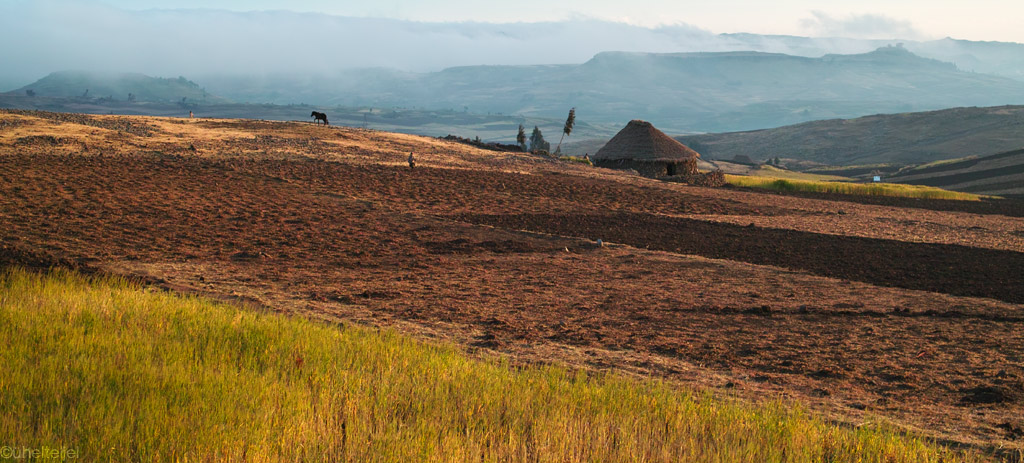
Fields as far as an eye can see...
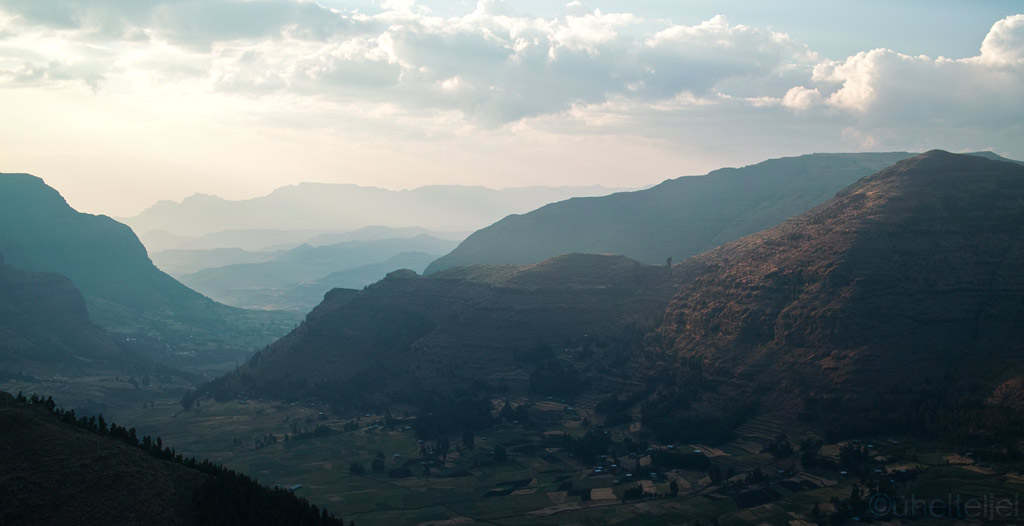
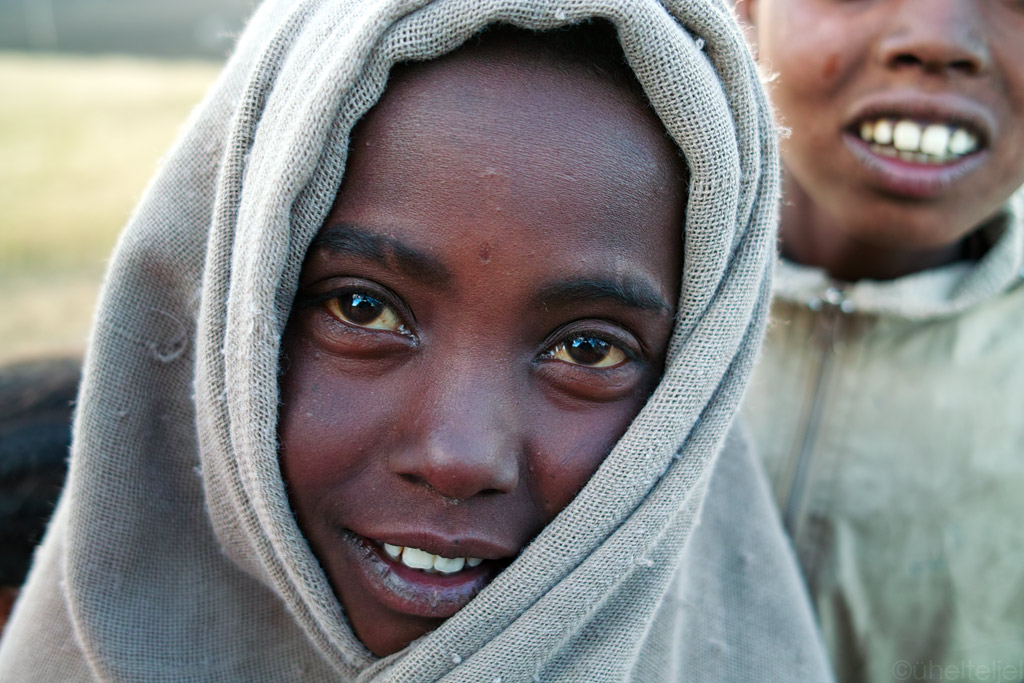
Portrait of a local girl.
We would have liked to camp, but the area was all just villages and cultivated fields so we stopped at the first house with a sign "Hotel" on it. The room was dark and dank, and the dry loo was somewhere fifty meters away, but hey, what do you expect for $ 1.20? The family cooked us some very simple food and some hot tea, so we actually could stop shivering before going to bed.
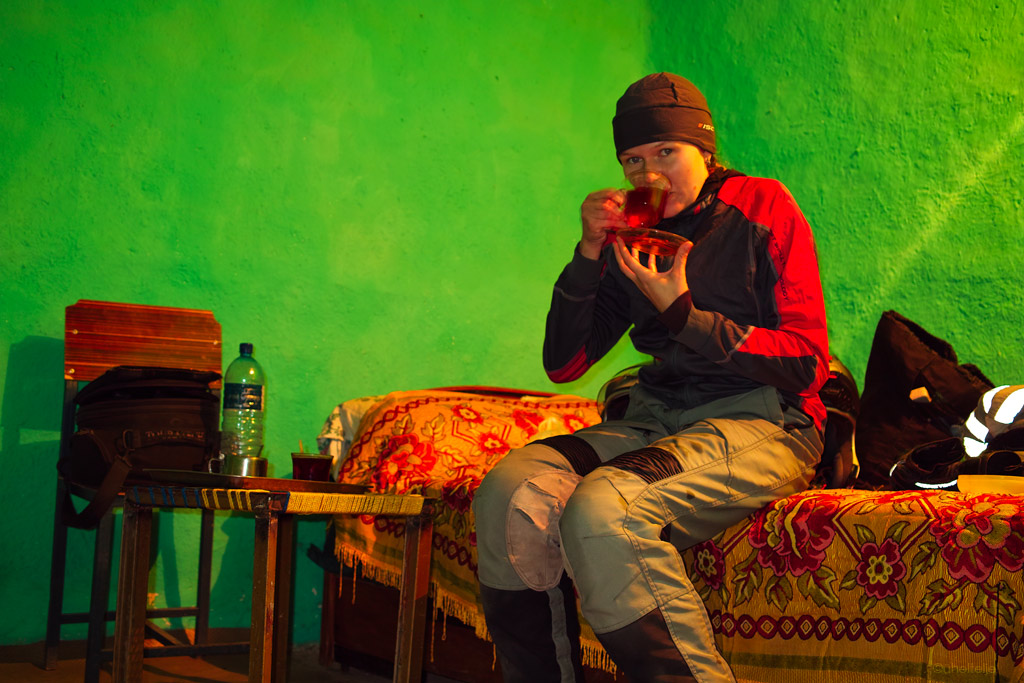
Who said Africa is hot? Flippin' shivering cold it is! A cup of hot tea helps tho.
Strange as it is, we had never seen people so devoted to Christian practices than here in Africa. Christianity, which only arrived in Ethiopia in the 4th century, is the faith of some half of the country's population - thus it is no wonder one can see white robed pilgrims, holding open umbrellas above their heads, walking to some important site (obviously there are many of them), and every now and then some cross or church protrudes the horizon.
But the most remarkable churches in Ethiopia are not those very high or colourful, but those buried in the ground. In Lalibela, one of the most important pilgrimage sites in Ethiopia, a cluster of churces was built in the 12th to the 13th centuries. What is striking is that they were actually not built but hewn into the rock, making them true masterpieces, confirming once again that faith can inspire people t do great things.
Lalibela in itself is nothing more than a village, but it holds an amazing 11 churches. The most famous of them, the one dedicated to St George (Bet Giyorgis) looks as symmetrical and perfect as if it were stamped onto the ground by some heavenly force.
But as the most important figure here in Ethiopia is the Virgin Mary, most pilgrims congregate around Bet Maryam, the church dedicated to her. There is a lot of action going on around there, with someone preaching, someone reading the Holy Bible, and someone singing a praise to the God.
We happened to hear a song which, enriched with some percussion instruments unknown in the churches in Europe, sounded interesting.
..:: LISTEN ::..
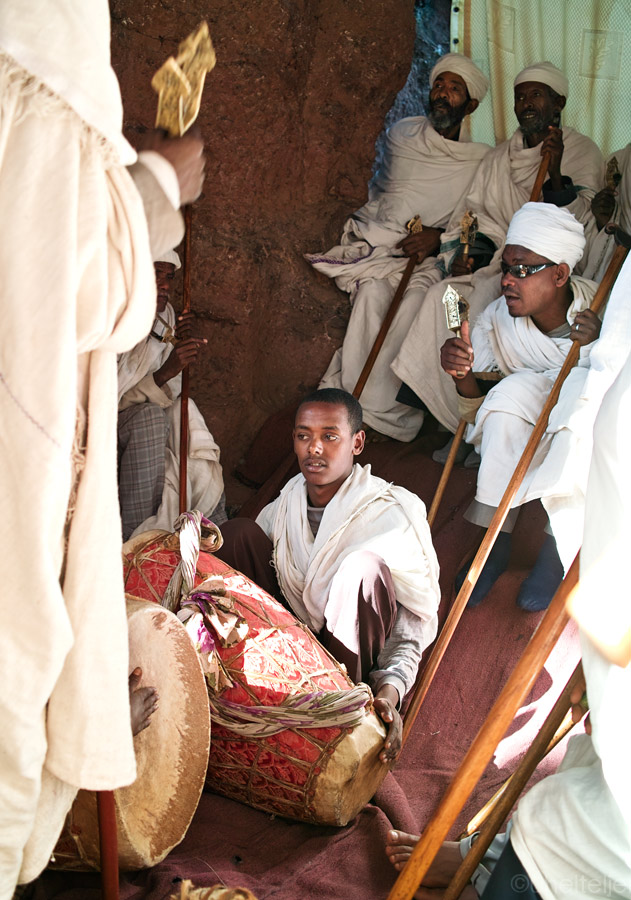
Pilgrims playing drum and singing devotional songs.
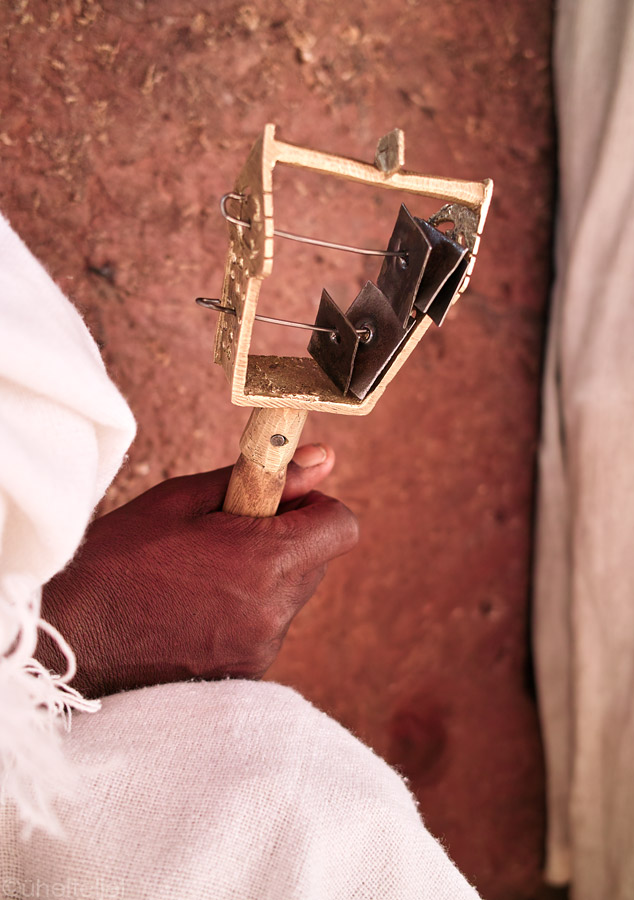
Religiously decorated shaker to make rhythmic sounds.
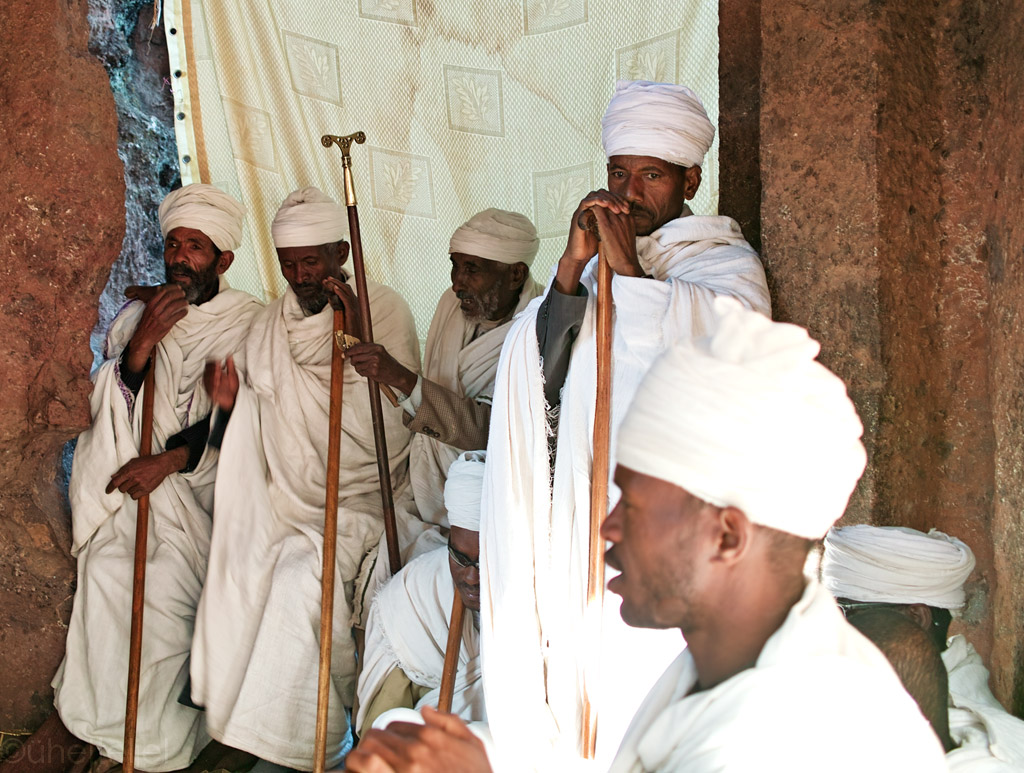
Men of faith.
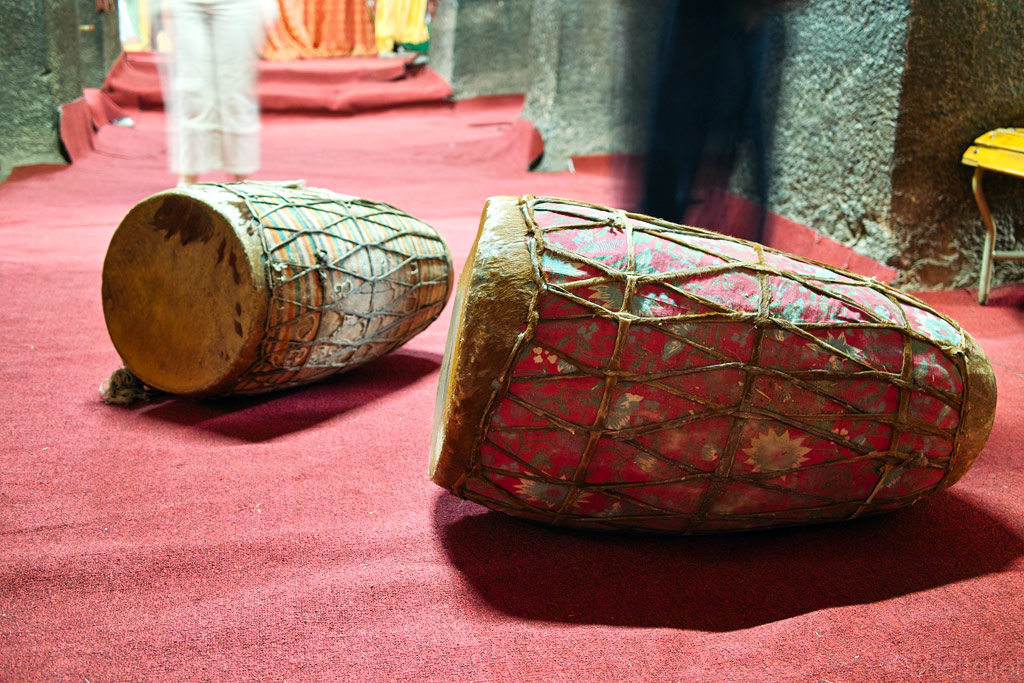
Drums on the church floor.
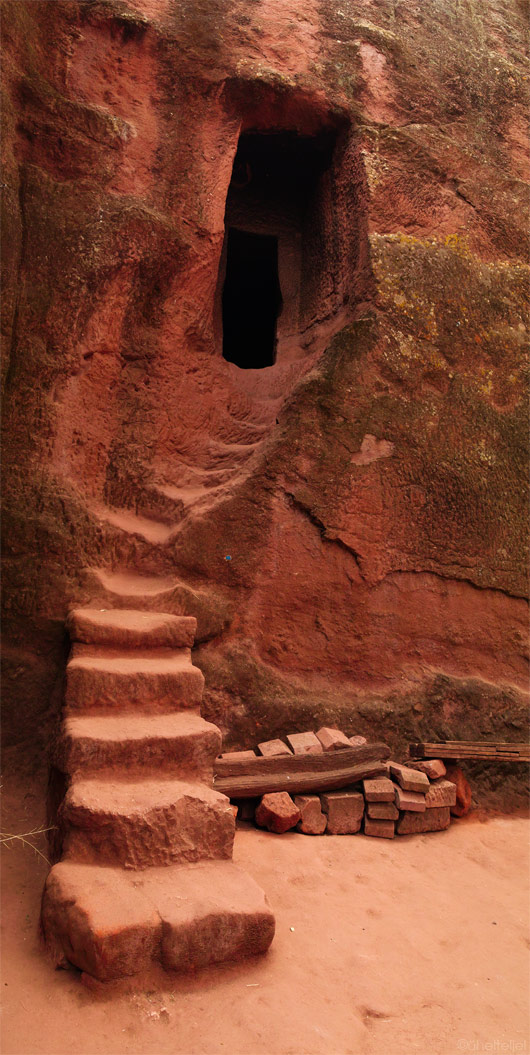
Entrance to one of the churches hewn into cliff.
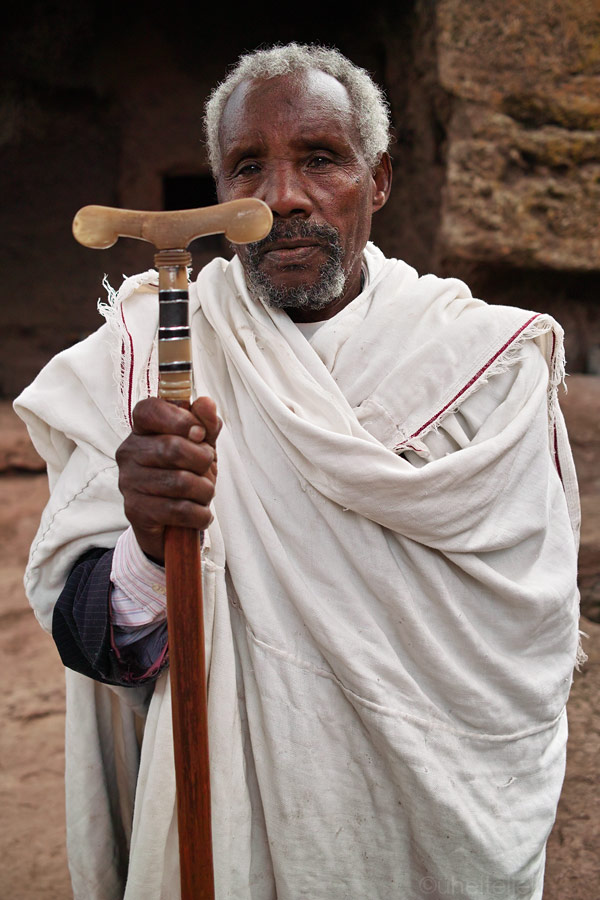
Christian pilgrim.
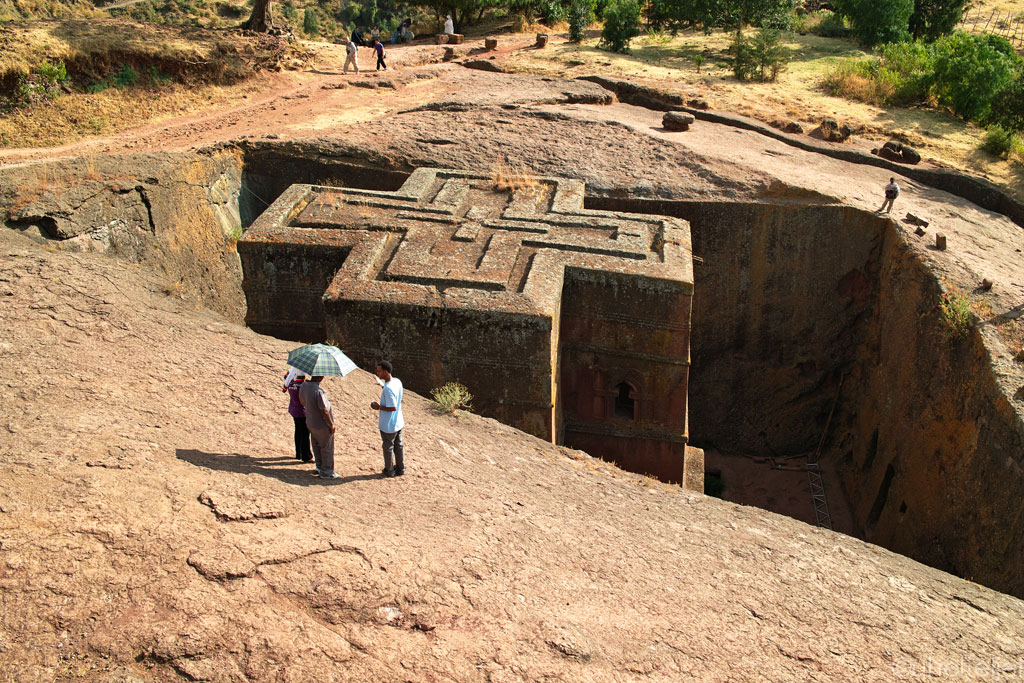
Bet Giyorgis church - hewn itno the rock - stunning piece of work!
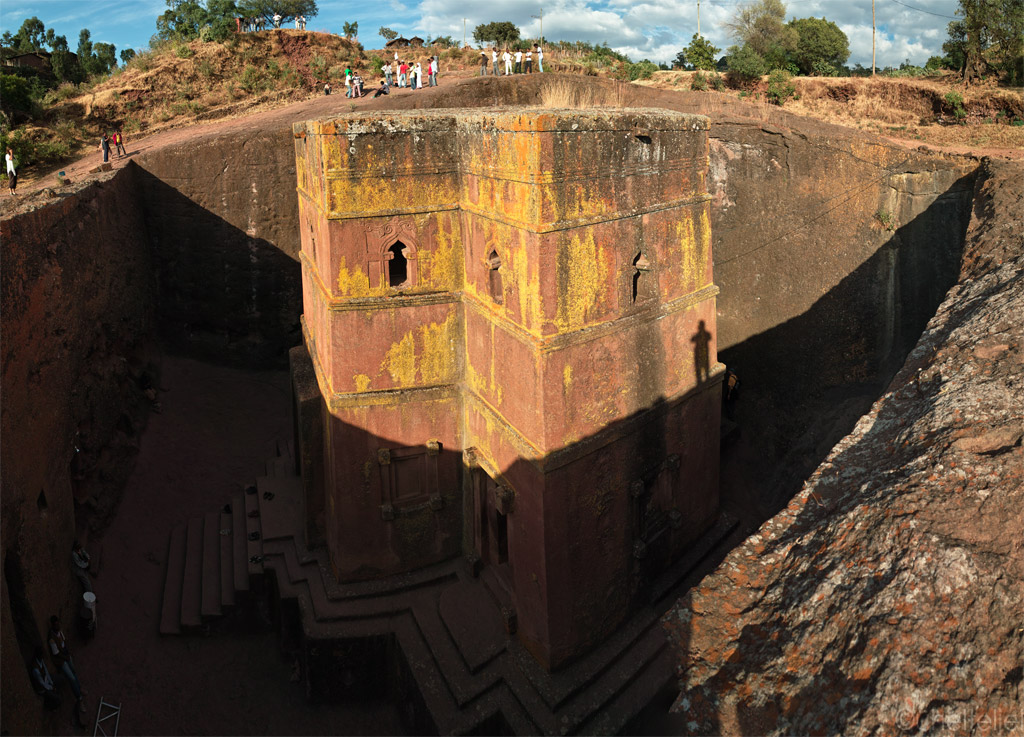
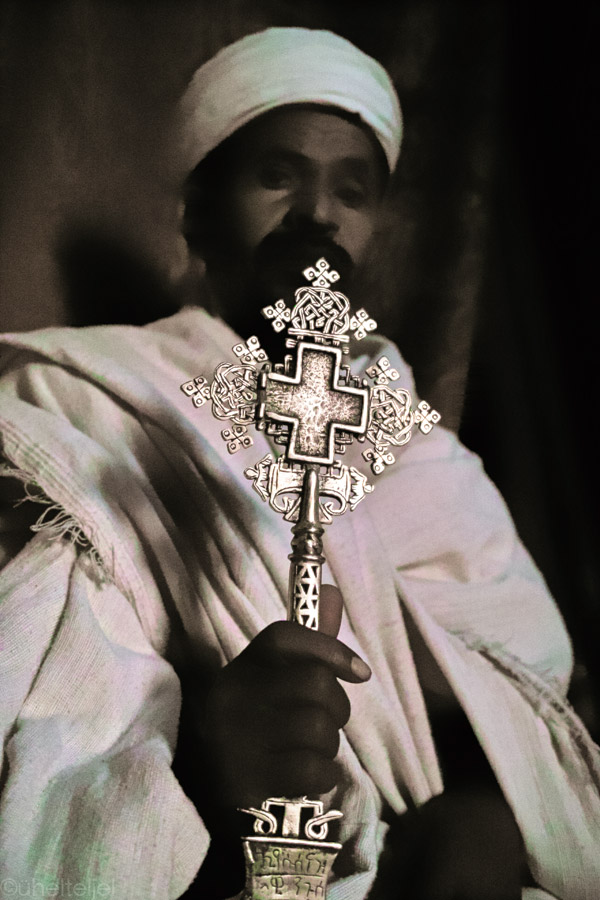
Priest with his precious cross in a dimly lit church.
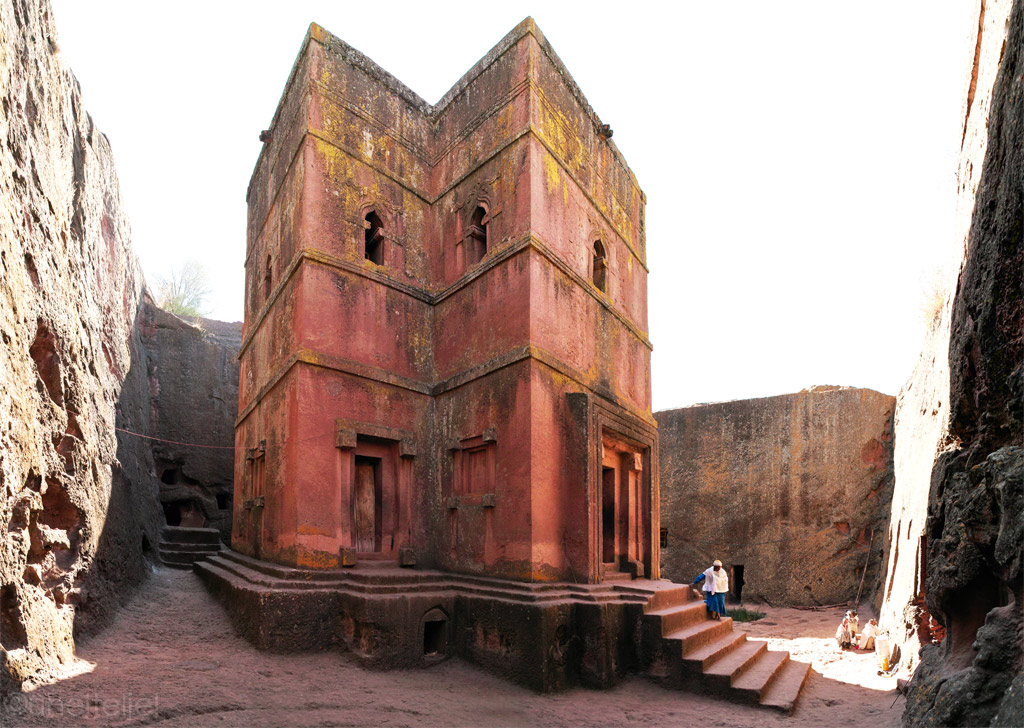
The same church from below the ground.

With pilgrim.
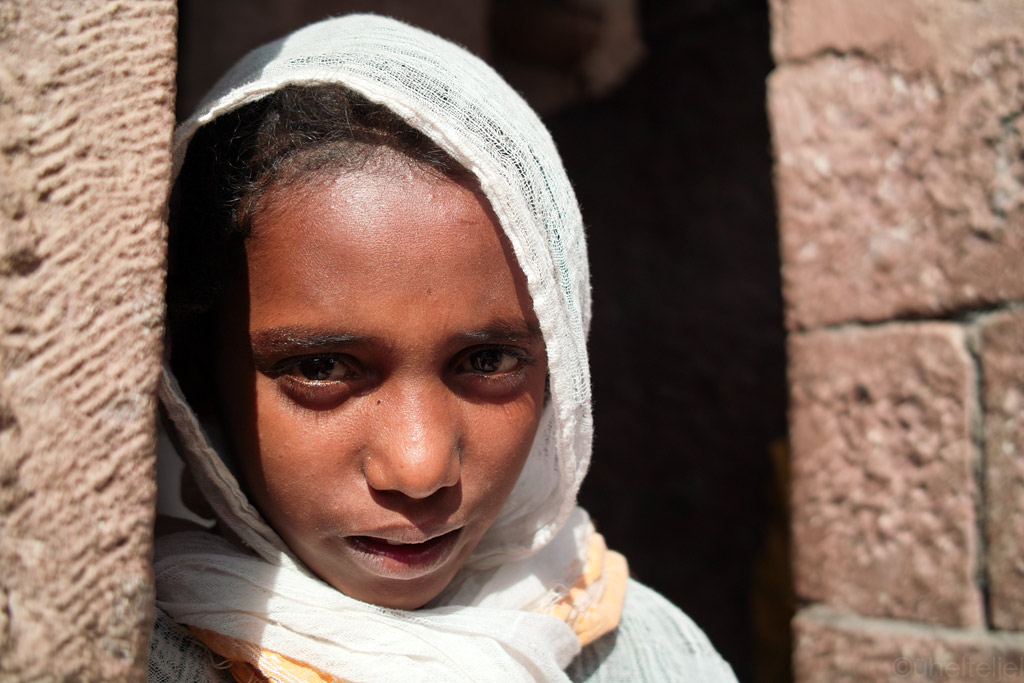
Young girl waiting for her turn at the church door.
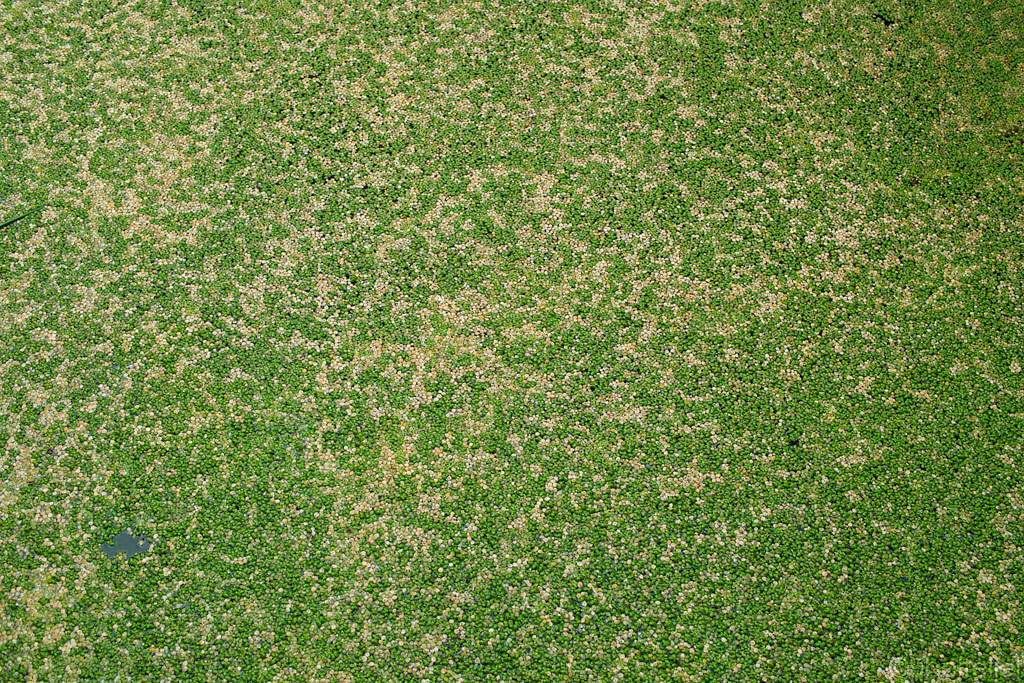
Holy water is filled with life in the pool just aside the Bet Maryam church.
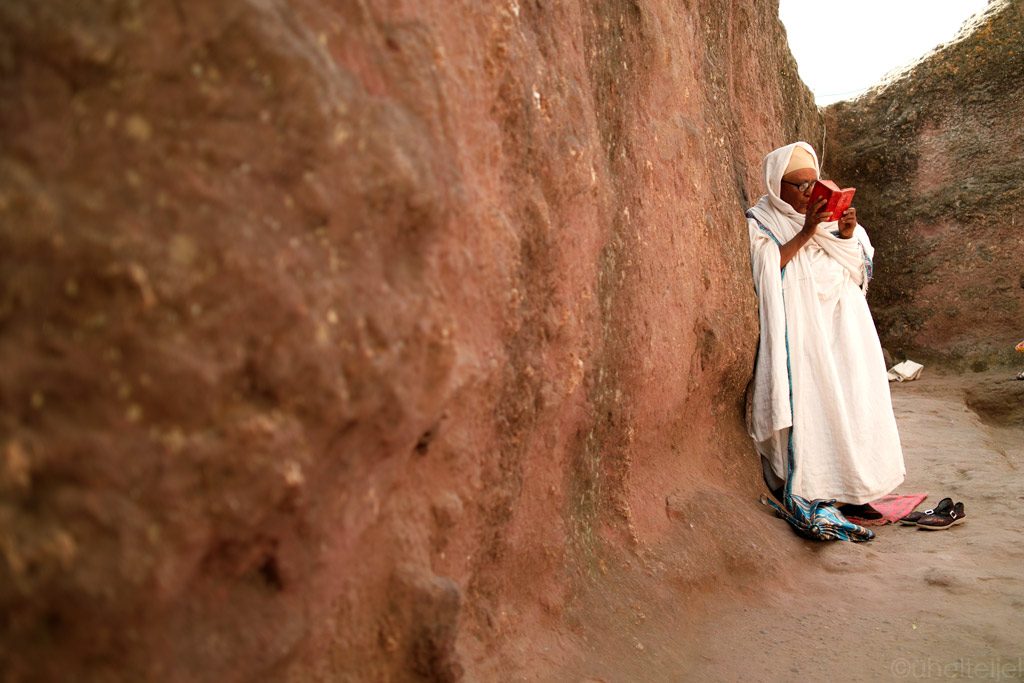
Pilgrim reading The Holy Bible in the direction of the church.
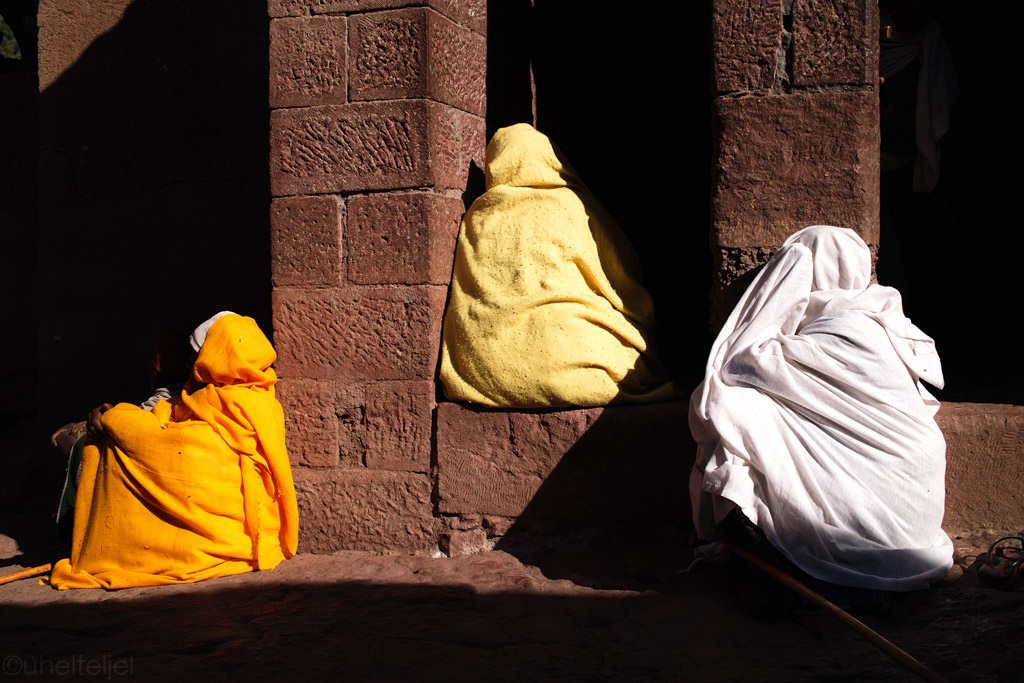
Pilgrims in Lalibela.
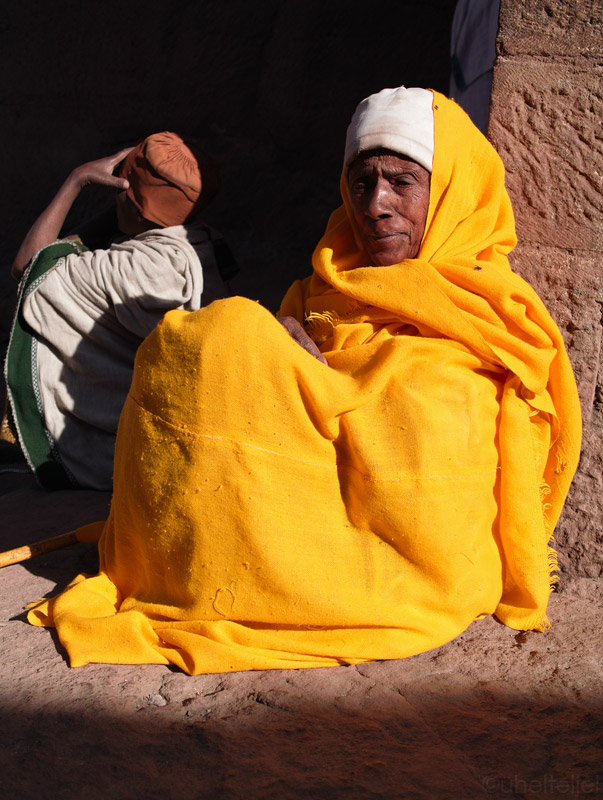
Some more pics from Lalibela...
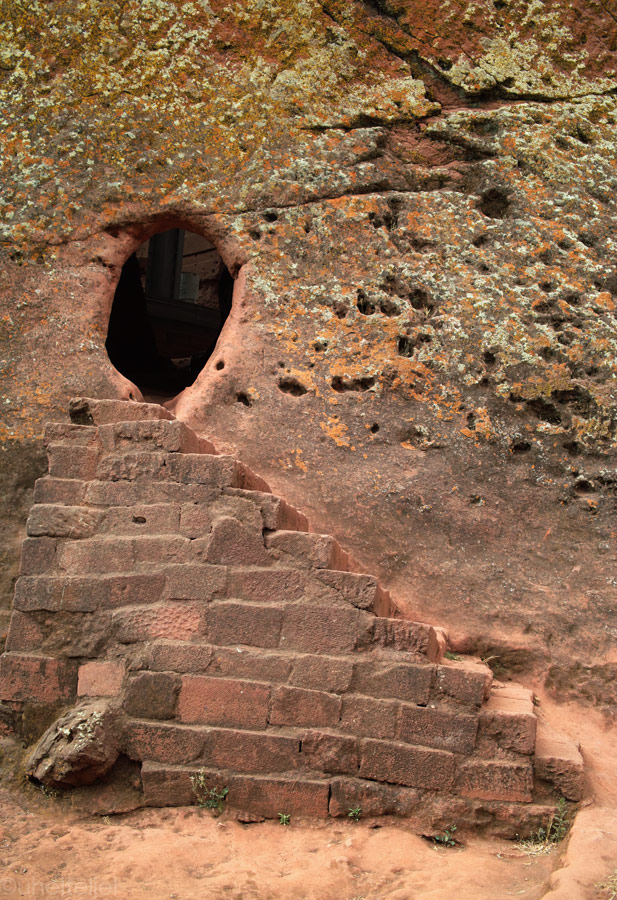
Entrance to other rock hewn churches.
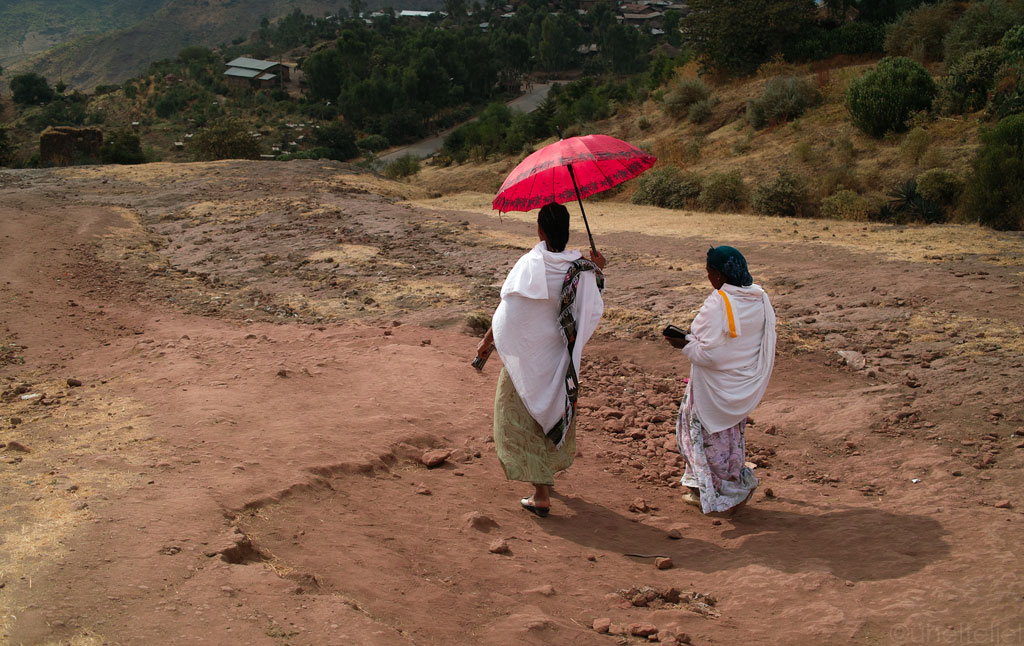
Women returning from a service - an umbrella symbolizes the holy glow of saints among Ethiopian Christians.
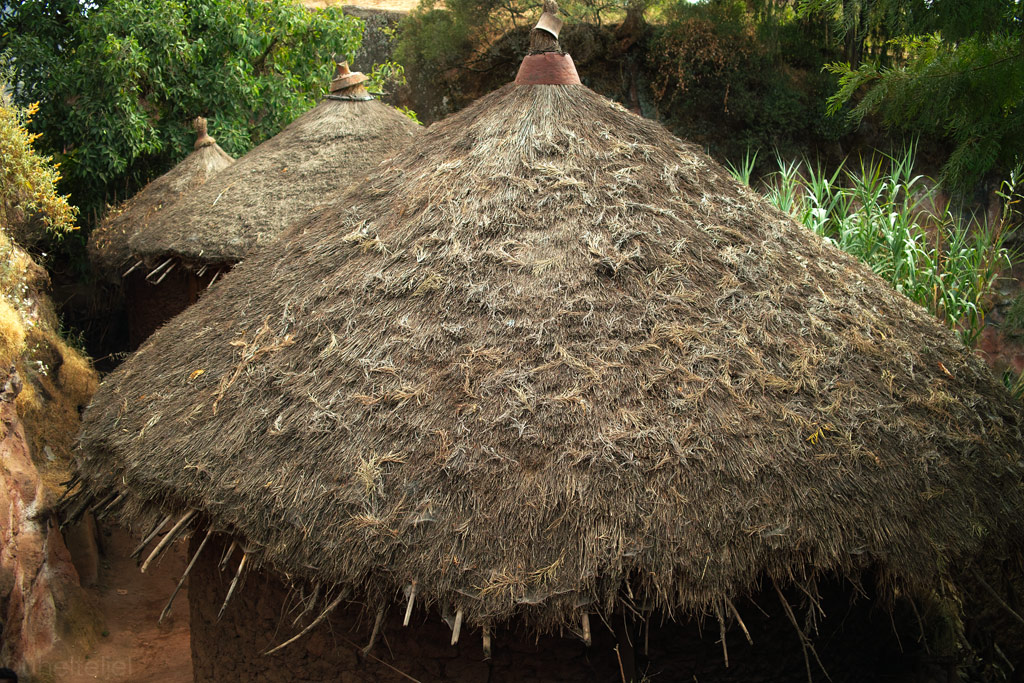
Roofs of traditional huts.
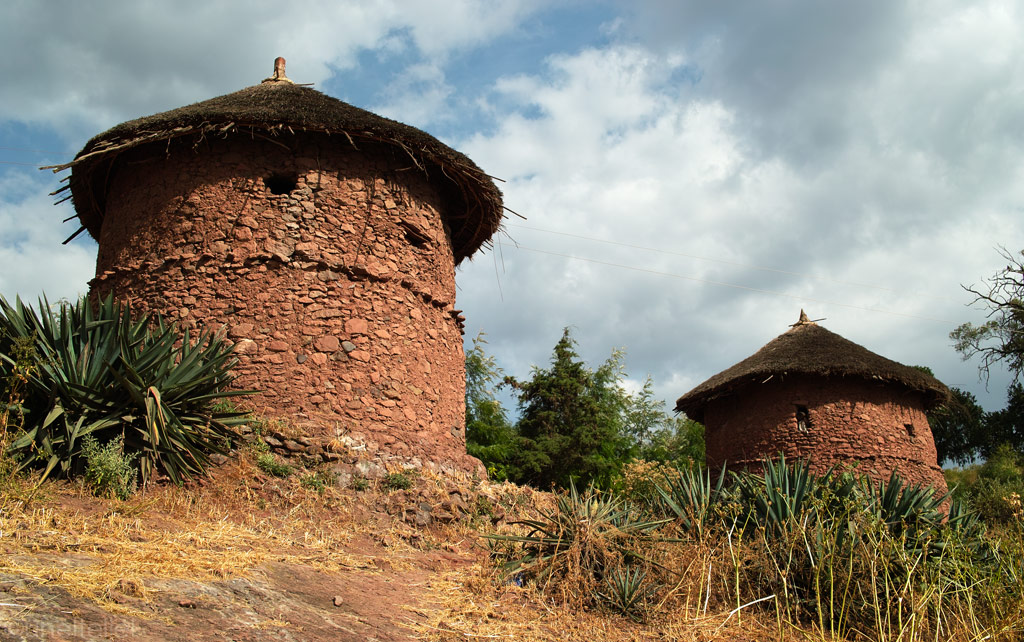
Unlike most rural huts, huts walls in Lalibela were made from stone and they even had electricity.
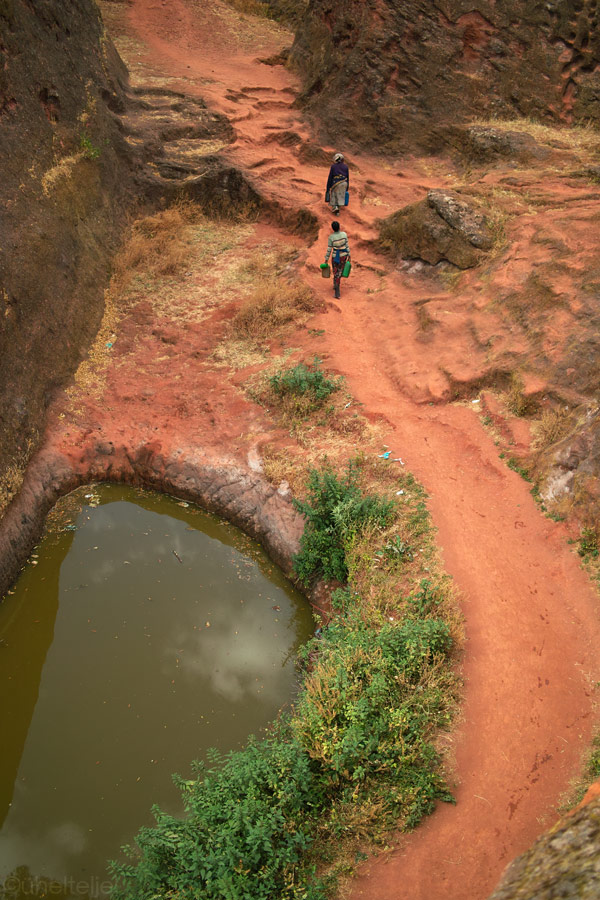
Women carrying water from the pool.
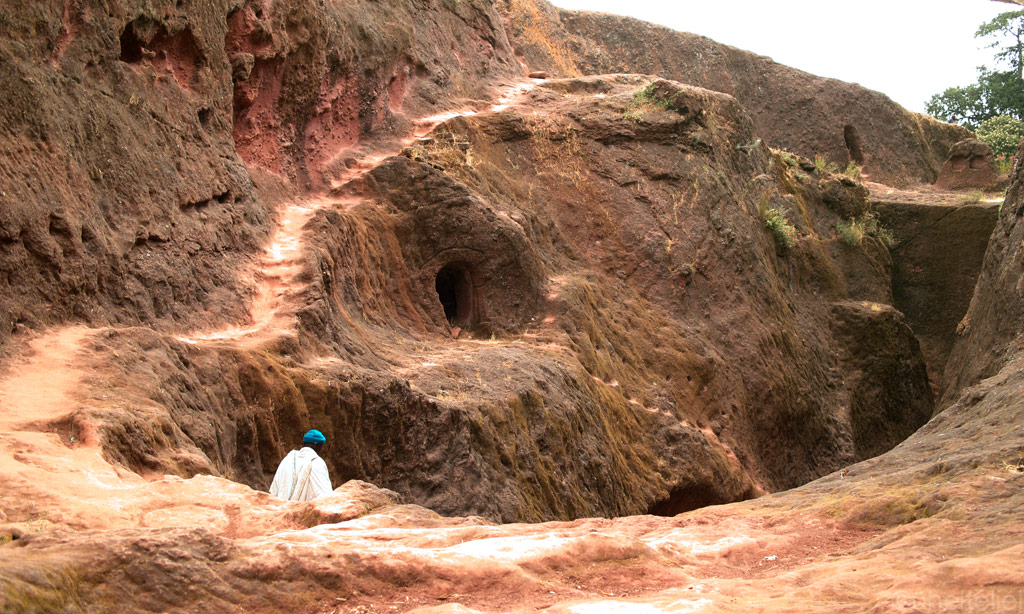
Tracks and doors in Lalibela.
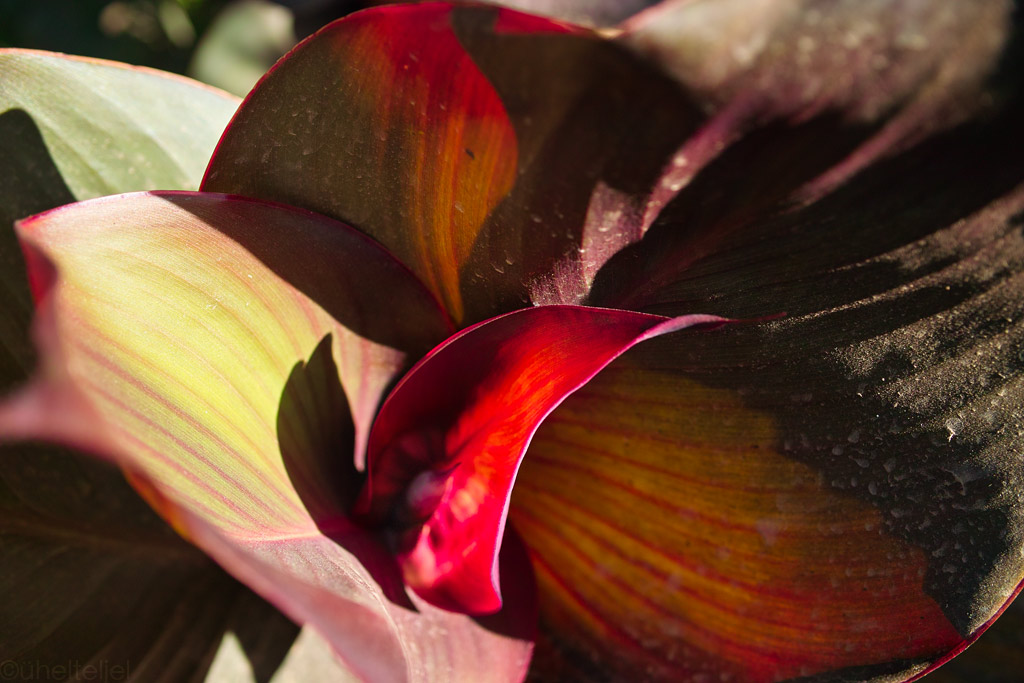
Local fauna.
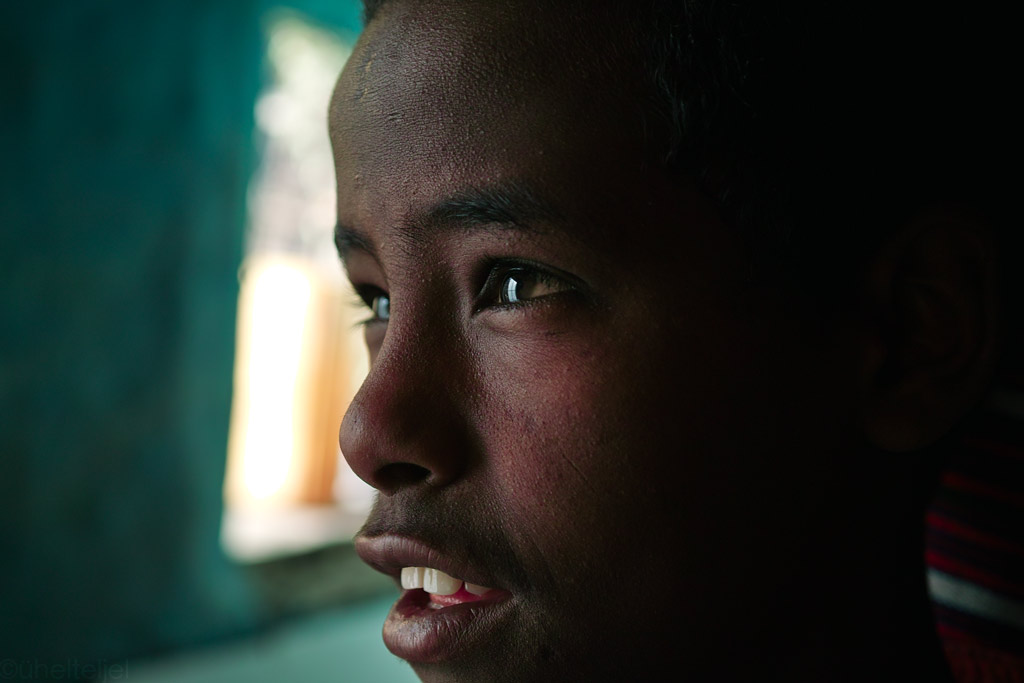
Lalibela's young man.
It turned out that not only was Lalibela a good place to get some religious enlightenment, but to get better acquainted with the local culinary traditions - on a higher level than in little roadside cafés off the beaten track.
Here we truly fell for Ethiopian coffee, which is of course no wonder because this is where coffee originated. Preparing coffee here is nothing like emptying a packet of 3-in-1 Nescafé into your cup and pouring some hot water over it. Here it involves a whole ceremony of burning incense, roasting the beans (and indeed, riding around Ethiopia one can very often smell the sweet and smooth aroma of roasting coffee), grinding them with a mortar and boiling it with the heat from glowing charcoal. One tiny cup of the strong and aromatic elixir was enough to make us appreciate coffee without milk - something we have never liked before, but Ethiopia has changed that.
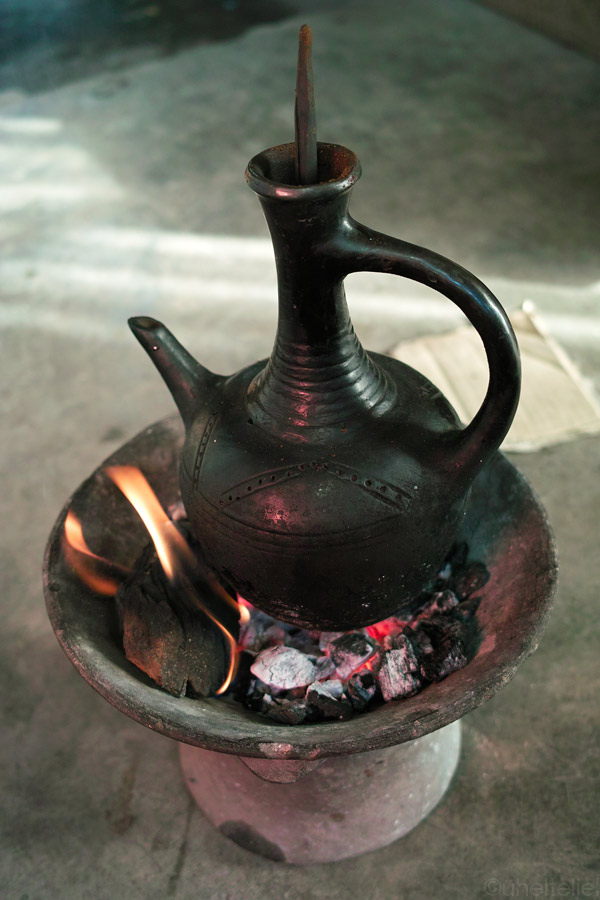
Ethiopian coffe going strong on hot coal in an African styled coffeepot - afterall, it's the mother of all coffees.
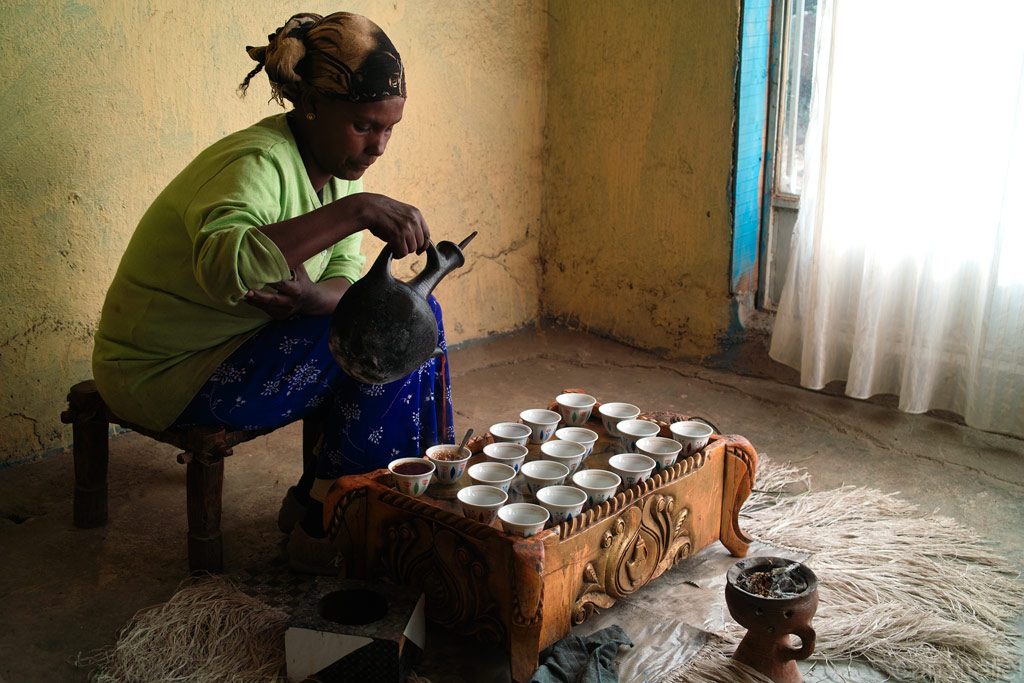
Coffee is n ritual in Ethiopia, with careful preparation and serving.
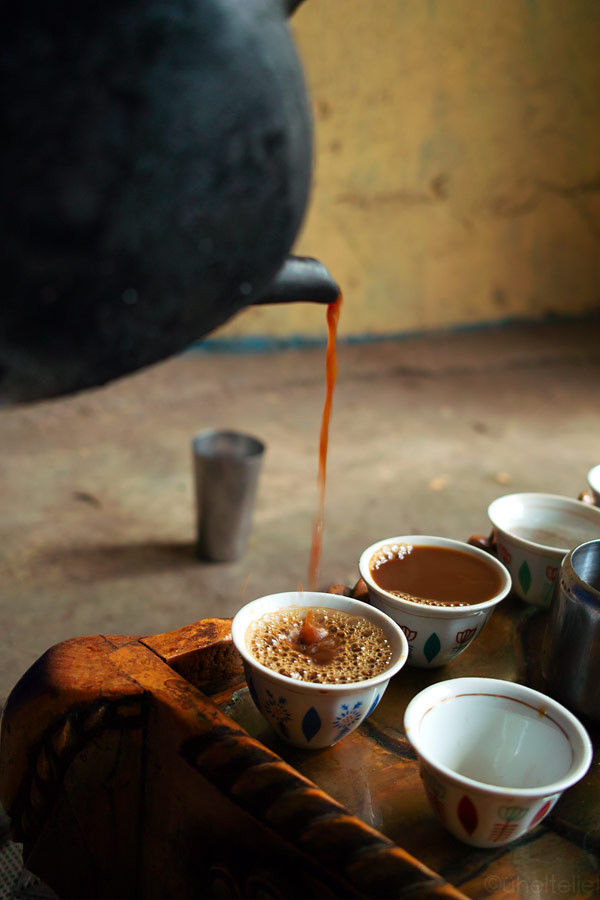
This is where that strong and aromatic elixir comes from that wakes you up in the morning or keeps you going late at night.
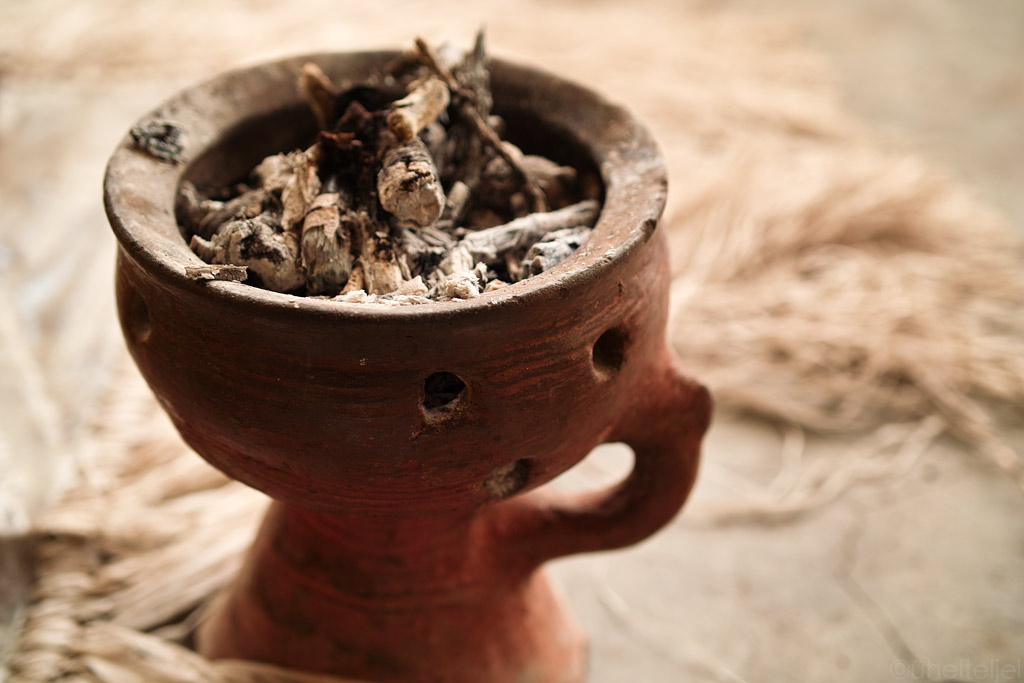
Burning incence together with coffee is another Ethiopian thing - good smells go well along with coffee drinking.
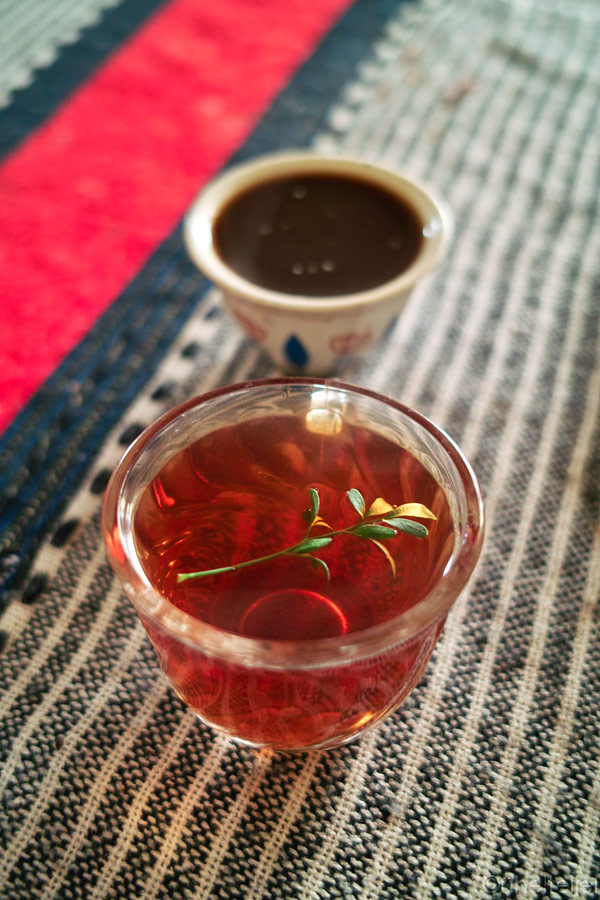
And another interesting thing about Ethiopia is that coffee is served together with tea, sometimes even mixed. Here tea has some sort of local medicine in it.
Injera, too, the fermented "bread" of Ethiopia, had some surprises for us as it was far finer and more elaborate than the ones we had tasted so far. Here, many different fillings were put on top of it - boiled vegetables, chopped spinach, tomato salad, chickpea purée, lentils, meat - to be scooped up by the same injera. We could eat endless amounts of it, but one has to remember to leave some on the plate - in Ethiopia it is believed that empty plates invite hunger.
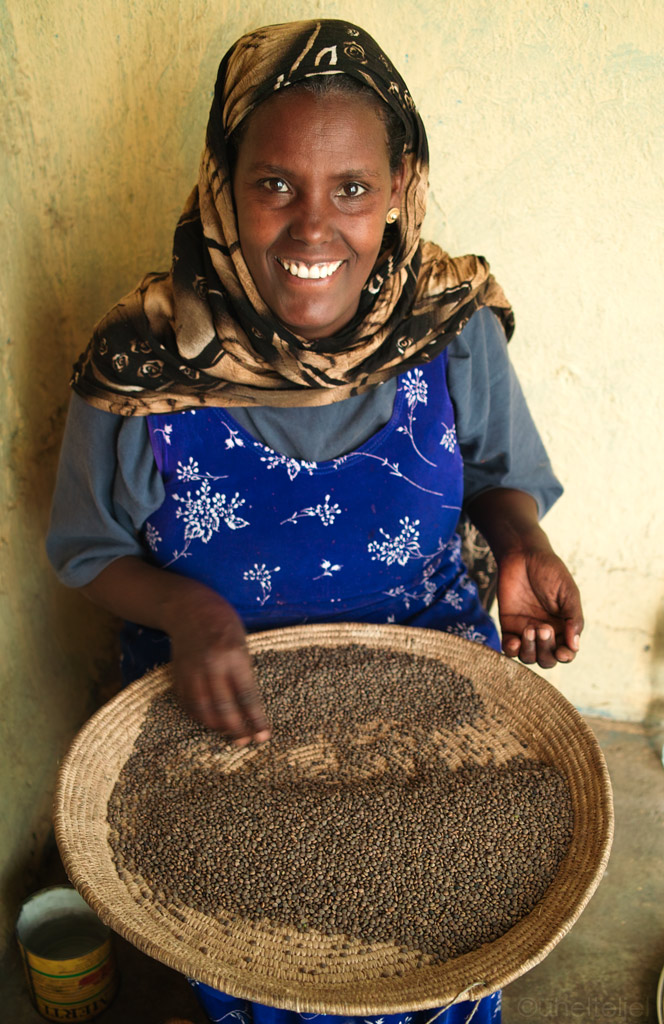
Ethiopian lady selecting lentils - the sauce made out of those very same tasted superb on the pic below!
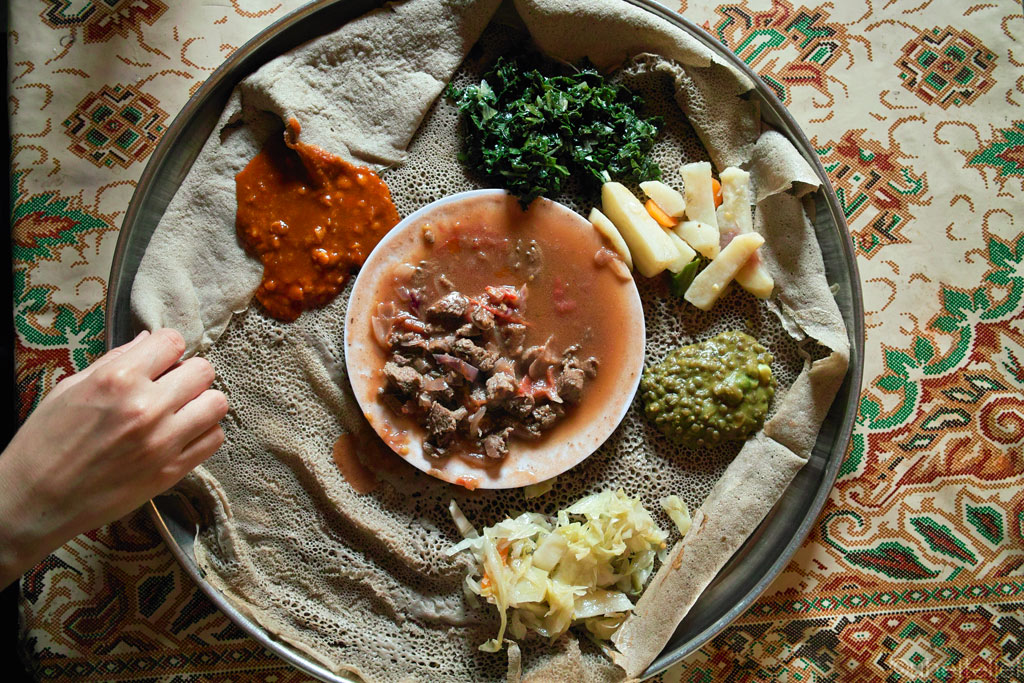
Injera - a mix of vegetables and sauces on injera - eaten by hand only.
The arrival of Christianity is definitely an important milestone in Ethiopian history, but it does not mean there was nothing here before. Around 400 BC the pagan kingdom of Aksum was created in the North that thrived from the 3th to 6th century. Considered one of the greatest kingroms of the ancient world, it encompassed areas as far as Southern Arabia and parts of today's Sudan. We went to check out how its capital, Aksum, is doing today.
On the way there we stopped in Mekele, a university town, but although with some 200 000 inhabitants it was the biggest town we'd visited in Ethiopia so far, it really resembled more an oversized village. I can only guess that with a few exceptions, African sities will not be blowing us away with being too civilized or sophisticated, so we better enjoy what we have. After all, if this is not the exotic stuff we're after, then what is?
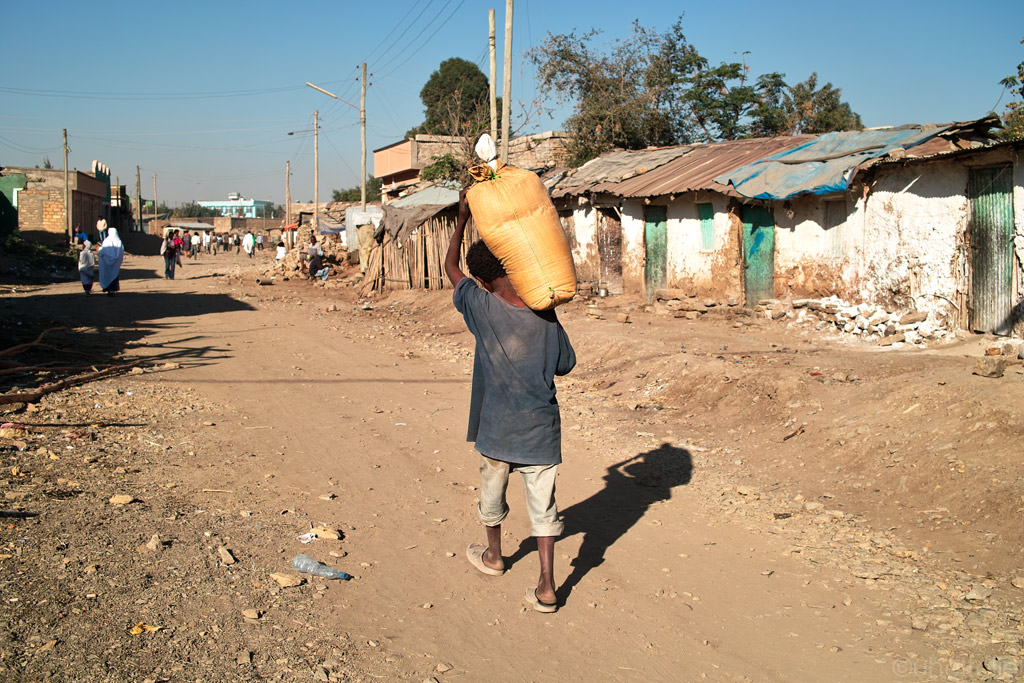
A street in Mekele.
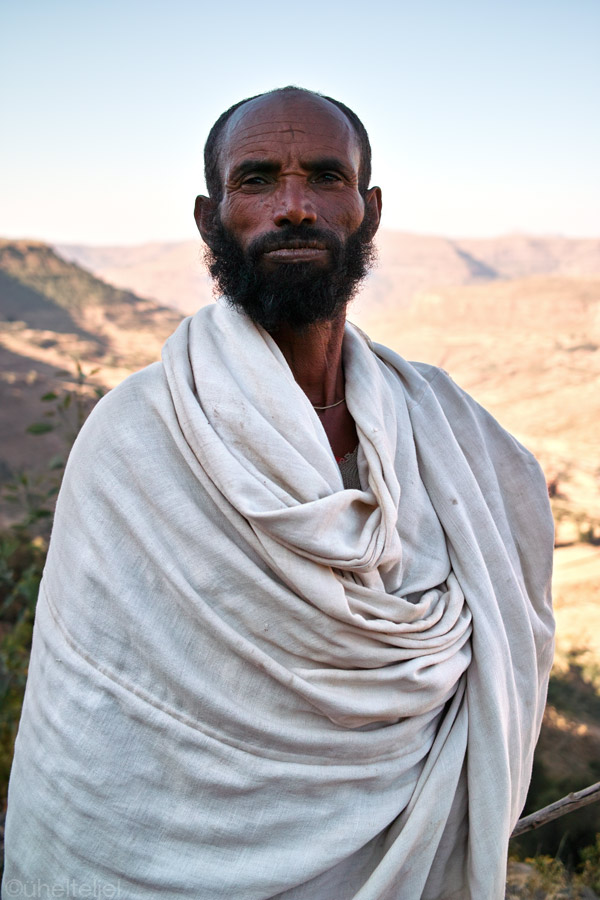
Christian man with a cross cut into his forehead.
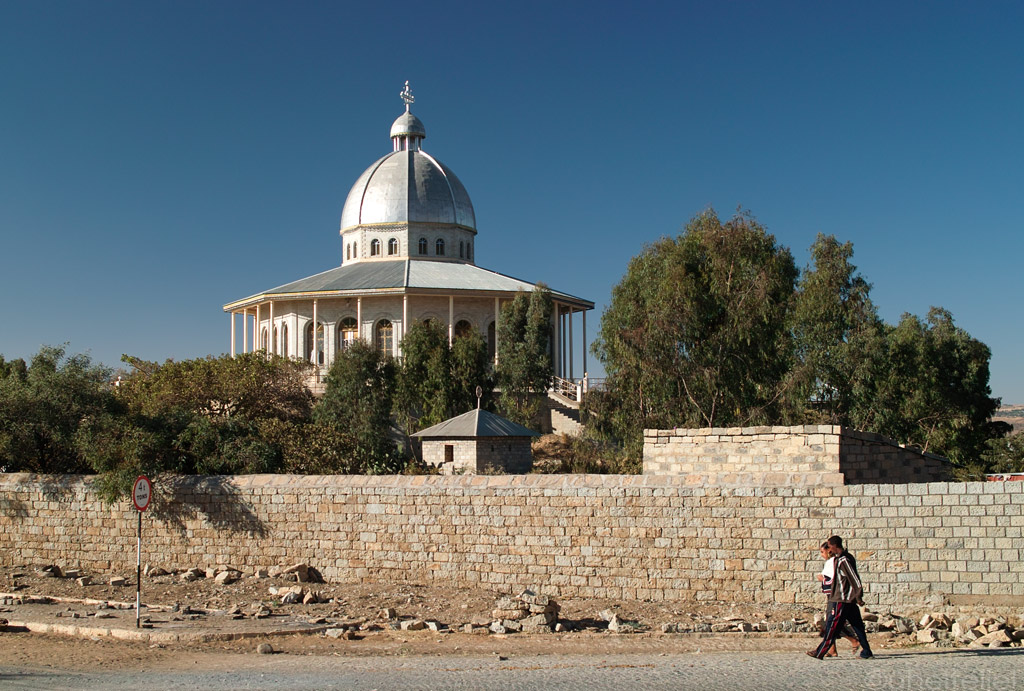
One of more modern-looking churches.
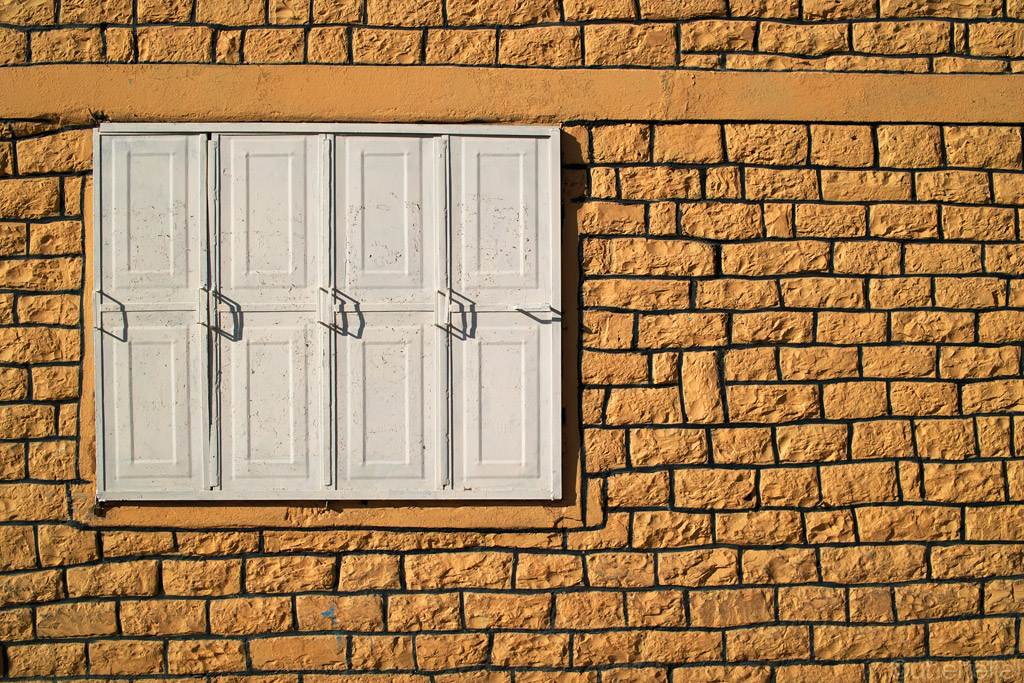
Window in Mekele.
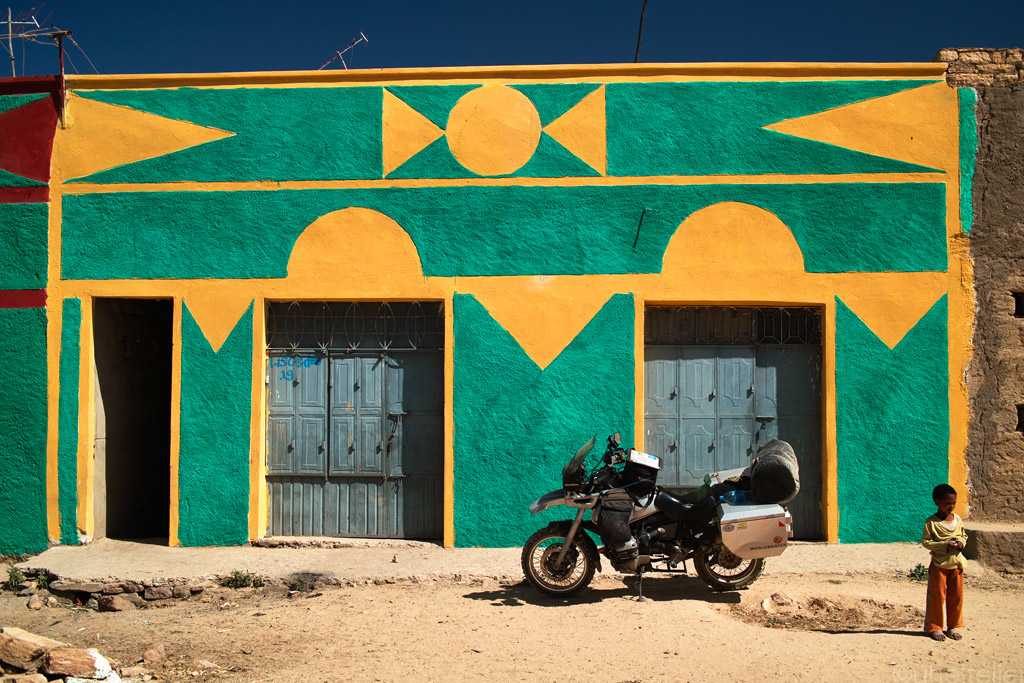
Colourful houses.
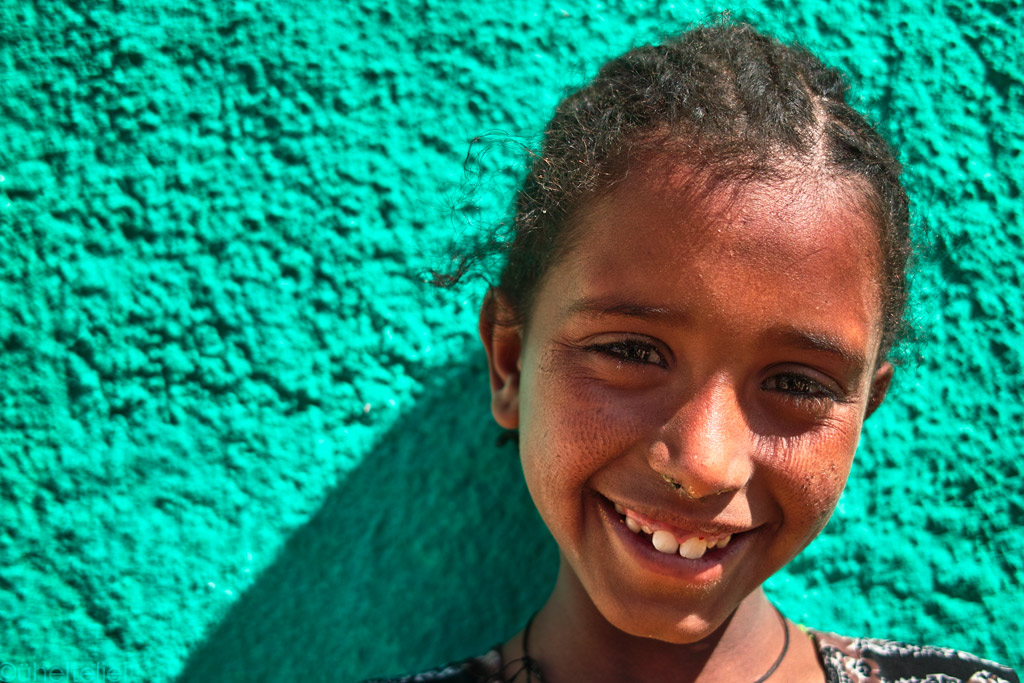
Girl wanted a portrait, she got one.
On a Sunday morning we were awaken even before sunrise as the churches' (!!!)rupors started transmitting some sort of religious recitals. Coud it be that here, where Islam and Christianity co-exist, the priests have started to copy their "colleagues", reminding their congregations that Sunday is the day of paying a visit to the church?
On the way from Mekele to Aksum we got off the main road hoping to find some of the famous rock hewn churches, but once again it seems that the tourism policy in Ethiopia has employment as one of the priorities, so it is difficult if not impossible to find the churches on your own, without a guide, as they are not signposted. Just like with the Danakil Depression to visit which you need a guide and an armed guard - without you will not even be permitted past the checkpoints. So all we could enjoy were the fine views, and they were fine indeed, almost justifying the terrible road conditions.
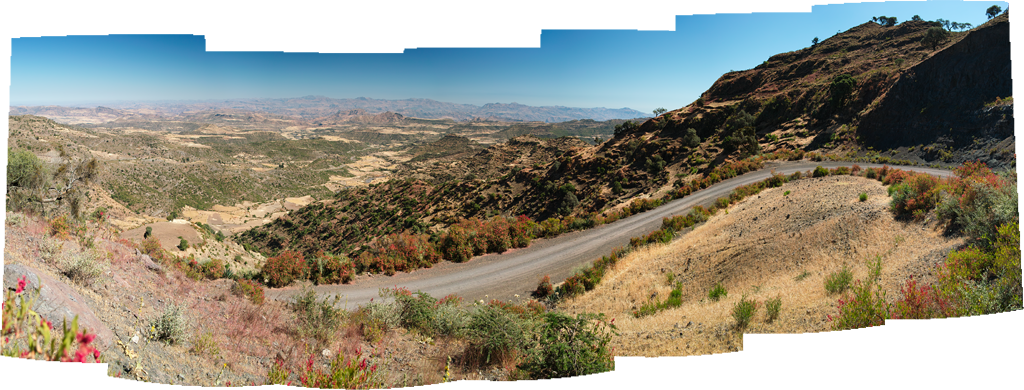
Panorama from the road (click to enlarge each one)

Panorama of a village.

Panorama of the peaks.

Panorama from the road through some interesting peaks.

Panorama of the mountains.
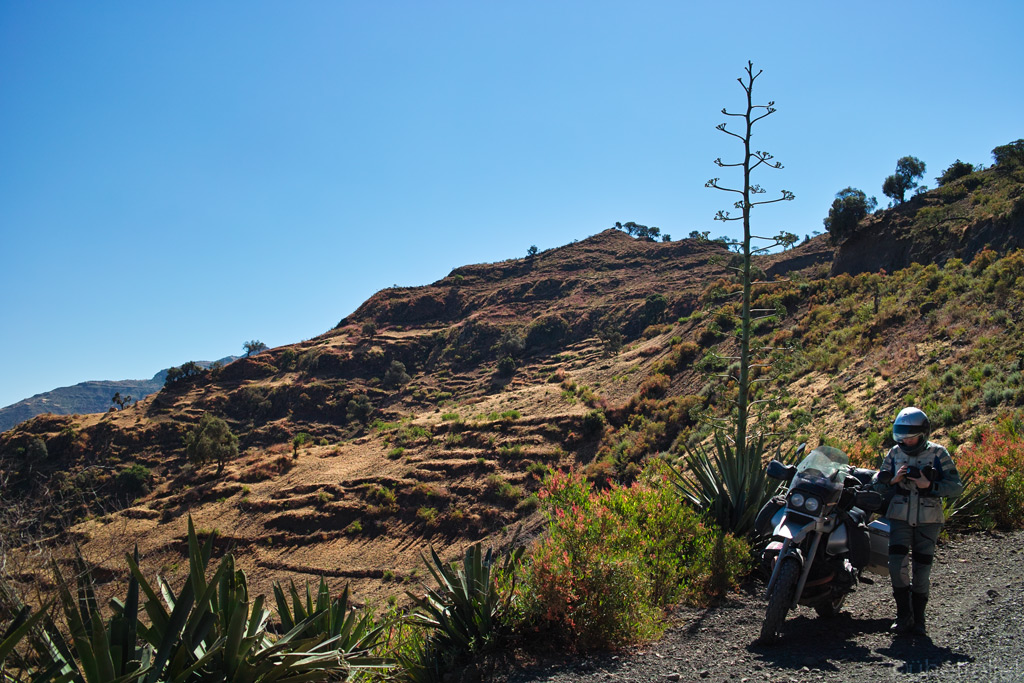
Somewhere in North Ethiopia.
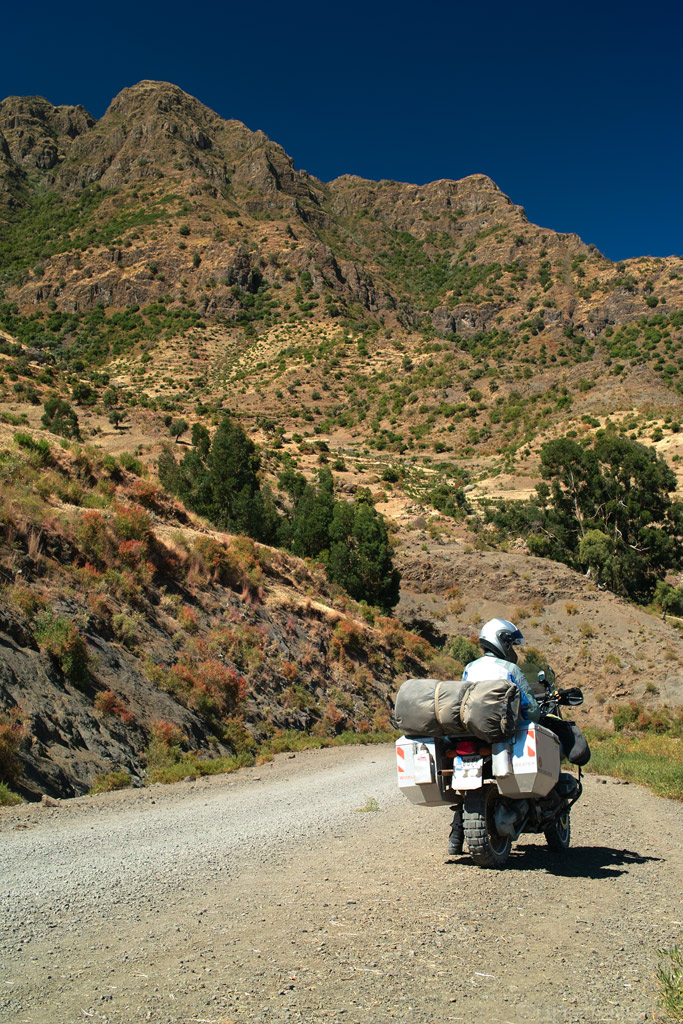
Road through mountains.
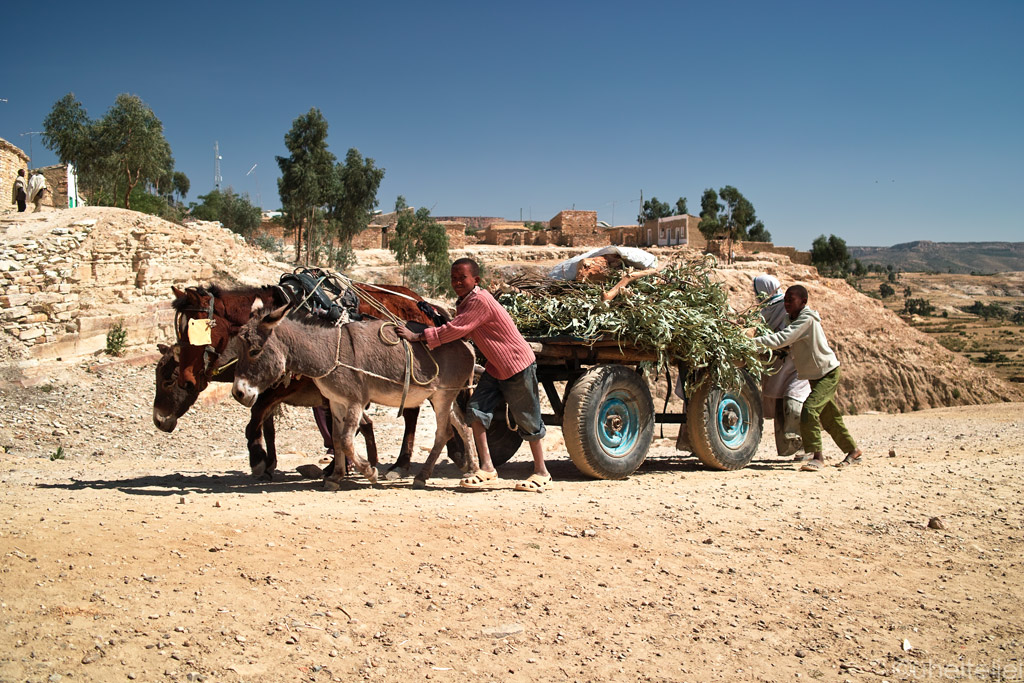
Children seem to be the main workforce in Ethiopia - you mostly see children working in the fields and herding the animals, very few adults.
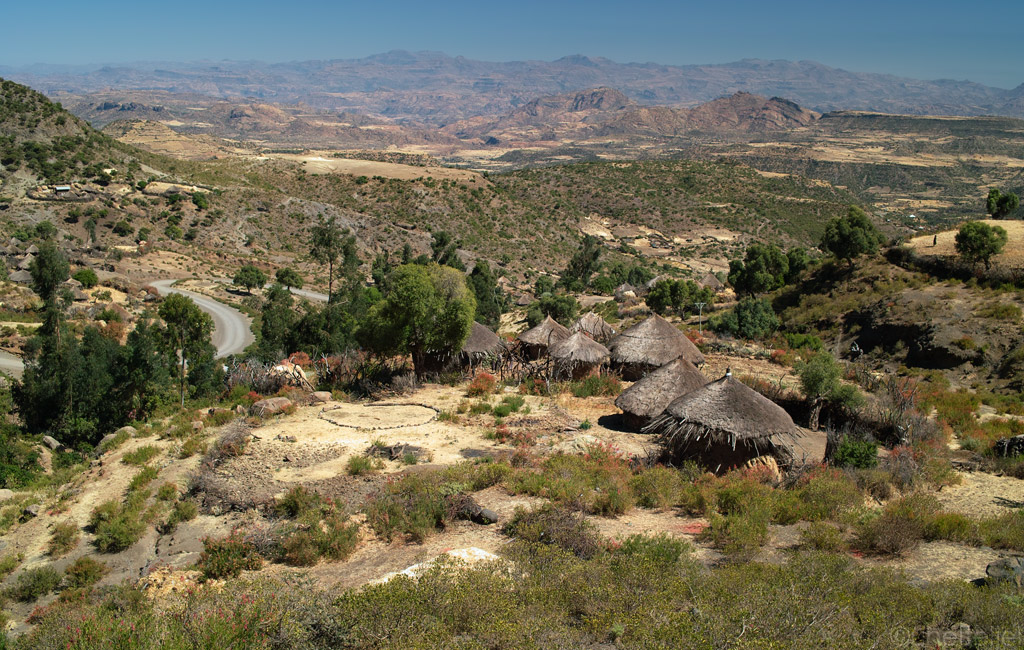
Ethiopian huts.
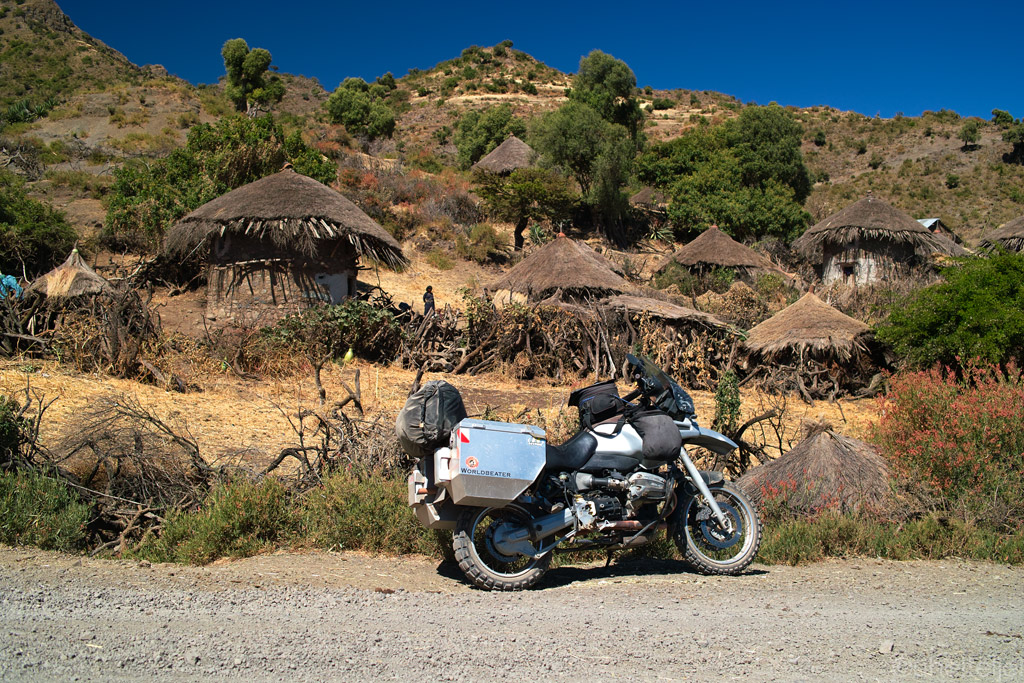
In a village.
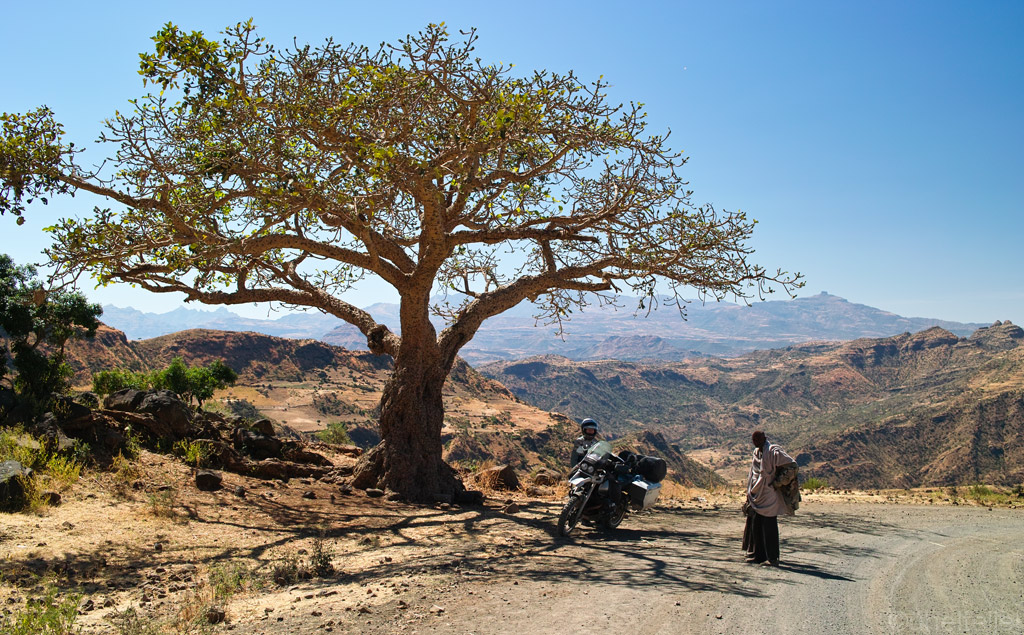
Stopped under a lone tree - of course people immediately come out of nowhere to check us out.
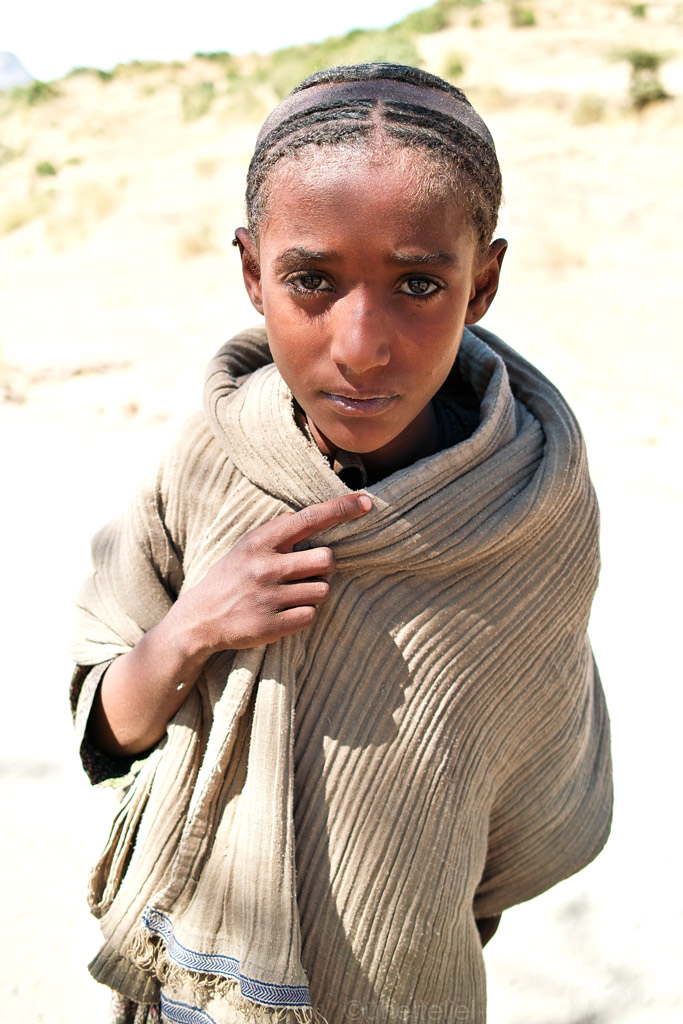
Shepherd girl.
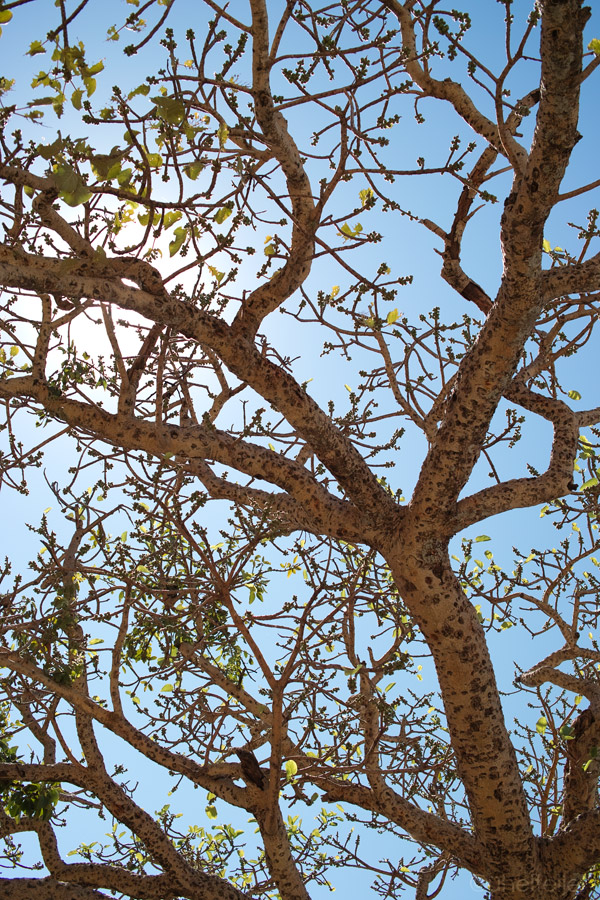
A tree.
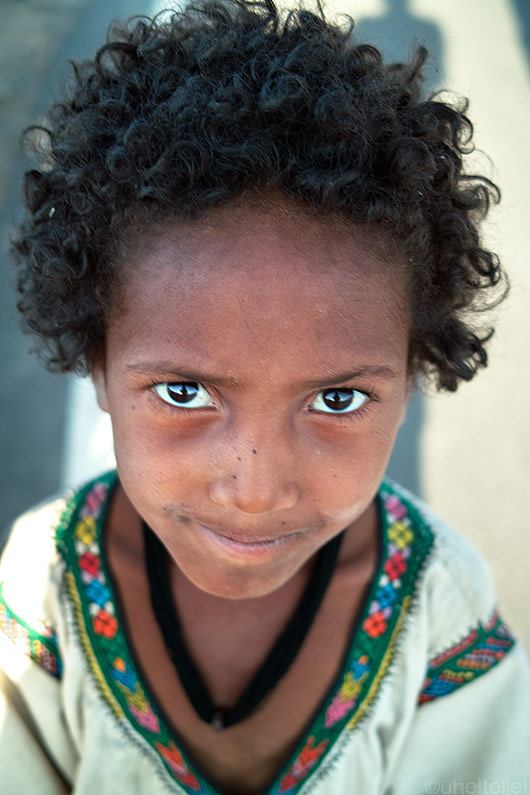
"Money-money!" she said first, I took a pic, showed it to her and that seemed to satisfy her.
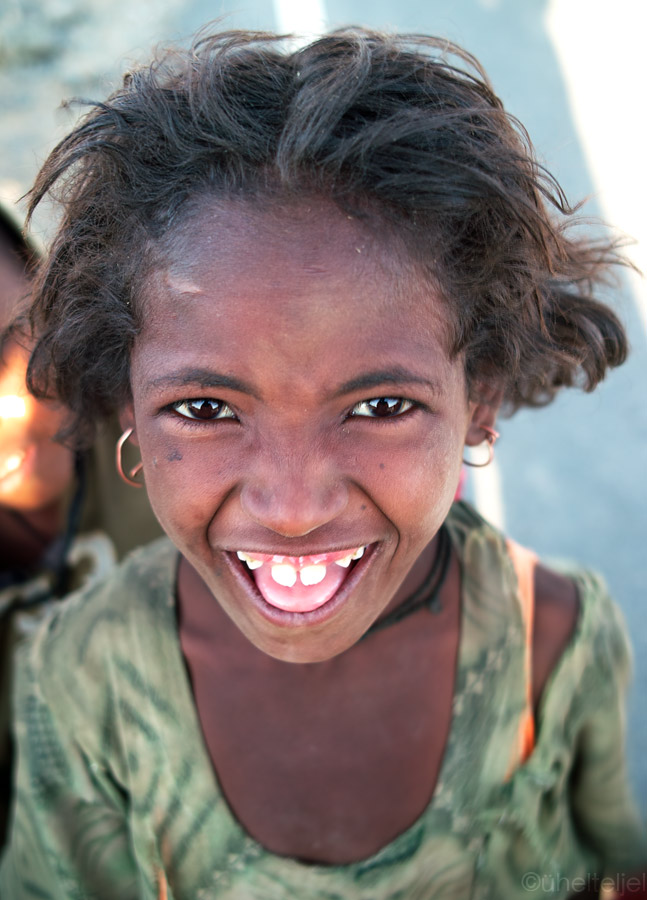
A girl with a smile.
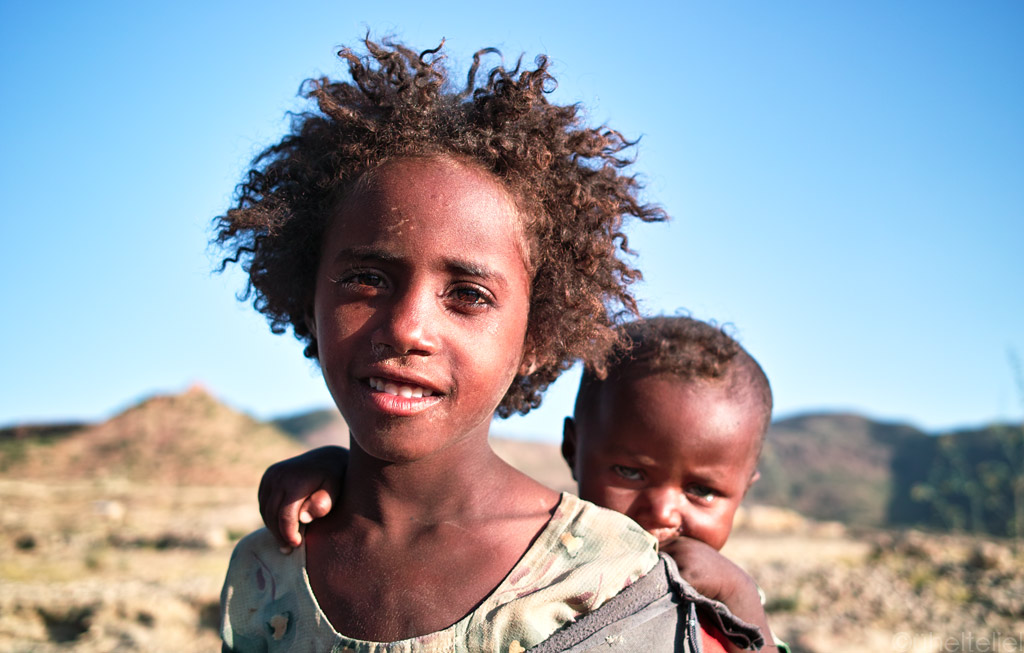
Carrying the younger brother.
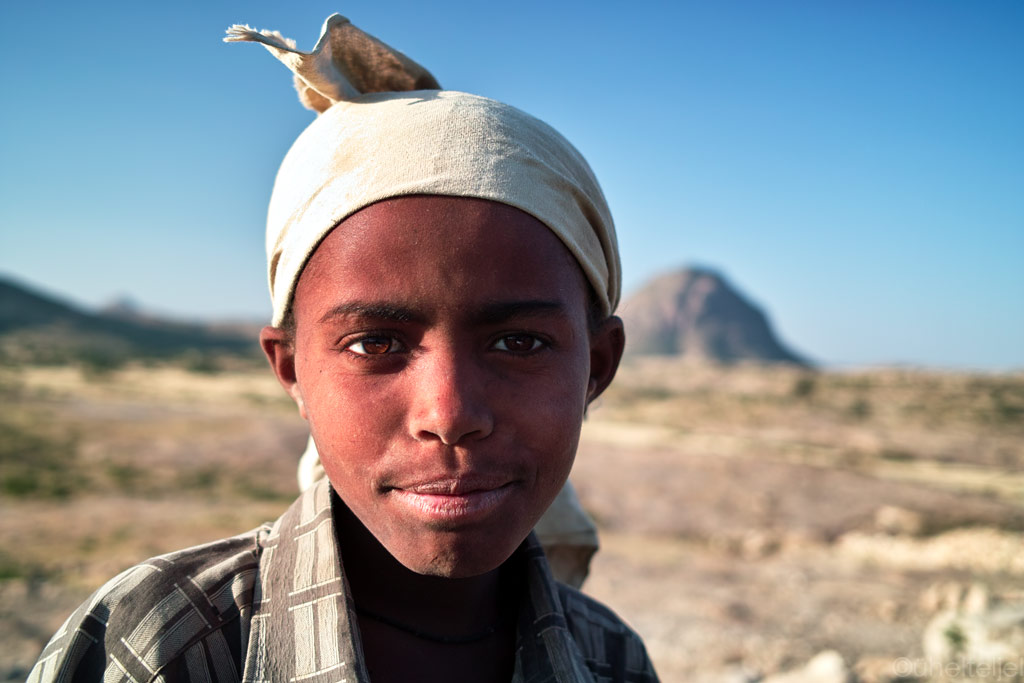
Shepherd.
Aksum, once capital of the mighty kingdom, was again nothing more than a village. We paid a mandatory visit to ancient stelae standing above tombs of important figures of past times and found them to be pretty outlandish. Standing up to 33 meters high they are definitely a great source of information for historians about the life in the kingdom, but what is the most intriguing is how they managed to erect these huge slabs of stone in the first place. Some believe it was the heavenly creatures, some say elephants were used. The highest of them, weighing 360 tonnes, was actually never erected - it fell down and to pieces in the process. Some, of course, interpreted is as a sign from heaven that it is finally time to convert to Christianity. Although it might as well been a sabotage.
In any case, regardless of all the intrigue and the obscure goings-on, the stelae are a magnificent monument left by the peope of times long gone.
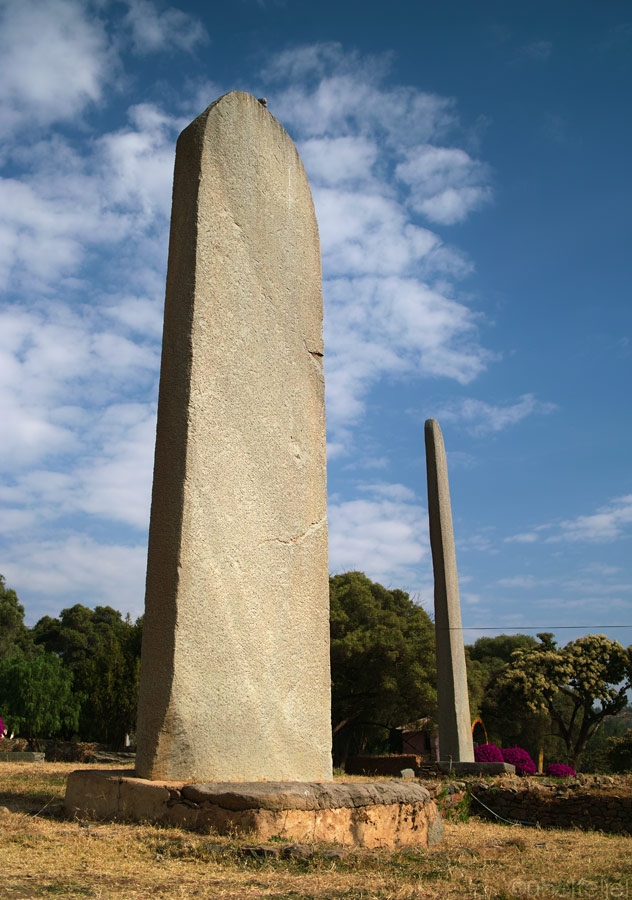
Stelae of Aksum kings.
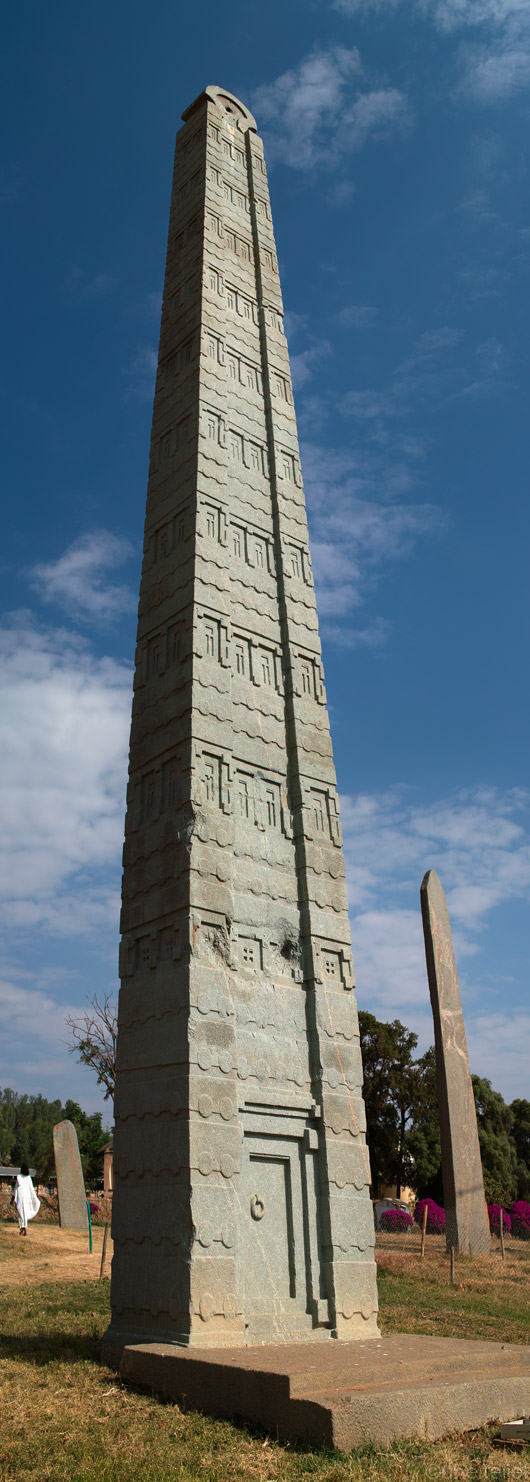
They are VERY tall.
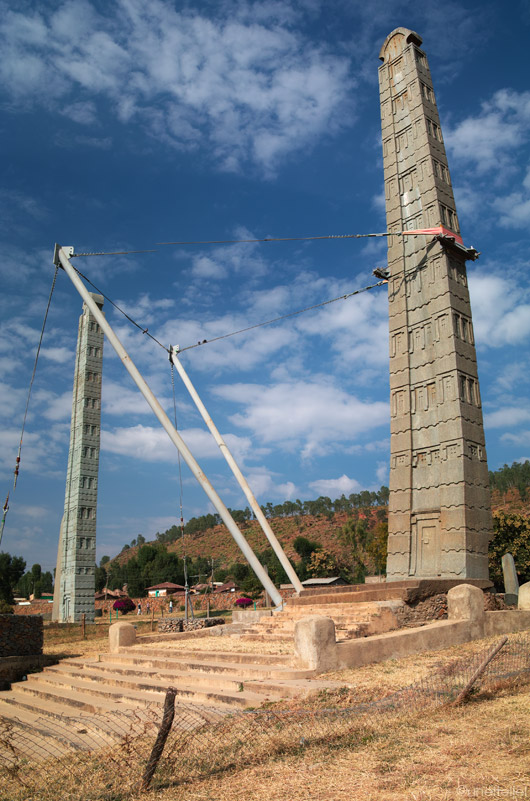
Some had to be artificially supported.
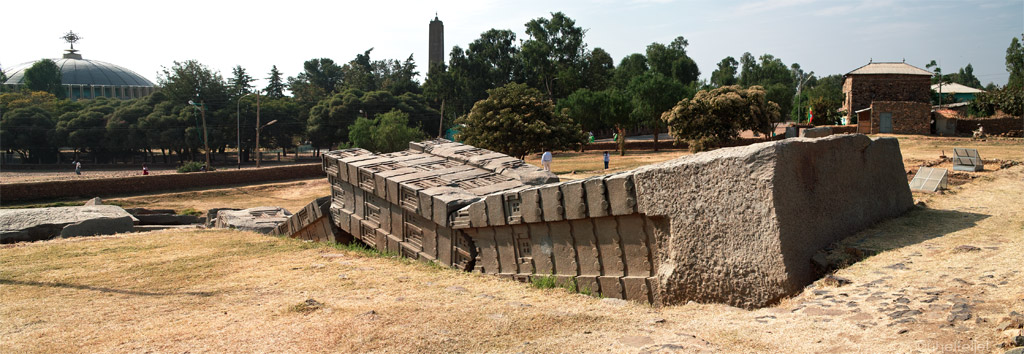
The biggest monolithic rock man ever has attempted erecting in history fell down - the very same one.
Otherwise, Aksum is a friendly kind of place with good food and local rhythms and melodies.
One morning we went to get a breakfast in a restaurant without any signs, and picked a random thing from the menu as we have not really become experts yet on Ethiopian culinary terms. It was "fata". The waitress came to our table with a bowl of bread, and started ripping the bread into little pieces in front of us. We were slightly confused but enjoyed the show. Then she disappeared with the bowl, and five minutes later appeared again the contents of the bowl looked like this:
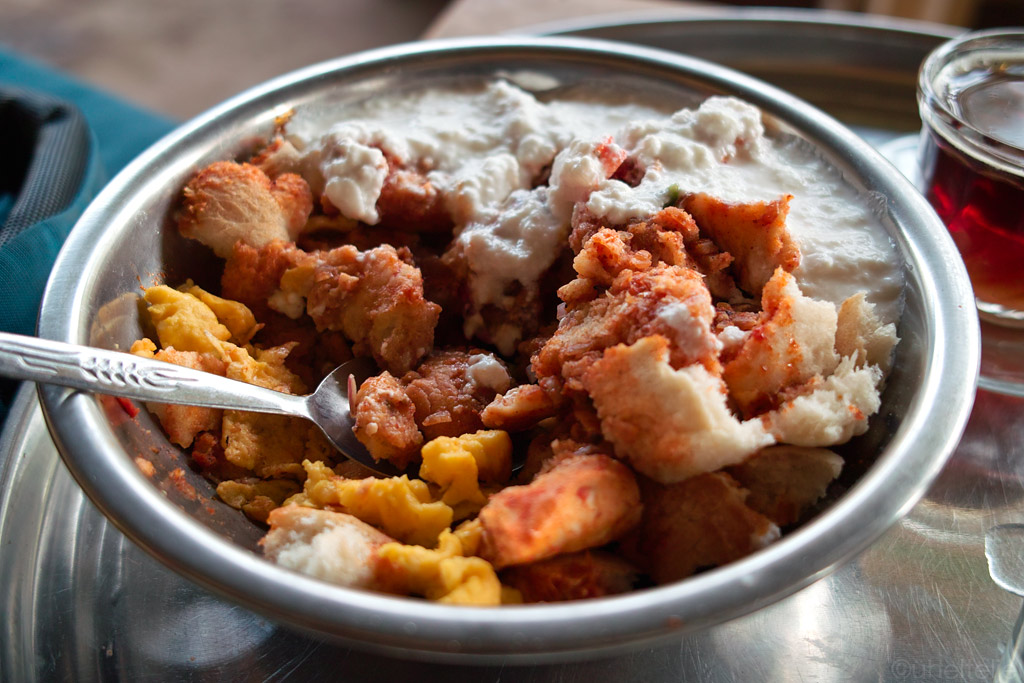
Fata.
The pieces of bread were mixed with spicy tomato sauce, and added to it were scrambled eggs and natural yoghurt. Does not look like much but is actually tasty and filling. Gotta try other unknown things too!
The North Ethiopian landscapes had been cool, but the Simien mountains were definitely the pick of the bunch. I am not even sure why exactly, but something kept on telling us that this was the place we had to go see - otherwise we would have limited ourselves to Lalibela and turned south towards Addis Ababa instead of going further north and braving the terrible roads.
Up until Aksum it wasn't actually that bad, but from there on the corrugations became even more spiced up by sand, dust and big rocks, so we really hoped the Simiens would live up to our expectations and justify the terror. In addition, the sky was overcast and as we left Aksum, the landscapes seemed extraordinarily bleak.
Of course, the views soon became more and more promising, almost resembling the Monument Valley in the USA.
As usual in Ethiopia, the entrance fee to the Simien Mountains national park cost us "non-resident tourists" a fair share of birr (Ethiopian currency, pronounced quite similar to "beer"), but we had not come so far to just turn around without seeing the mountains up close. So we paid all the entry, vehicle, camping and scout fees, and off we went. Without the mandatory scout ("to protect us from the locals who might not be honest") of course, as there is no space for a third person on our bike. The gatekeepers were quite confused because of our scoutlessness, but after some negotiations they gave up and let us go.
As it too often happens, as we entered the national park, the sun was setting so we had to find a place to pitch the tent, and fast. We had to stop many times for pictures before though - the view from the height of the 3000-metre plateau painted in sunset colours and glowing mist was simply mindblowing, even though the altitude also meant it was really, really cold.

Panorama of the sunset (click to enlarge)

Panorama of the Simien National Park.
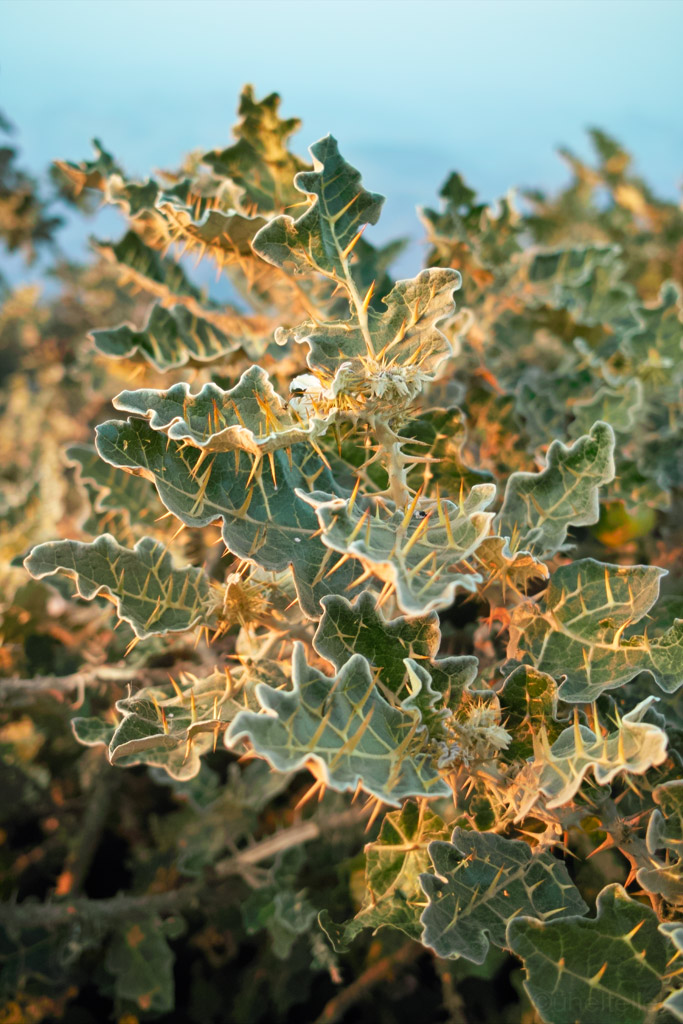
Plant with leaves having thorns in Simien.
Locals wrapped into cloths came to check us out. Obviously they were not the dishonest kind as before too long the good old straightforward "money-money" and "gimme-gimme" talk began. Regardless, one could see it was nothing but an automatic reaction, and that they were obviously curious of us and the bike - without a scout. 4WD and bus tourists must be a more frequent occurrence here.
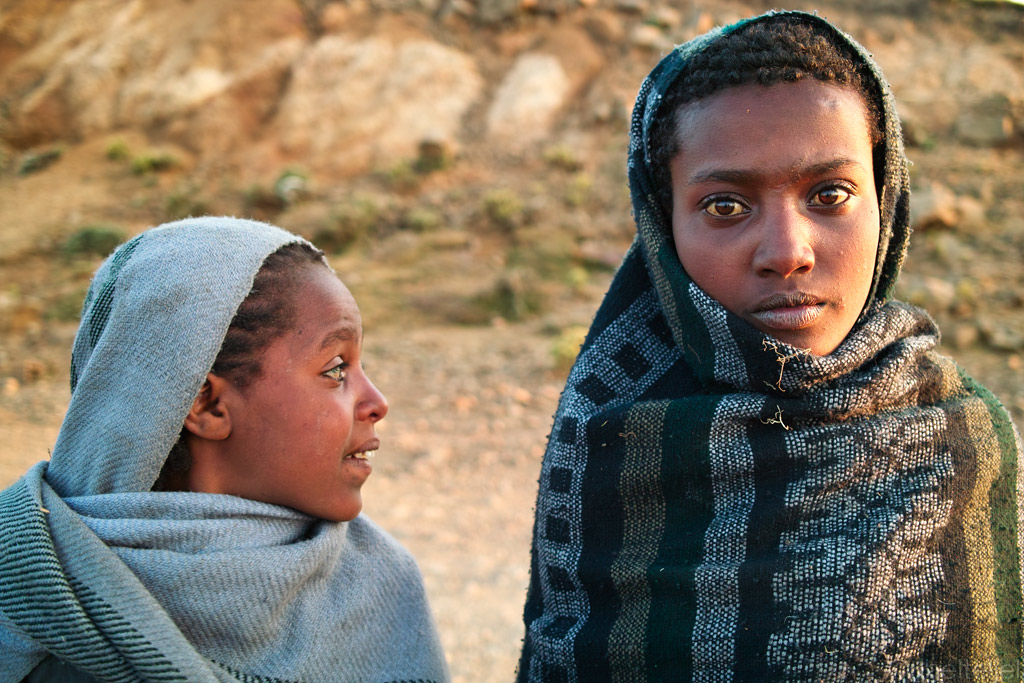
Local young ladies.
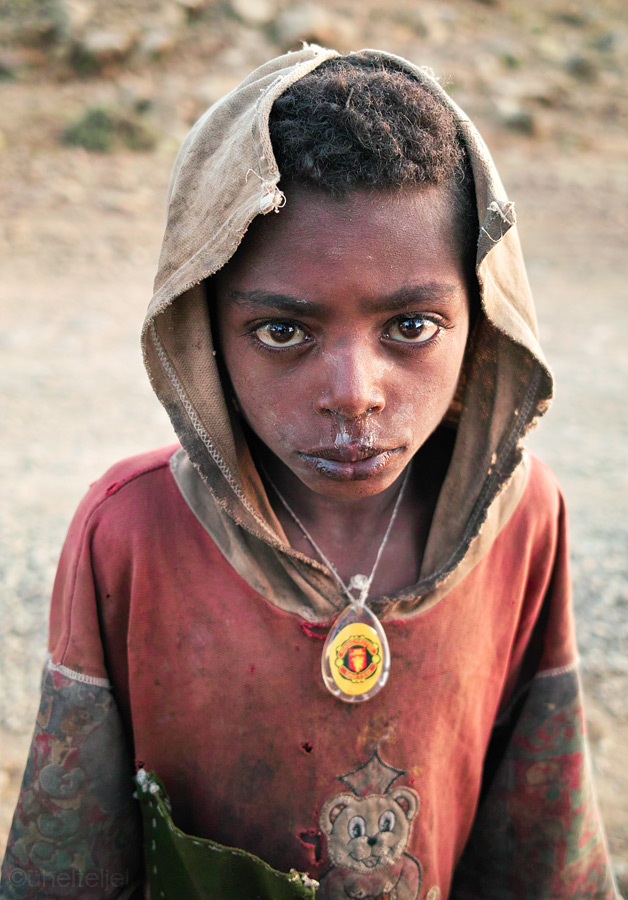
Ethiopian boy.
Although theoretically one can camp anywhere in the Simien Mountains national park, we decided to pitch the tent in a fenced area - we would have been too tired to be pleasant talking companions to who ever would stumble upon us at a random spot, and this one provided a good night's sleep.
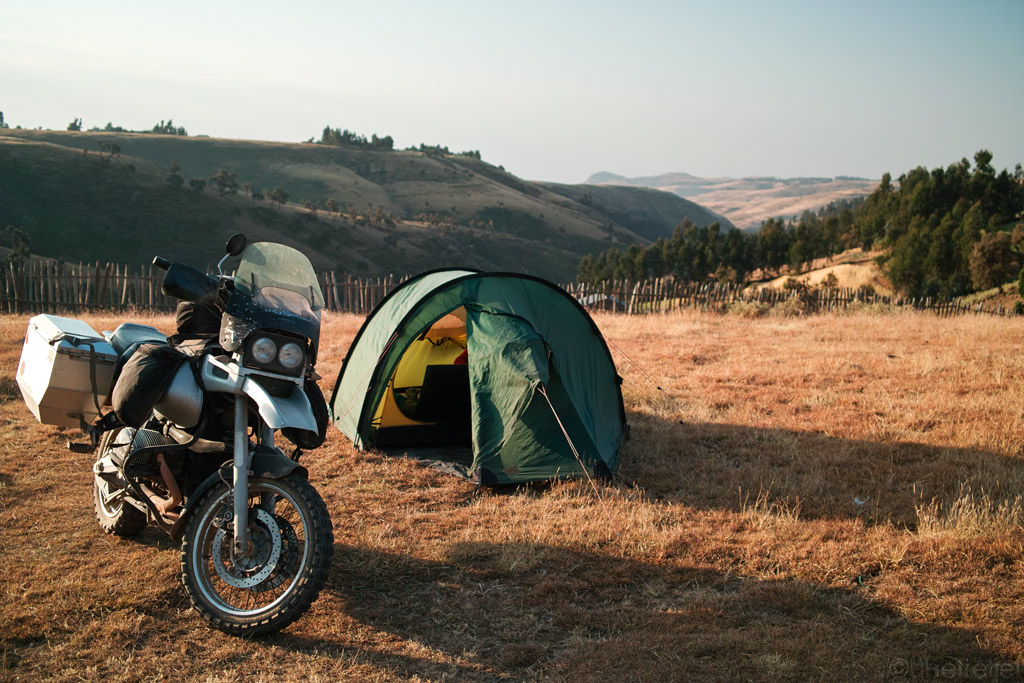
Camping in Simien.
The next day we rode around a bit more, and took in the views of the wrinkled, chapped landscapes below. Amazing!

Panoramas from the Simien National Park (click to enlarge each one)



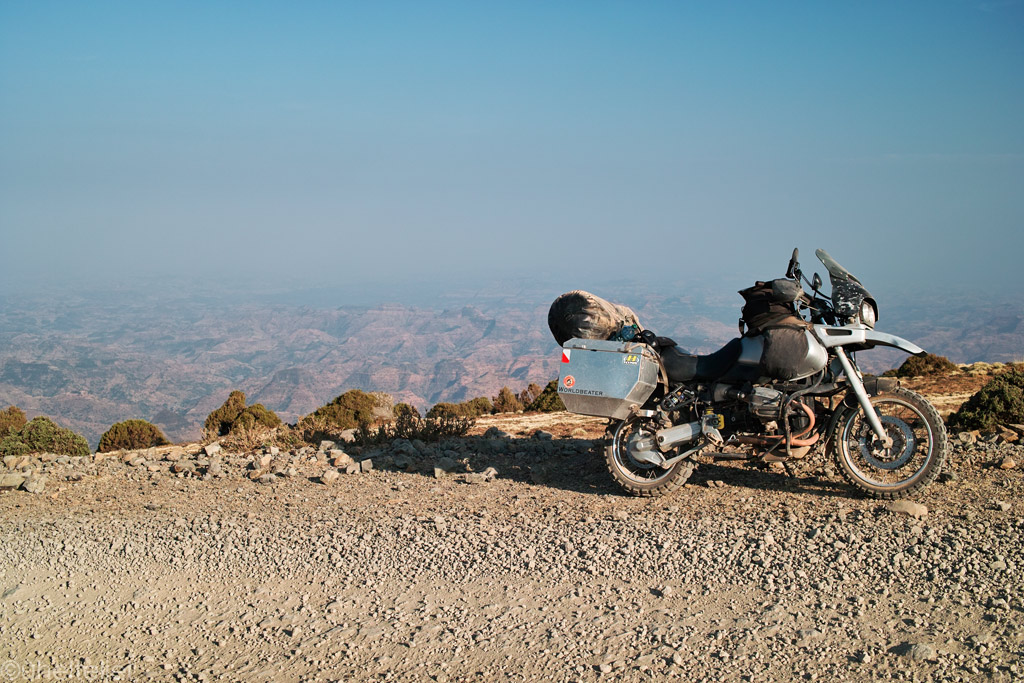
Our trusty twowheeler at 10 500 ft.
On the way from the Simien Mountains to what is called the Ethiopian Riviera, namely the town of Bahir Dar, we stopped and took some pictures of local markets. They are quite different from the ones in Asia for example, where goods are neatly displayed and really nice to smell and look at. Here, everyone sets up their "stall" where ever they fancy, and the overall picture is pretty chaotic - someone sells his ten potatoes, someone his bagful of cereal, and someone his astonishing array of basketware. Add to it a couple of confused sheep and donkeys, lots of dust and loud bargaining, and you get the "African market".
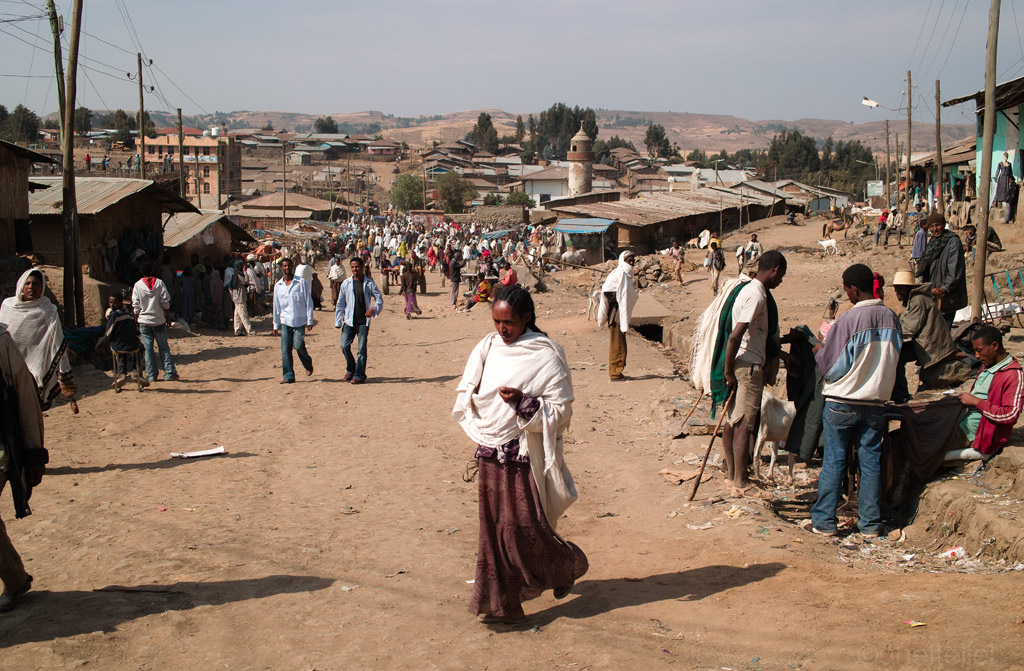
African souk in Debark.
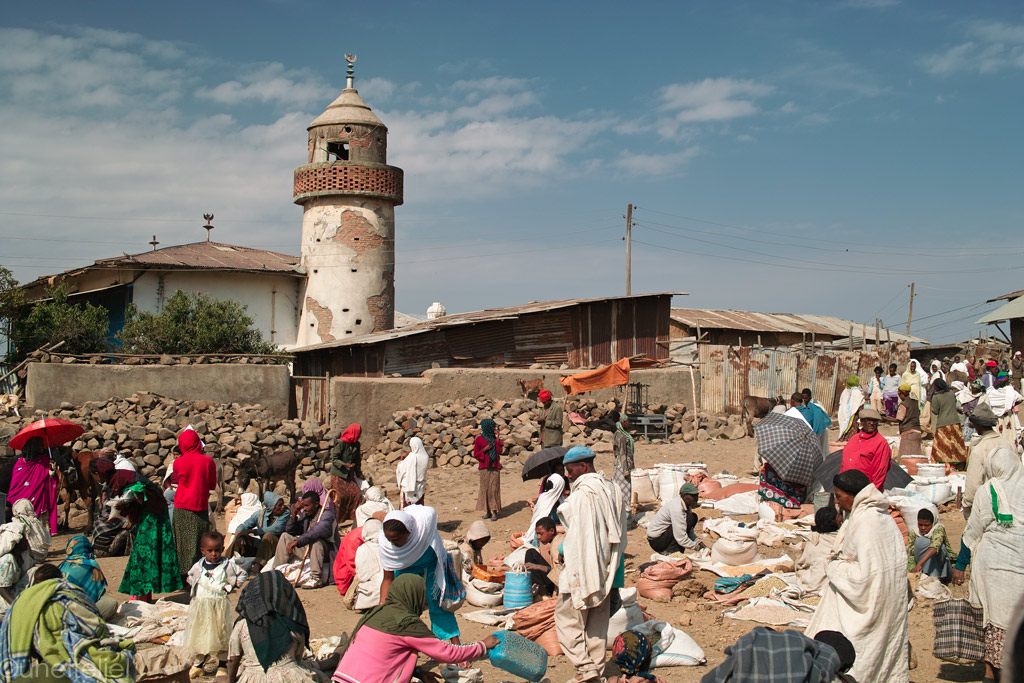
Market at an old mosque.
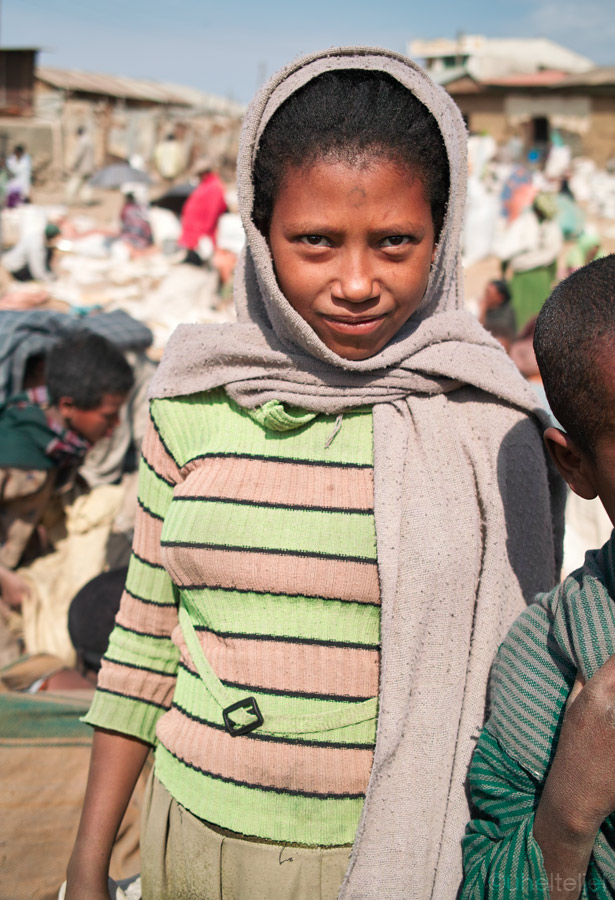
Curious young lady came to check us out.
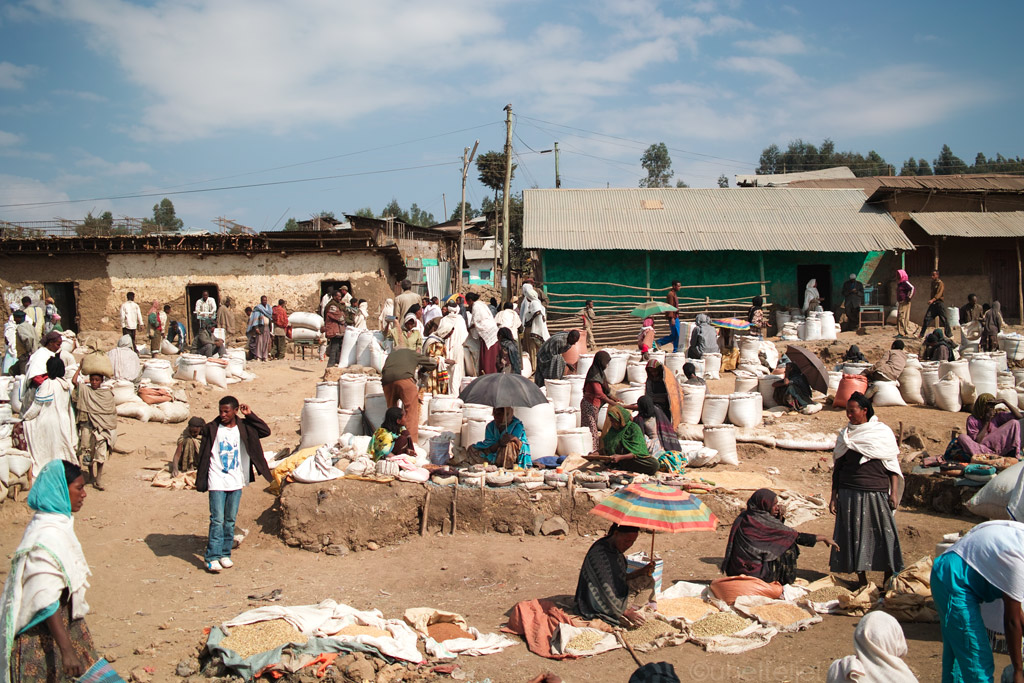
Debark souk.
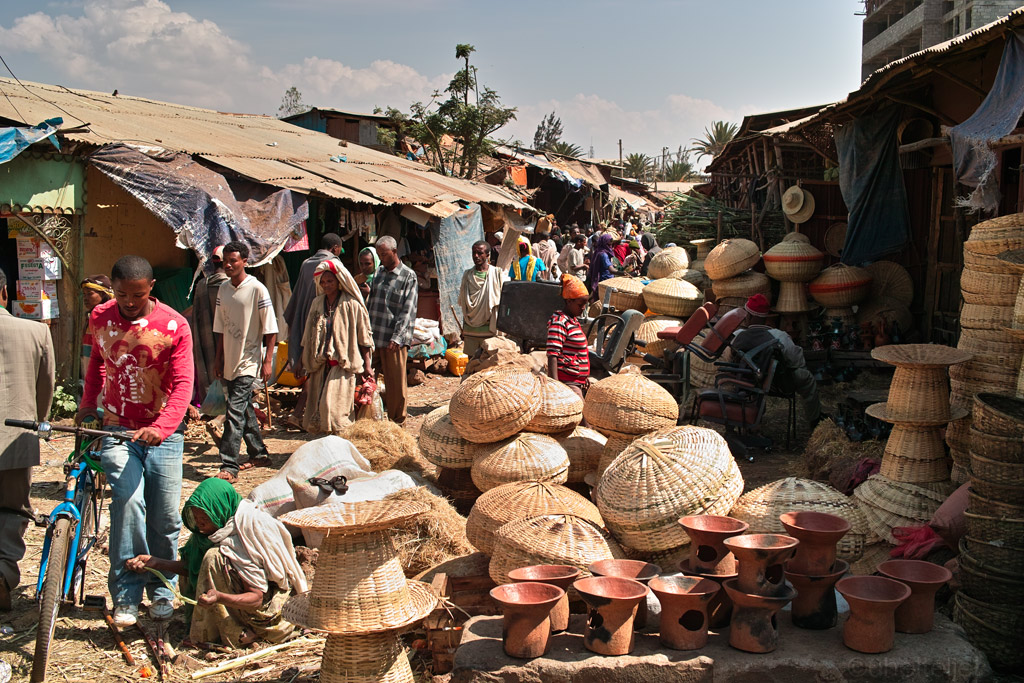
The market in Bahir Dar was a tad more organised.
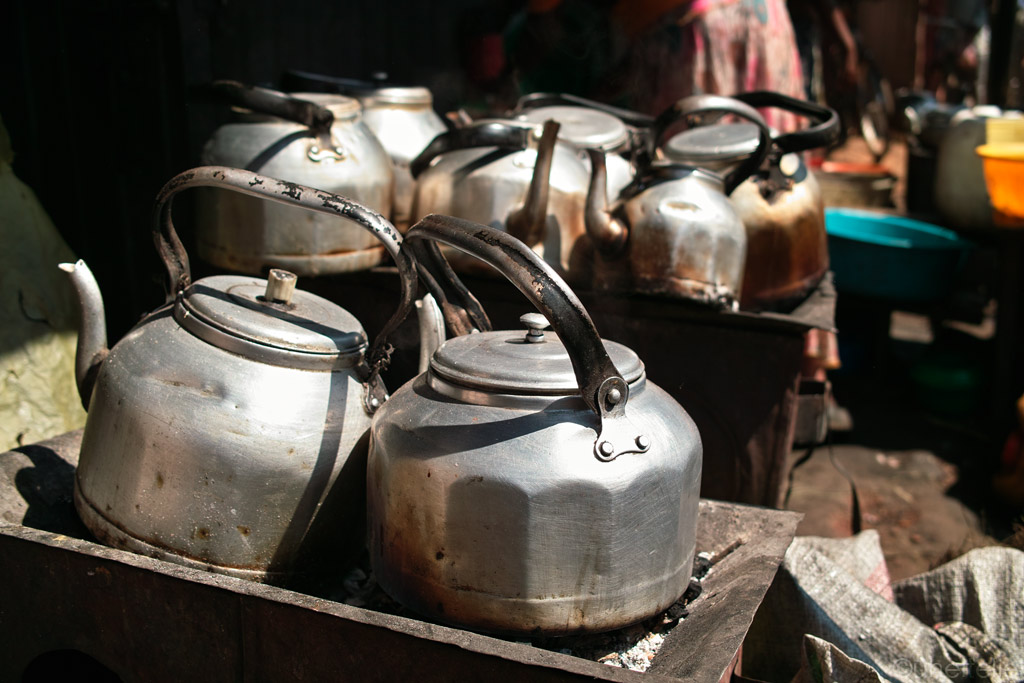
Ethiopian coffee going strong on hot coals - a refreshment for the market shoppers.
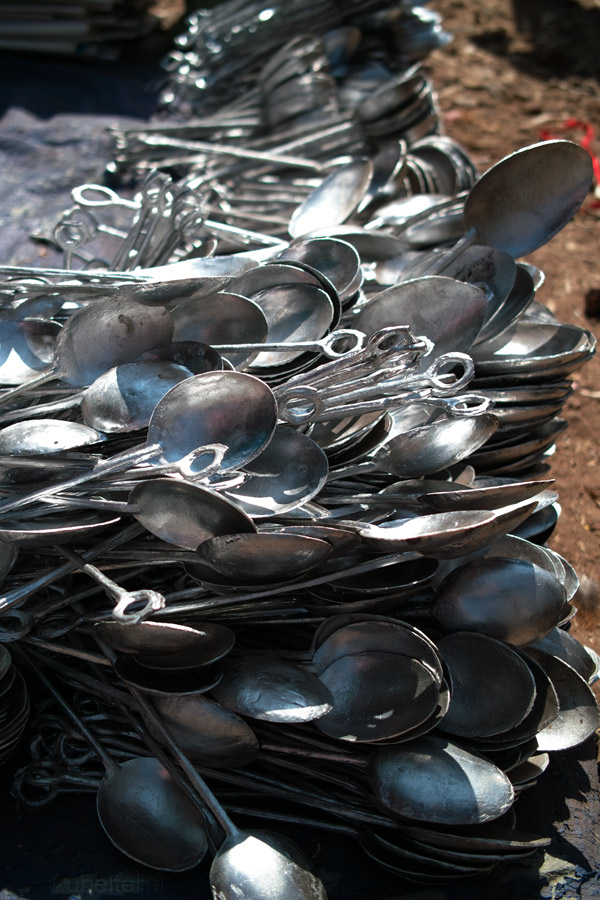
Spoons for sale.
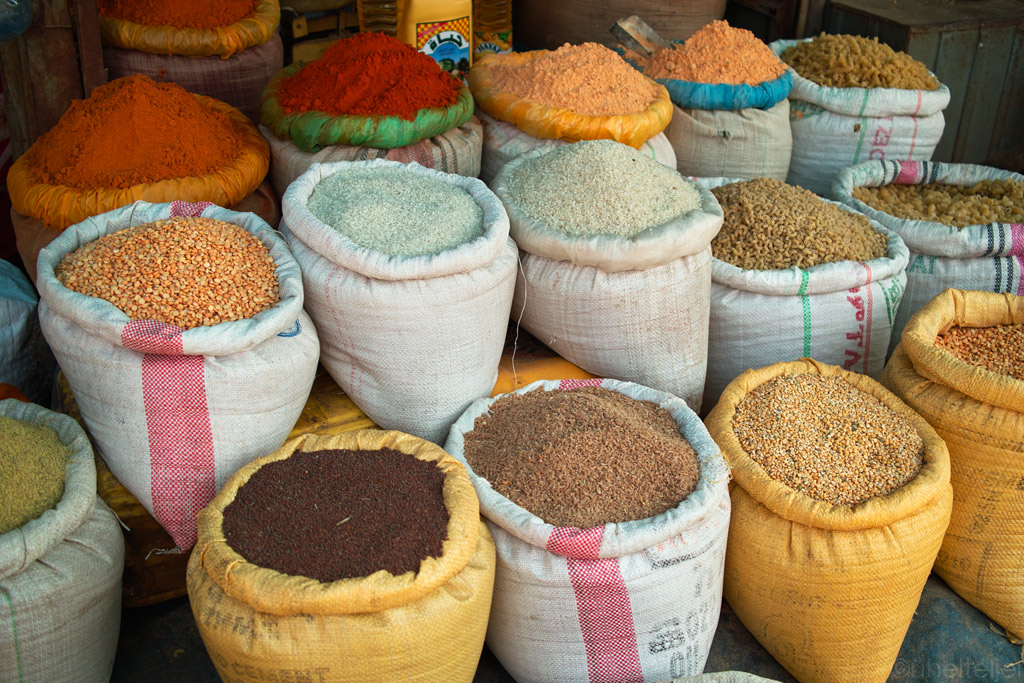
Stuff at Bahir Dar souk.
Bahir Dar is located on the shores of the largest lake of Ethiopia, Lake Tana. The lake itself did not really impress - guidebooks rave about the old monasteries on the lake, but we decided we had had enough of religious stuff, so we skipped them and just relaxed in the tropical atmosphere amidst the coffee and other good-smelling plants.
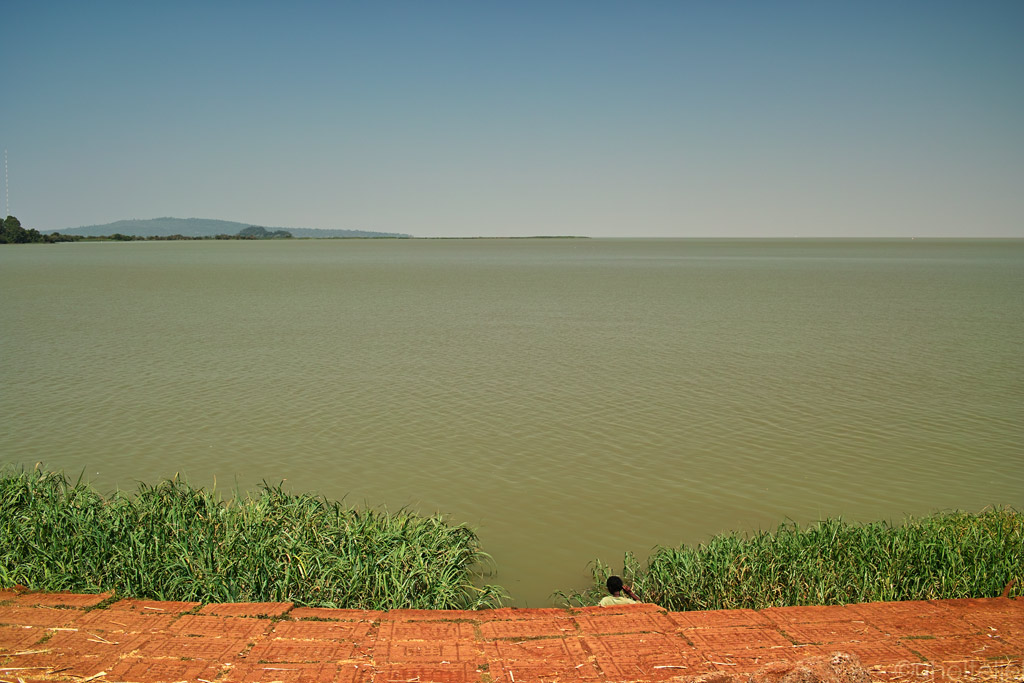
Lake Tana.
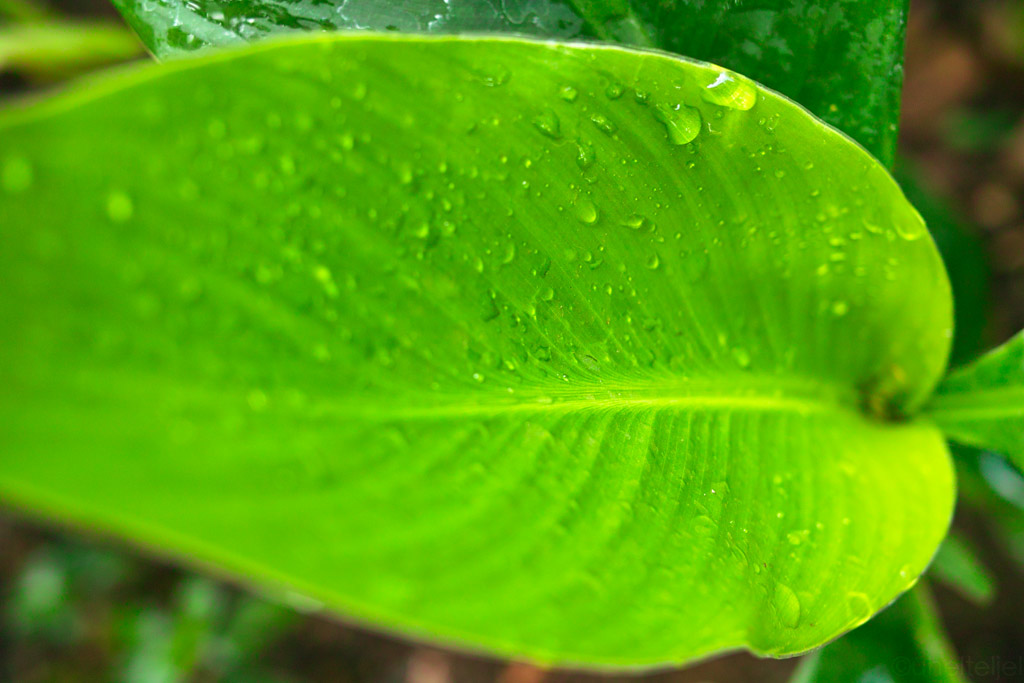
Fresh greenery aside lake Tana.
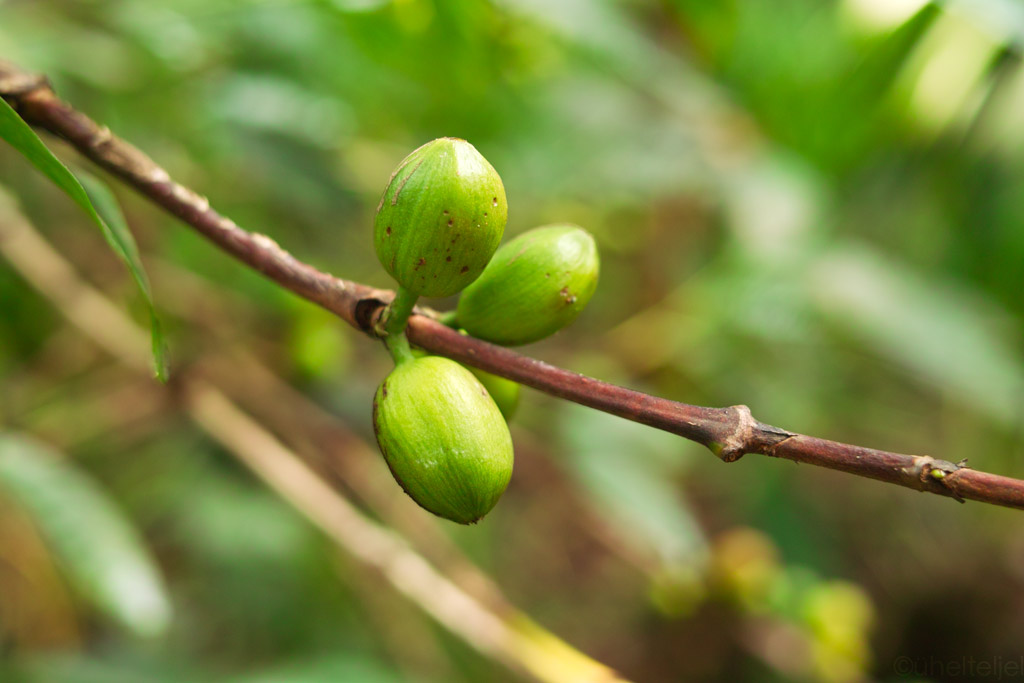
Coffee tree just behind our guesthouse's window - grab the beans, dry and roast and you have your coffee.
As it was pre-Christmas time, one morning there were processions of white-robed people in town, with singing and drums:
But once they passed, the local pop music was again turned on. Ethiopian music is surprisingly and enjoyably original, with distinctive rhythms and harmonies we found to be absolutely tasteful.
Bahir Dar also turned out to be a good place to taste some more local specialities.
For example, for breakfast one can have genfo which is a sort of porridge served with butter and berbere. Very thick, it is normally made of barley flour, and fery filling.
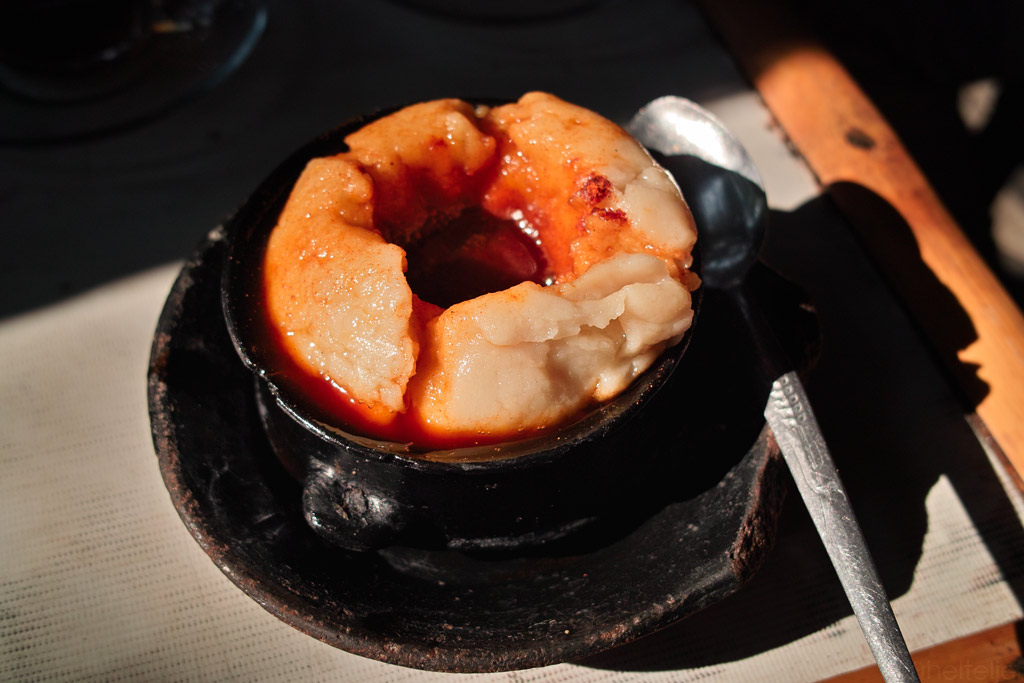
Genfo.
The locals seem to like the variety of injera called fir-fir. It is basically a torn-up injera mixed with whatever sauce, but as always, it is eaten without ustensils so it is quite slippery between the fingers.
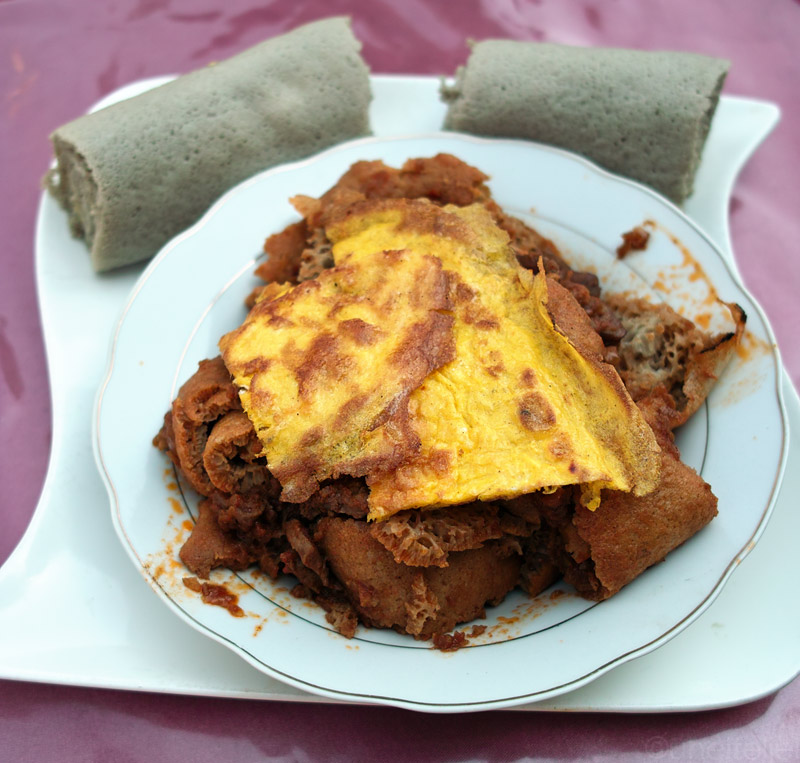
Fir-fir with 2 additional injera rolls.
And a local delicacy called kitfo - injera with warmed-up (not cooked!) mince and a little berbere. May sound gross, but actually quite good! (maybe it would be worth to go and have ourselves checked for tapeworms later though…)
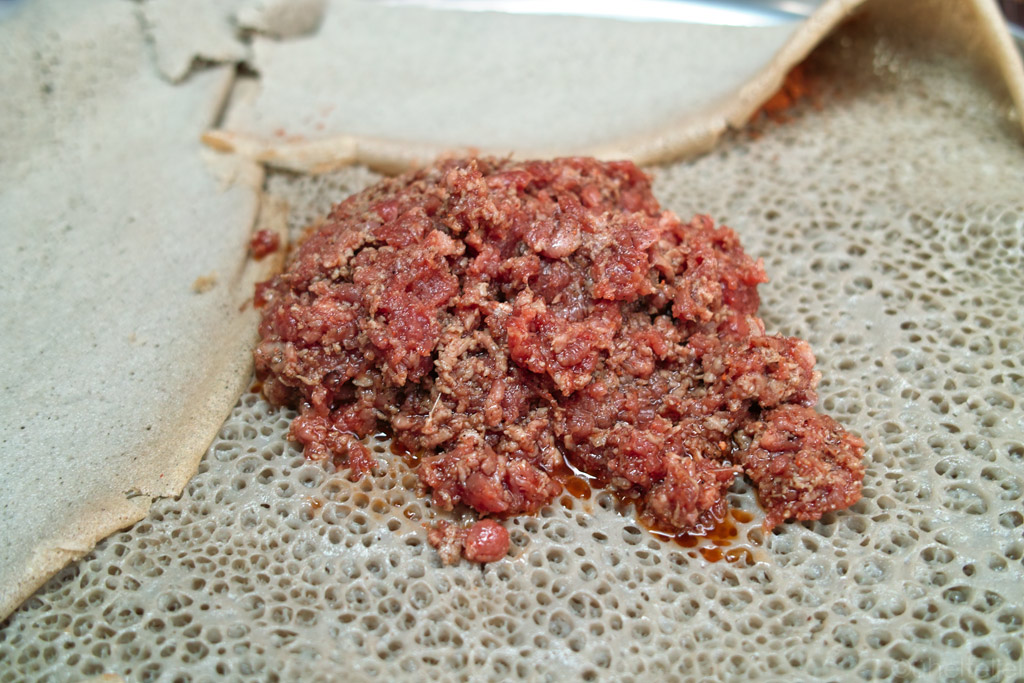
Kitfo - half raw mince.
Surely, a local beer goes well with the food. Ethiopia produces a fair variety of brews, and since they are all cheap, we just keep on trying them out. Even Kariina who normally would only drink beer in sauna or if in desperate thirst, has started to enjoy it. Oh, dear!
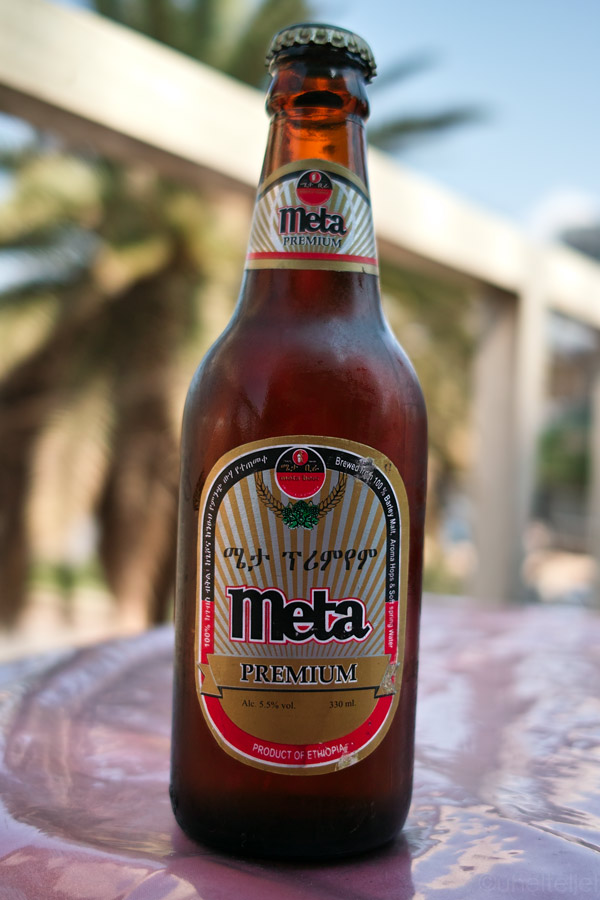
Ethiopian beer - costs exactly the same as bottle of Coca-Cola!
When we arrived in Addis Abeba there was a lot of good Ethiopian music playing from TV. Being tired of western pop and hiphop, the Ethiopian music videos do have a certain charm in them with the love of countryside and fantastic choreography (try to perform those sharp dance movements yourself - not!)
<object width="640" height="505"><param name="movie" value="http://www.youtube.com/v/0lL5uGObHNo?fs=1&hl=en_US"></param><param name="allowFullScreen" value="true"></param><param name="allowscriptaccess" value="always"></param><embed src="http://www.youtube.com/v/0lL5uGObHNo?fs=1&hl=en_US" type="application/x-shockwave-flash" allowscriptaccess="always" allowfullscreen="true" width="640" height="505"></embed></object>
We only stayed in Addis Abeba, the Ethiopian capital, long enough to get our Kenyan visas (normally they are available on arrival but we were planning on crossing the Ethiopia-Kenya border in a place where there is no border post, so we had to do it in advance). Just like other African cities we had seen so far, Addis was more like an overblown village, and not a really attractive one, so we did not linger.
Exiting the capital towards the south, having stopped at a fuel station we discovered that the rear brake had given up its work contract, so we proceeded a little more cautiously, relying on the front brake only. This is also where we recorded the lowest fuel consumption on our trip - the recent cruising on curvy mountain roads, with smooth accelerations and decelerations had only taken 4,2 liters per 100 km, which is not bad for a heavily loaded 12-year old big bike running on poor quality Ethiopian petrol. Not to mention the non-existant aerodynamics of the boxer GS. They've built them bikes good.
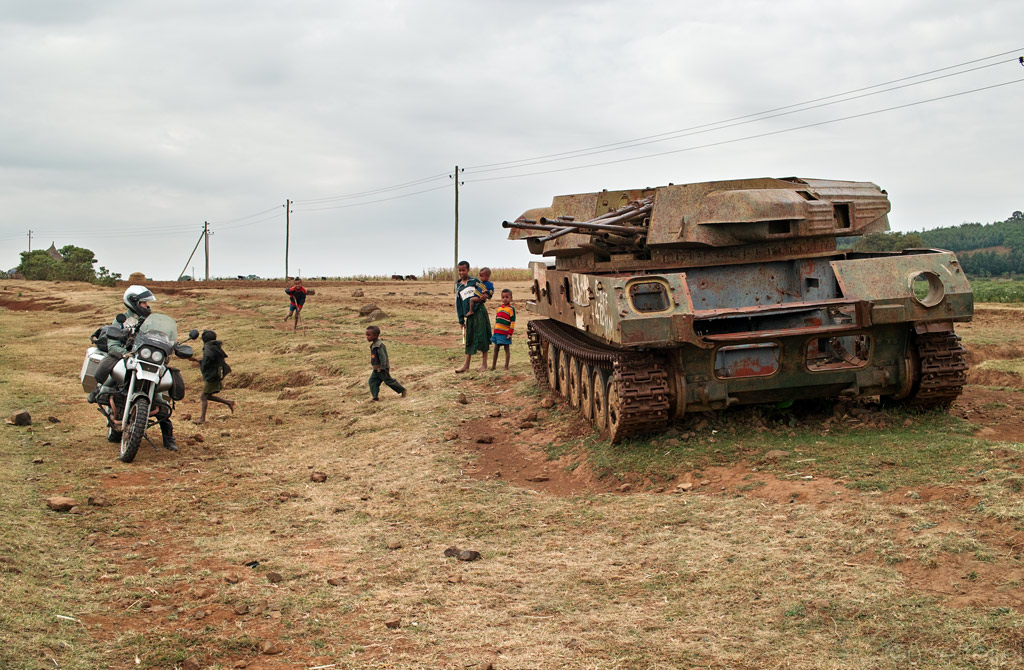
A tank in the fundamentally best and most humane position - abandoned and rusting.
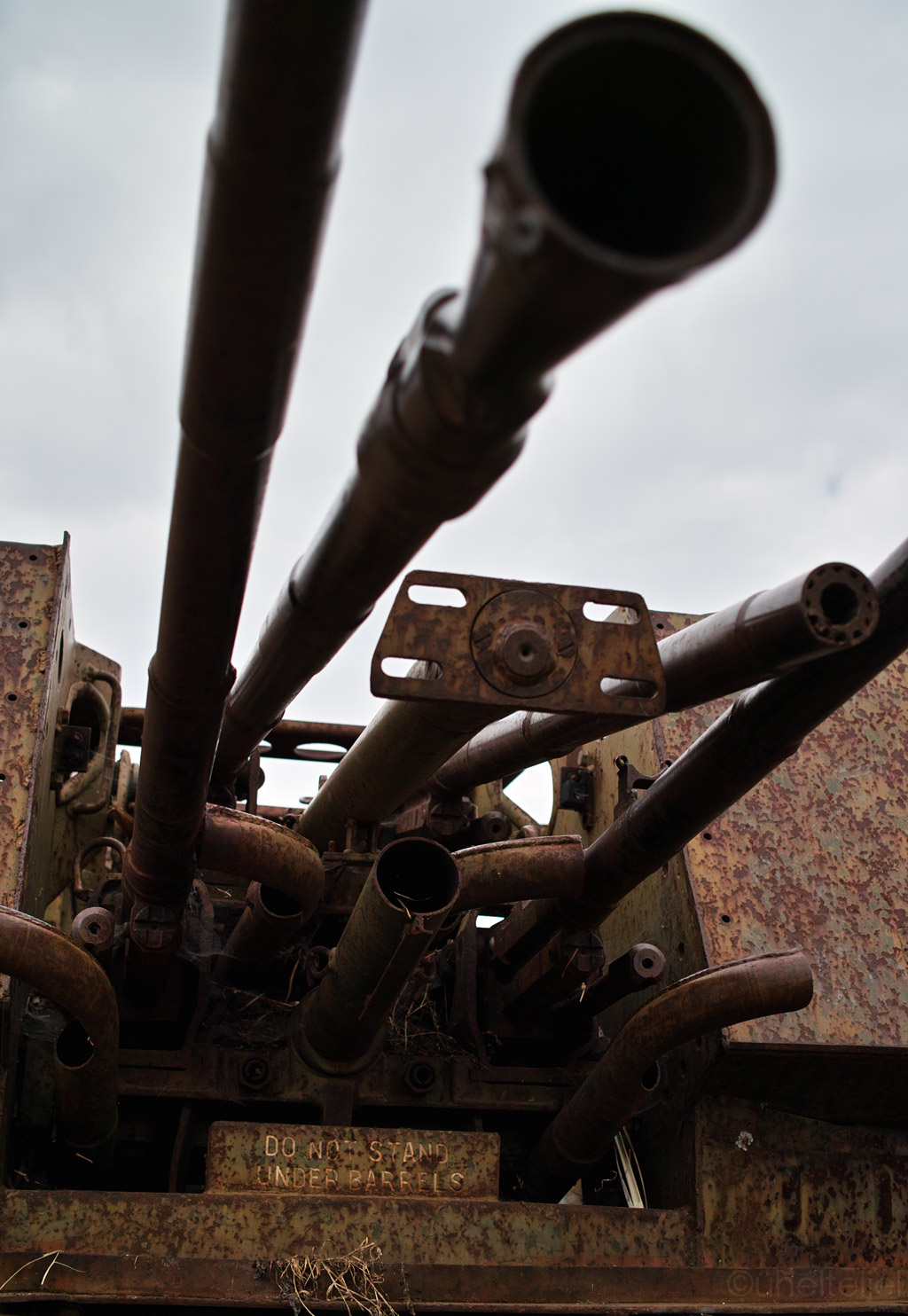
Barrel warning.
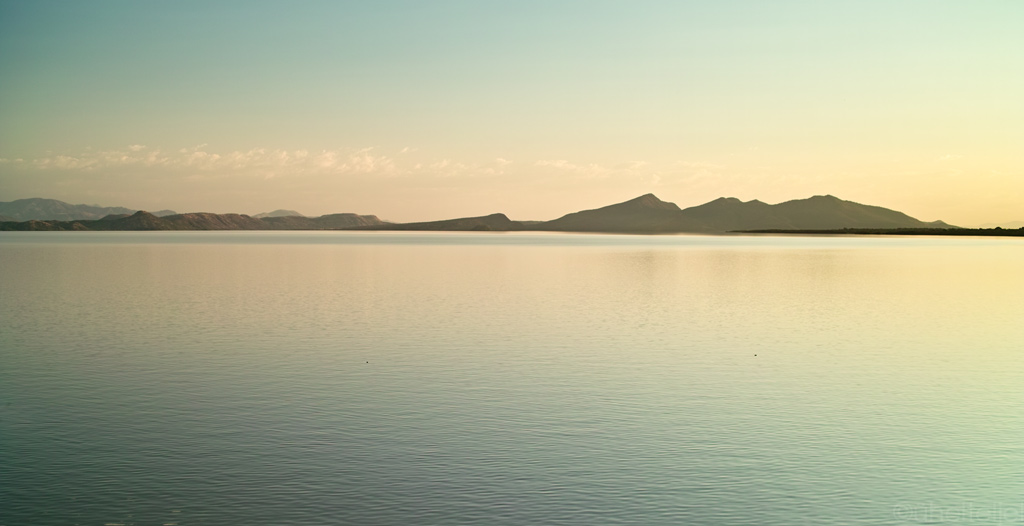
Lake Abaya.
Arba Minch, a town near Lake Abaya, is the last official place to get petrol for the next 1000 kilometers or so if going south-west - after that one can only rely on petrol from a barrel in someone's backyard, if there is left any, and which of course is of dubious quality but nevertheless costs double the official price. So we filled the tank and an additional 10-litre jerry can that would normally give us autonomy of 800 kilometers or so, but the expected harsh conditions and a few unplanned detours would require us to replenish the supply "unofficially" along the way anyway. And as we found out soon, it isn't necessarily an easy task - in one village it took us nearly an hour before a jerrycan full of petrol could be collected from here and there.
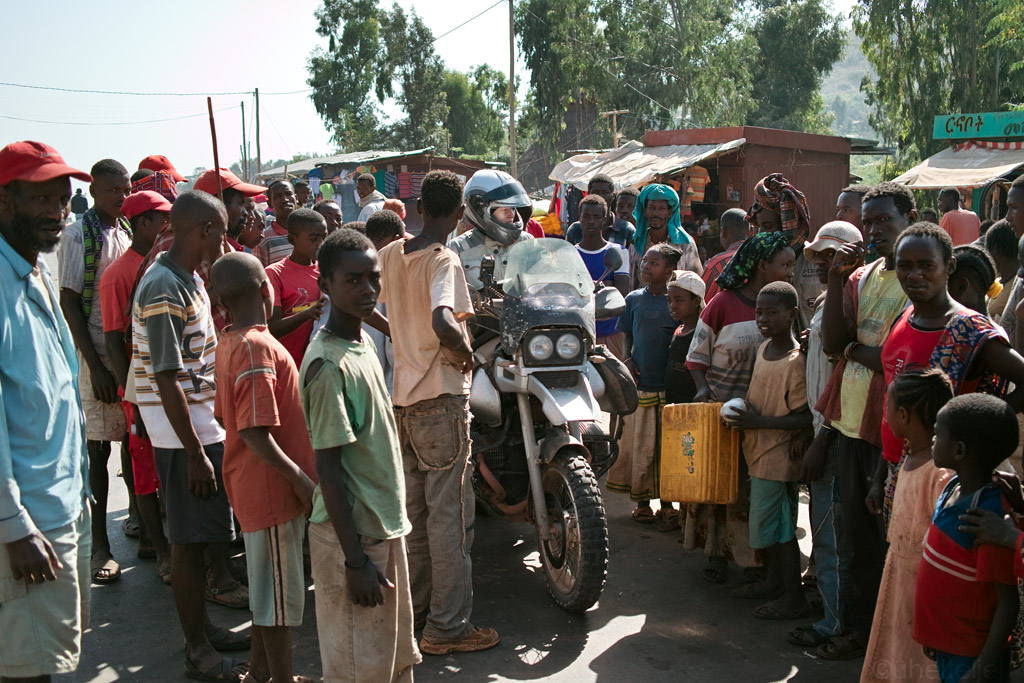
A crowd gathers everywhere we stop.
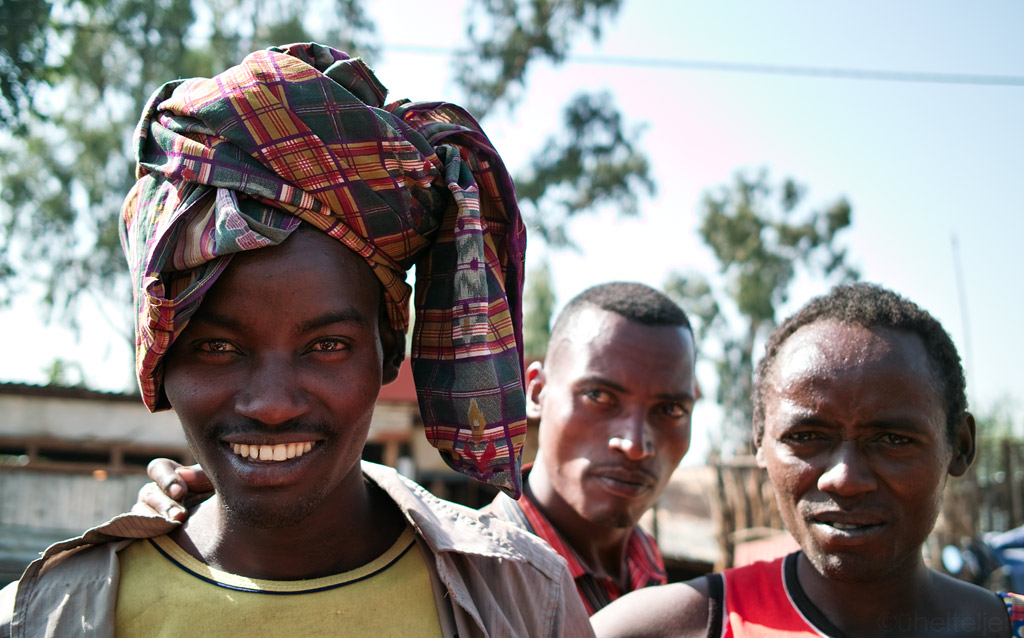
Curious african men.
The further south-west, the rougher became the road, but we were clearly in Hamer territory as we kept on spotting people wearing nothing but goatskins and beads tending their livestock in the bush.
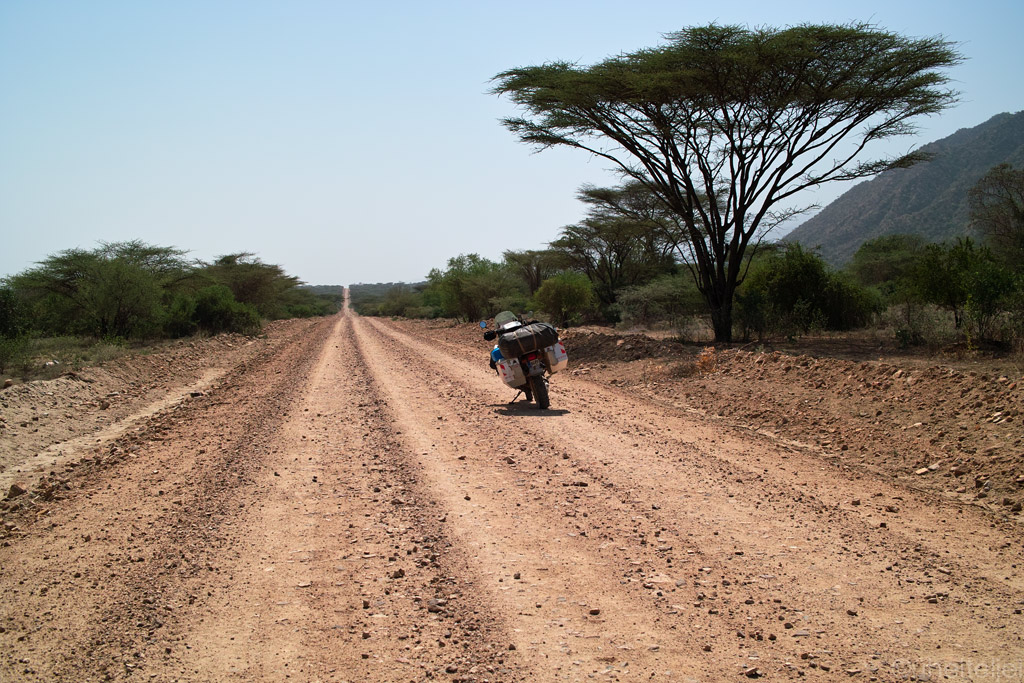
Decent gravel in Ethiopia.
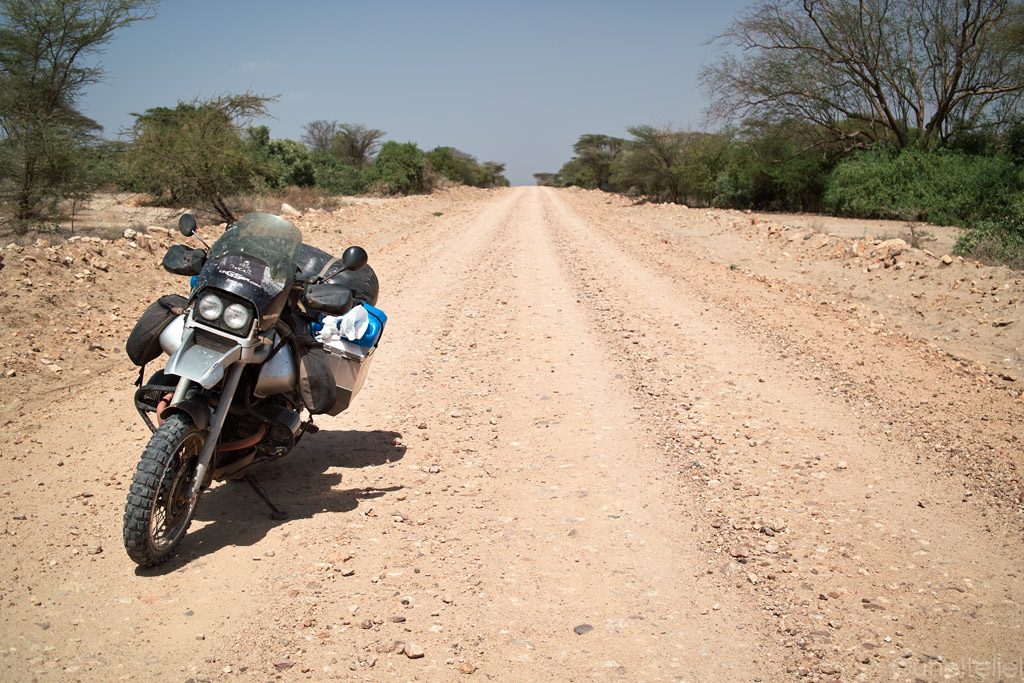
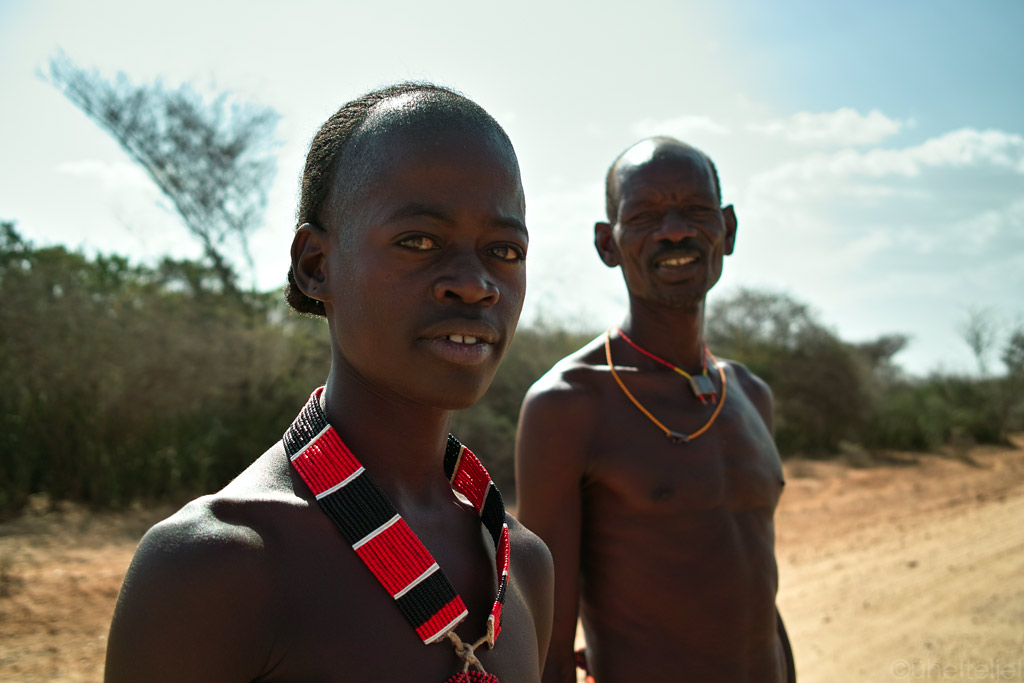
Hamer men we met on the road.
The Hamer people, some 40 000 of them, are one of the many tribes in the Omo valley in South-Western Ethiopia. To get a closer look at them, we decided to visit their weekly market in the village of Dimeka - the Hamer people congregate to Dimeka to sell their produce, wares and livestock from near and far, and of course, their looks and attire are so distinctive and colourful that one would think it is some sort of costumed parade, not a regular market day. In fact, colourful beads and feathers (which men are even more fond of than women) are an everyday accessory, as well as rope-like hairstyle (acieved by applying mud) of the Hamer women. Interestingly, most of those features have nothing to do with rituals or social status - they're just for beauty. And to be honest, the Hamer people do look attractive.
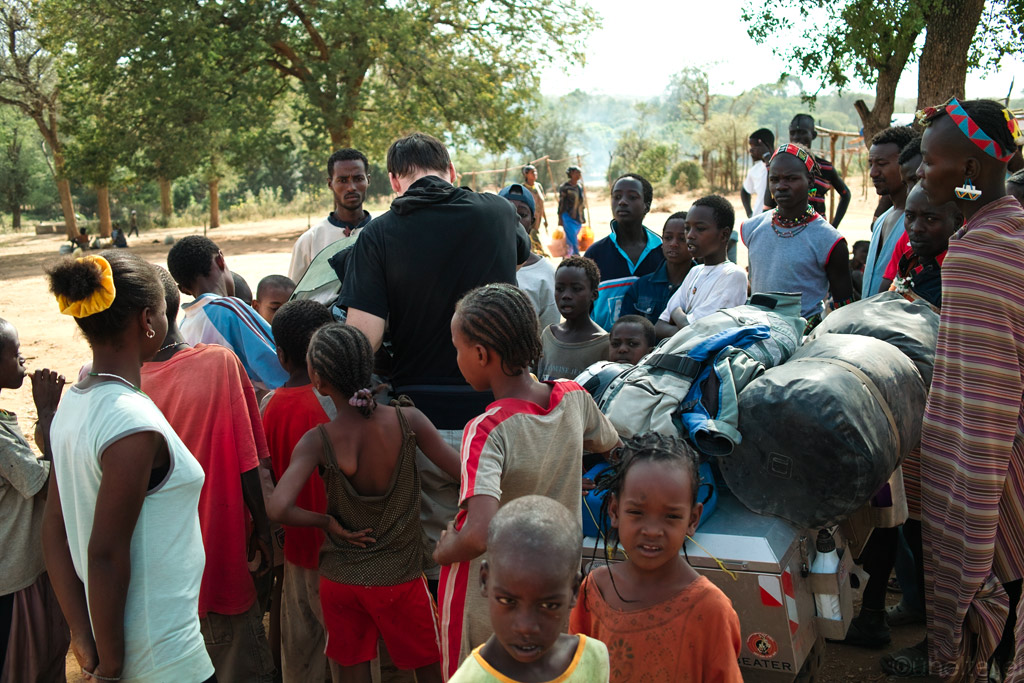
The usual crowd around.
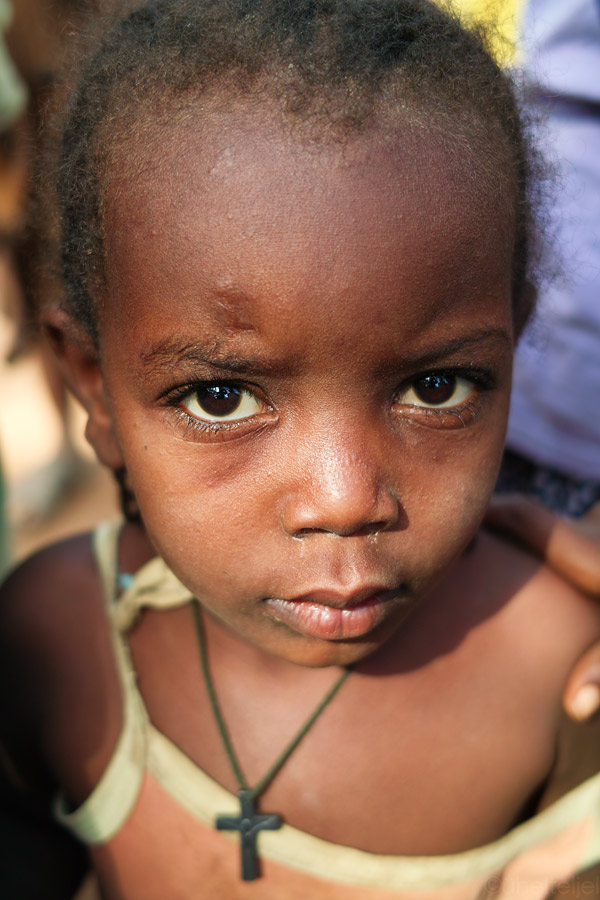
Christian girl who for some reason held Kariina's hand all the time.
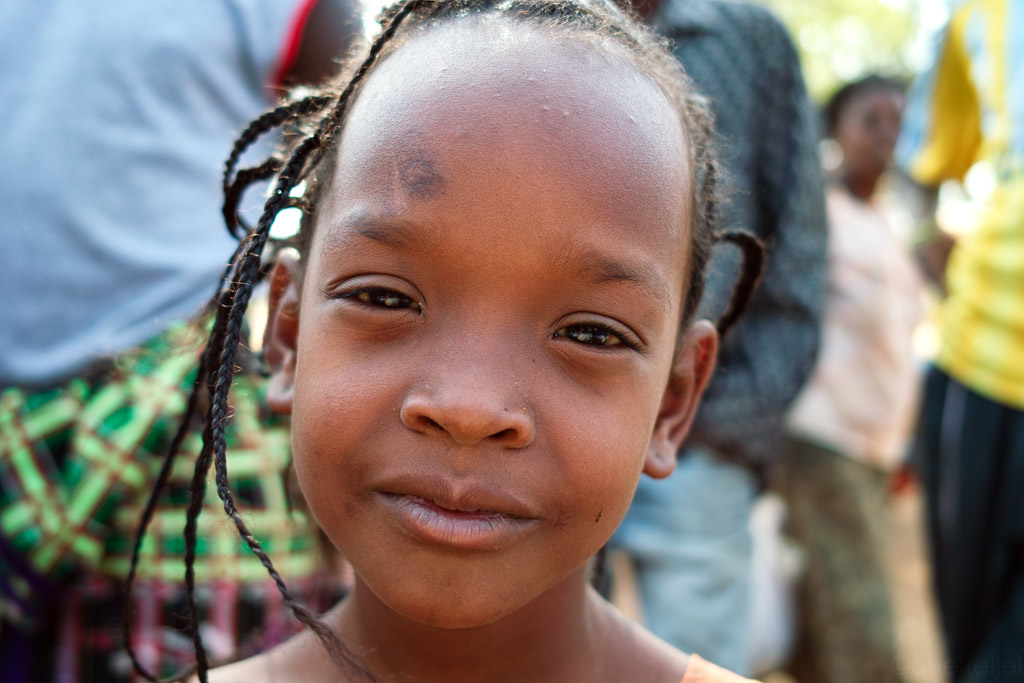
Features in face like out of "Avatar" movie.
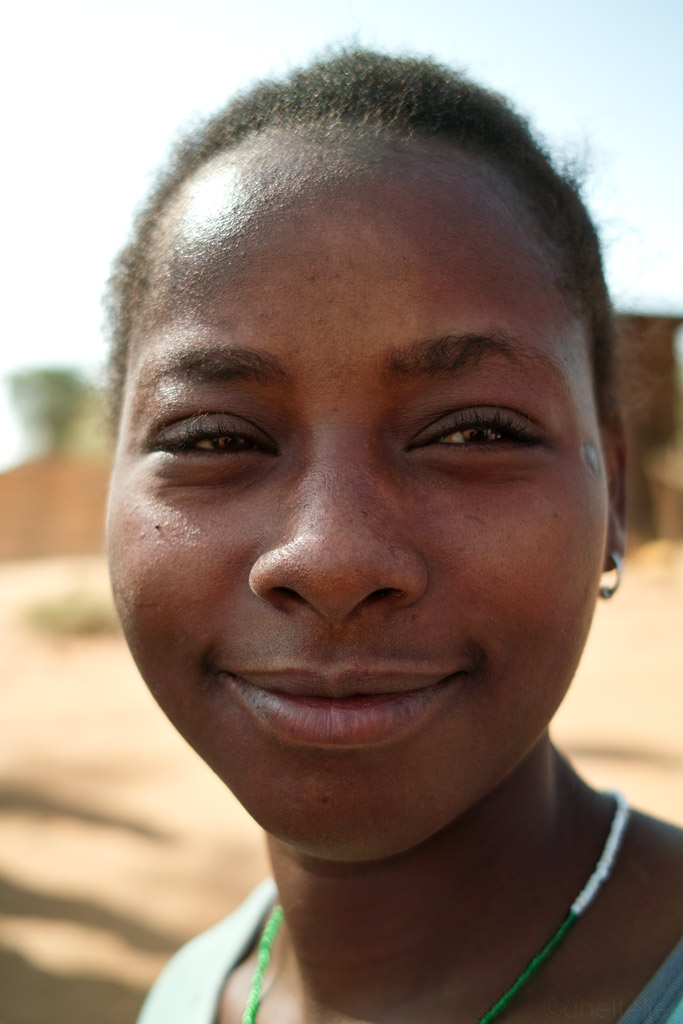
Portrait of an African lady.
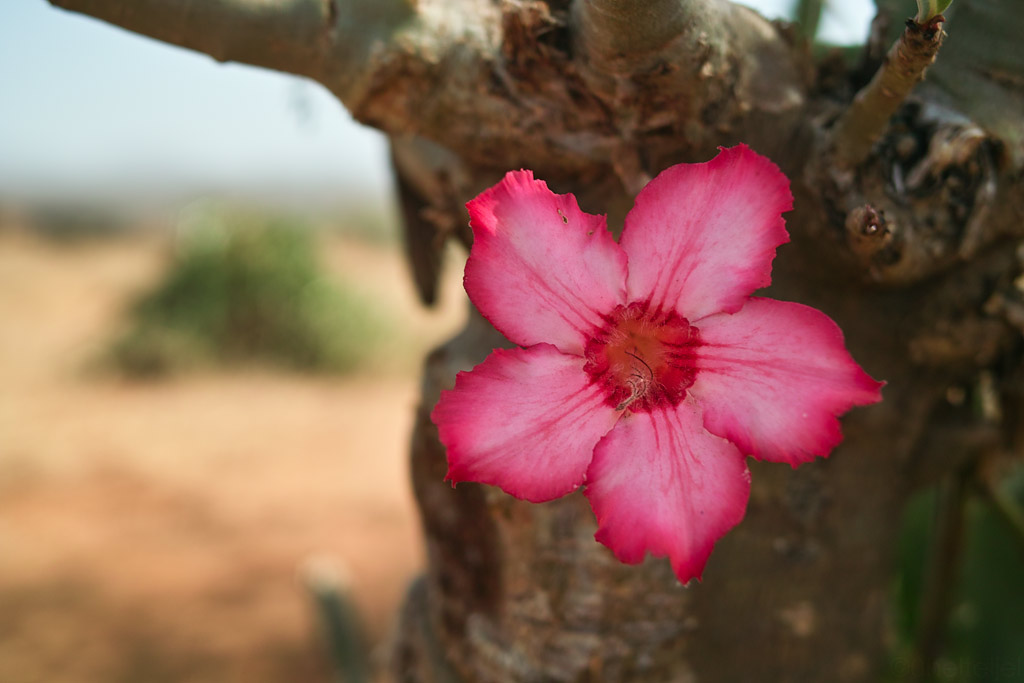
Local flora.
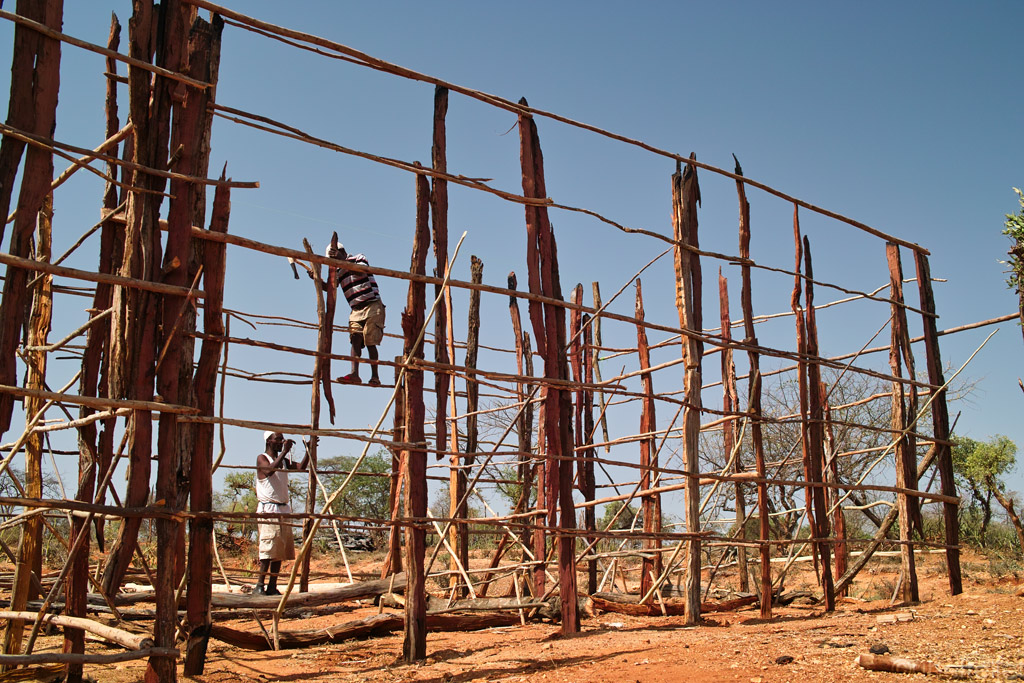
Building a house, African style.
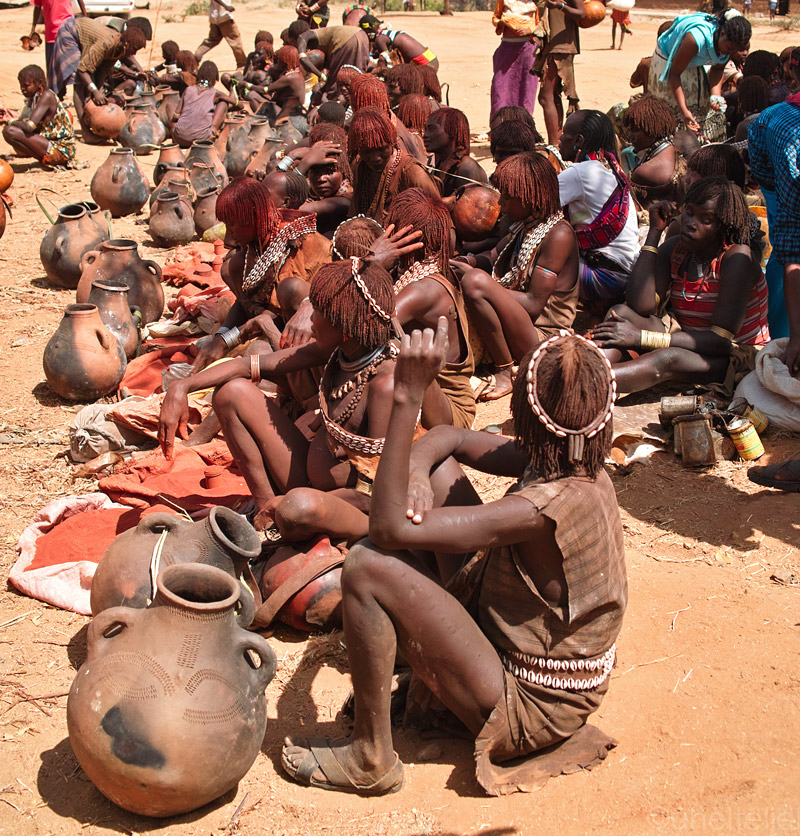
Hamer women selling their stuff in Dimeka market.
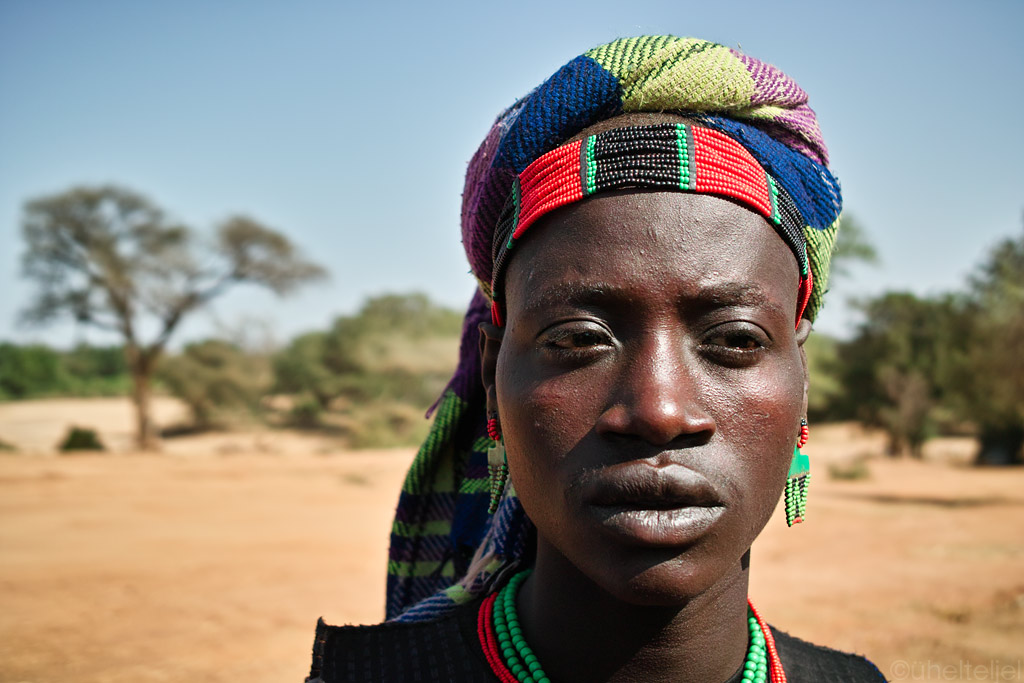
Portrait of a Hamer man.
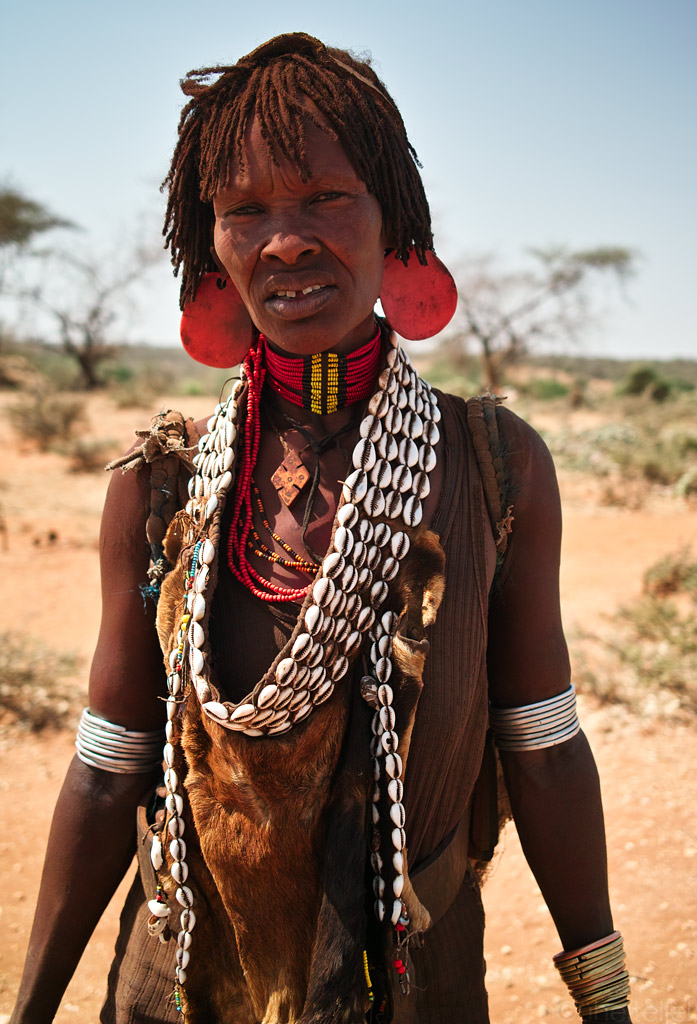
Hamer woman.
While in Dimeka we heard that nearby an important event in a Hamer person's life, a bull-jumping ceremony demarcating the "marriageworthiness", was about to take place. Sure we wanted to get a glimpse of it, so we looked up a guide and set out to find the village in which it was happening.
We arrived and were greeted by a bunch of men in their regular, colourful attire. But to add even more colour to the event, some body painting was going on, and even we got some paint on our face. Then the ladies came - some had more clothing on them, some had less - making lound noise with bangles tied to their legs, and blowing horns. Dancing and singing, they tried provoking men to whip them as the Hamer people believe that scars on a woman's body signify her love and devotion to her husband - the deeper the wounds and the bigger the scars, the more profound the devotion, and consequently the respect from the community towards the woman. So they are not exactly unhappy to be whipped. After an hour of chaotic hornblowing, singing, dancing and whipping, the backs of the women were bleeding and everyone was happy. An intense experience, if you like.
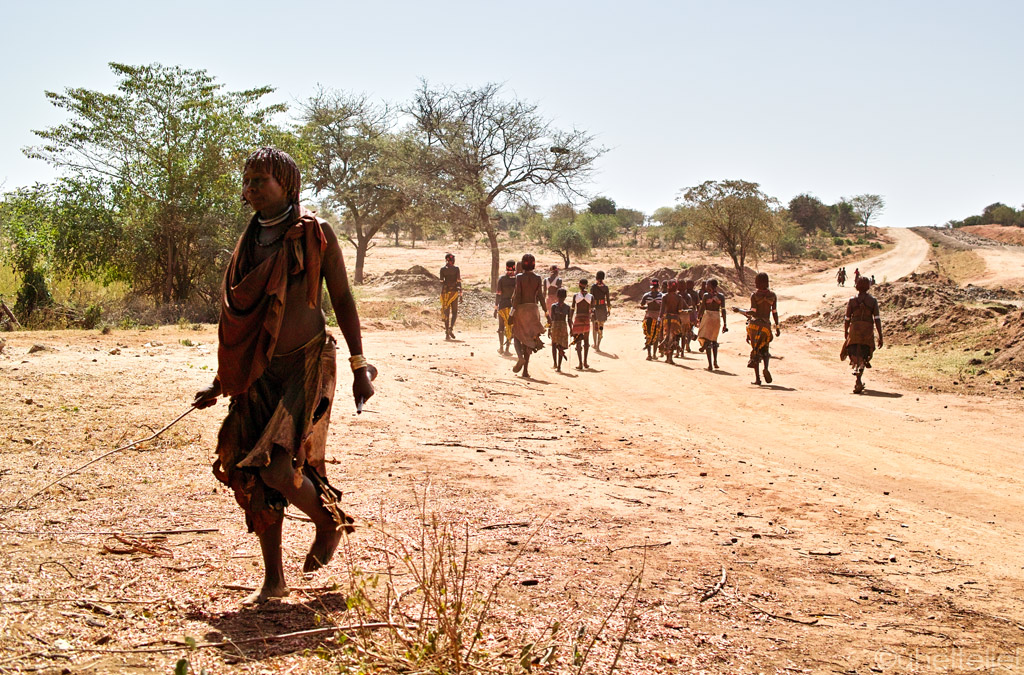
Hamer women on the move - something is about to happen.
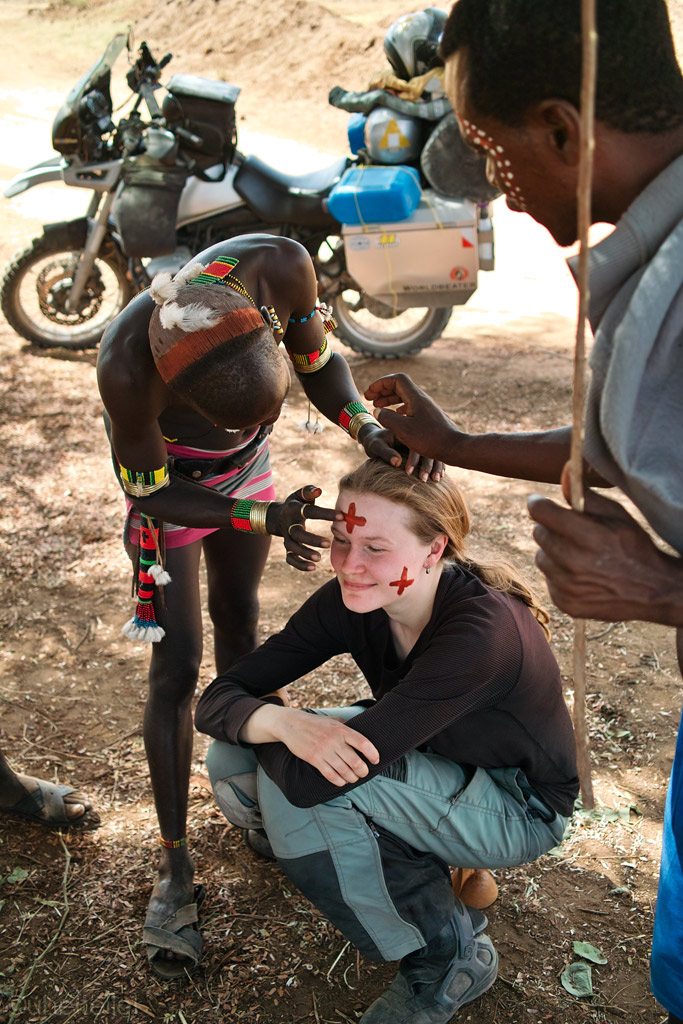
Painting Kariina - they had a lot of fun with it, Kariina too.
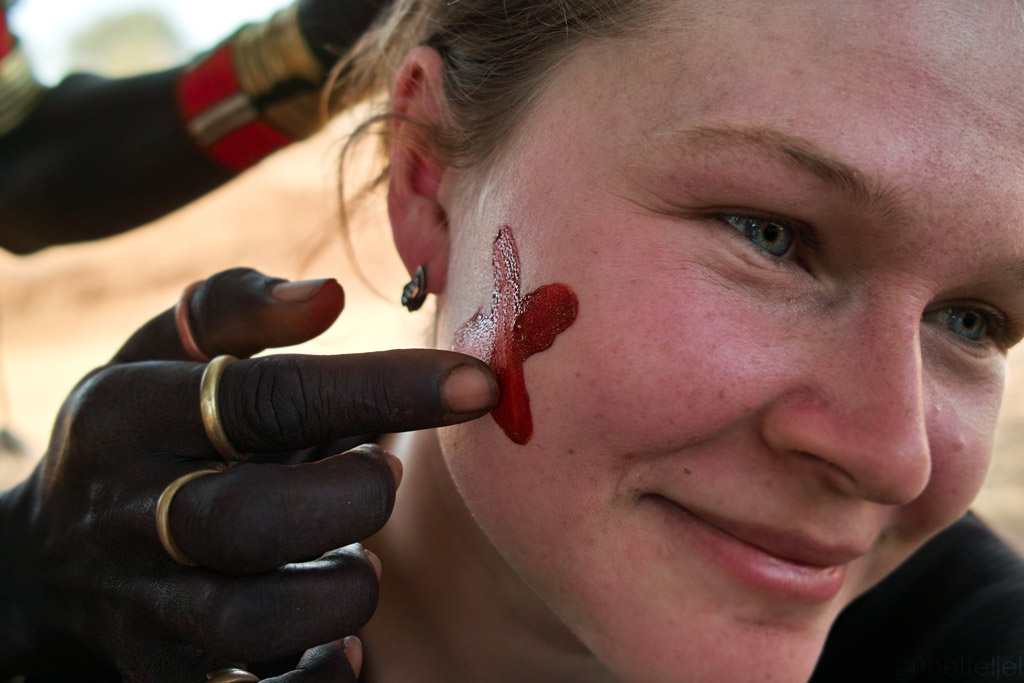
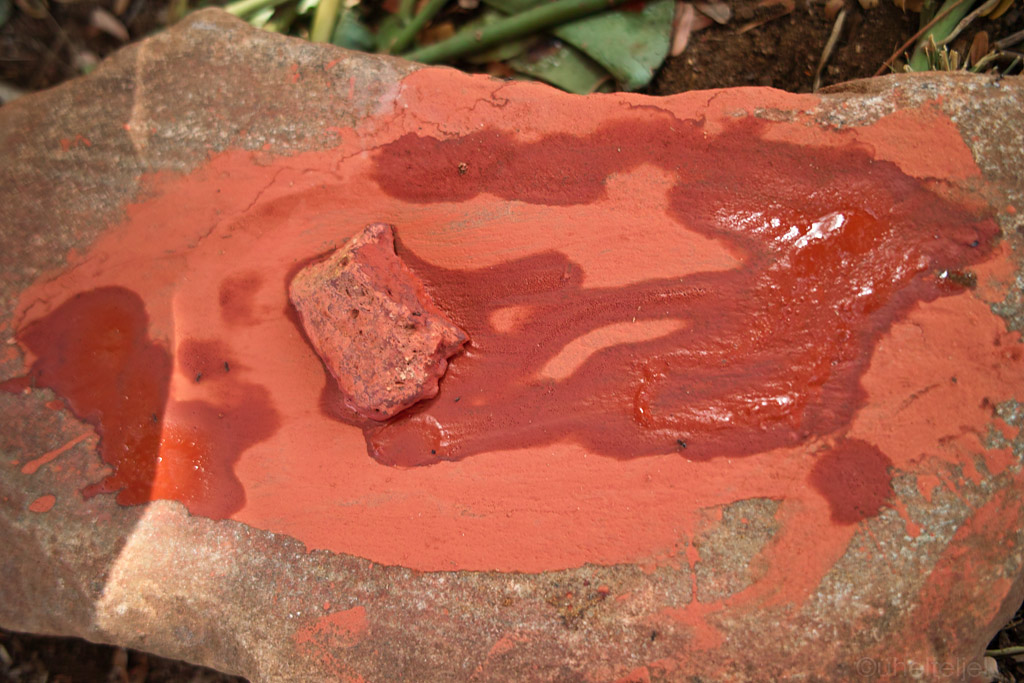
This is how they make paint - it's grinded from rock and mixed with water.
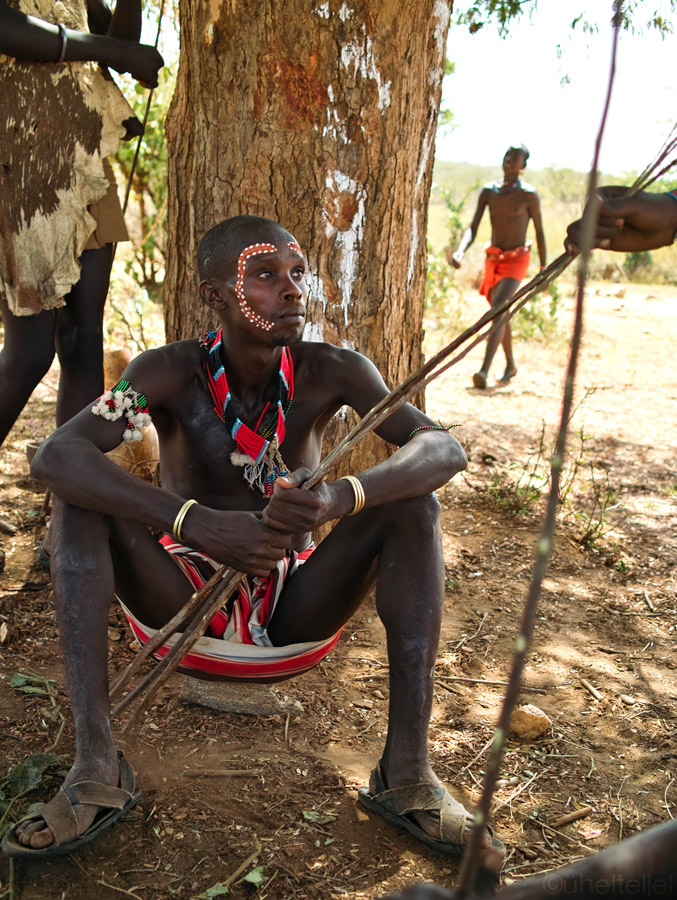
Colourful Hamer tribesmen...
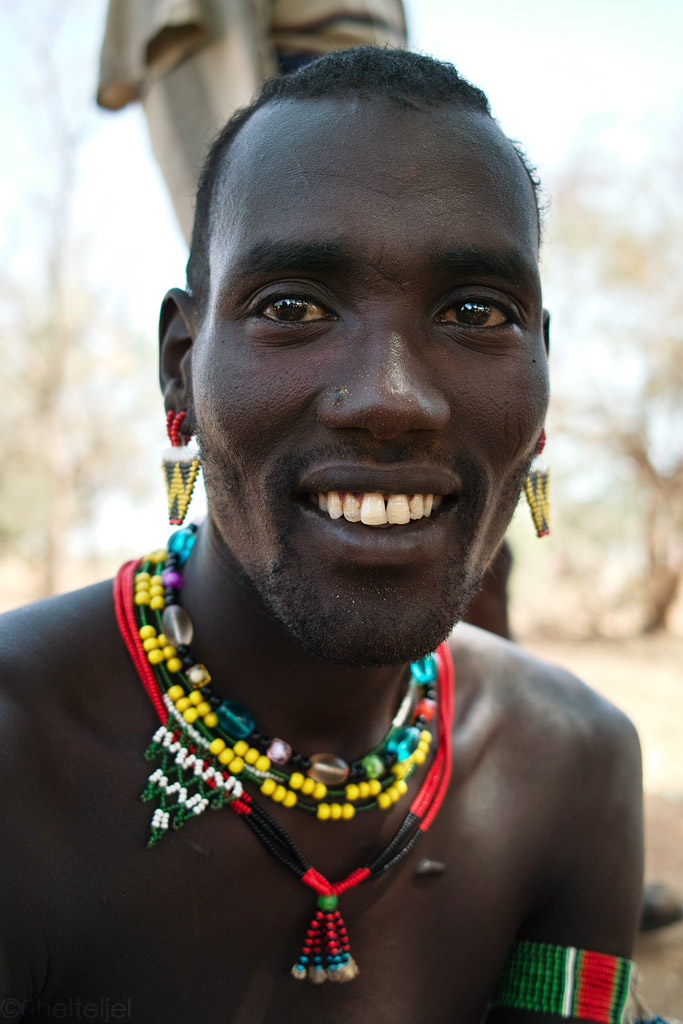
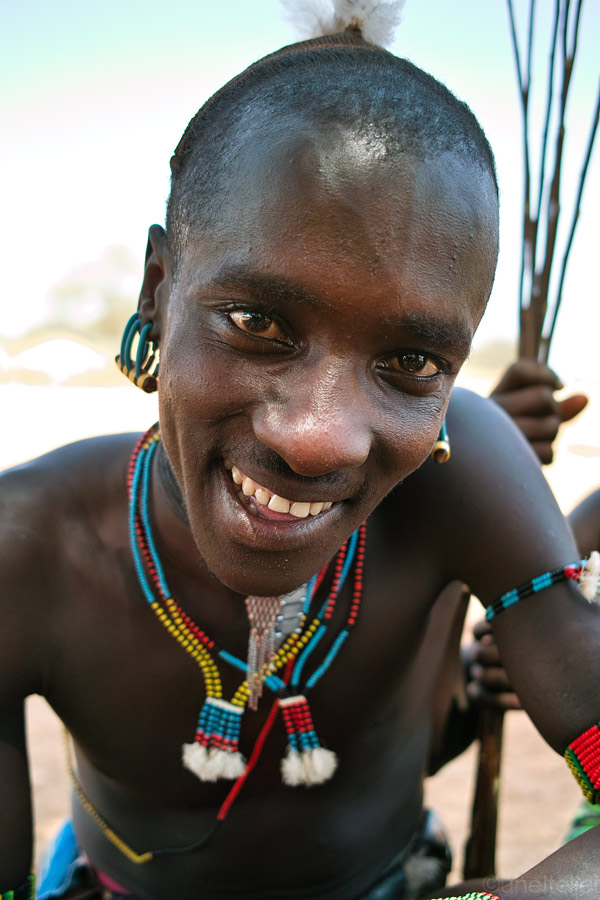
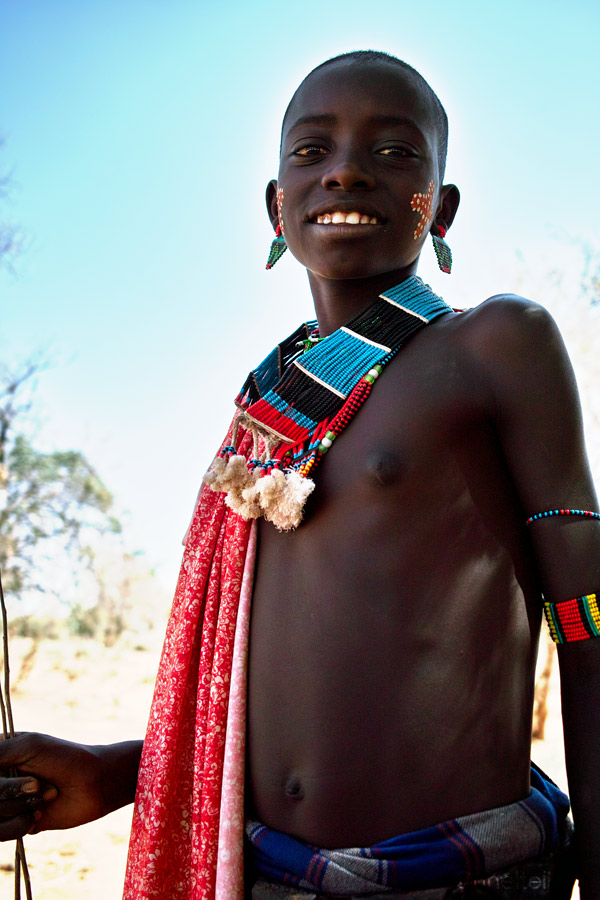
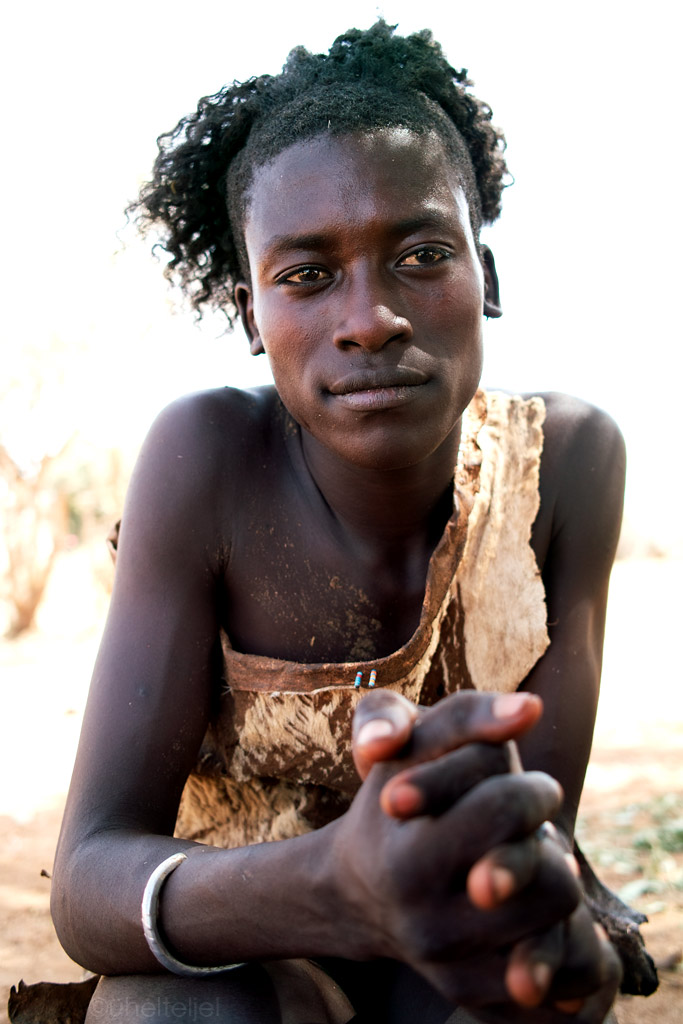
The boy is about to become a man.
It was all accompanied by quite a lot of noise, which sometimes nevertheless resembled some melody:
..:: LISTEN ::..
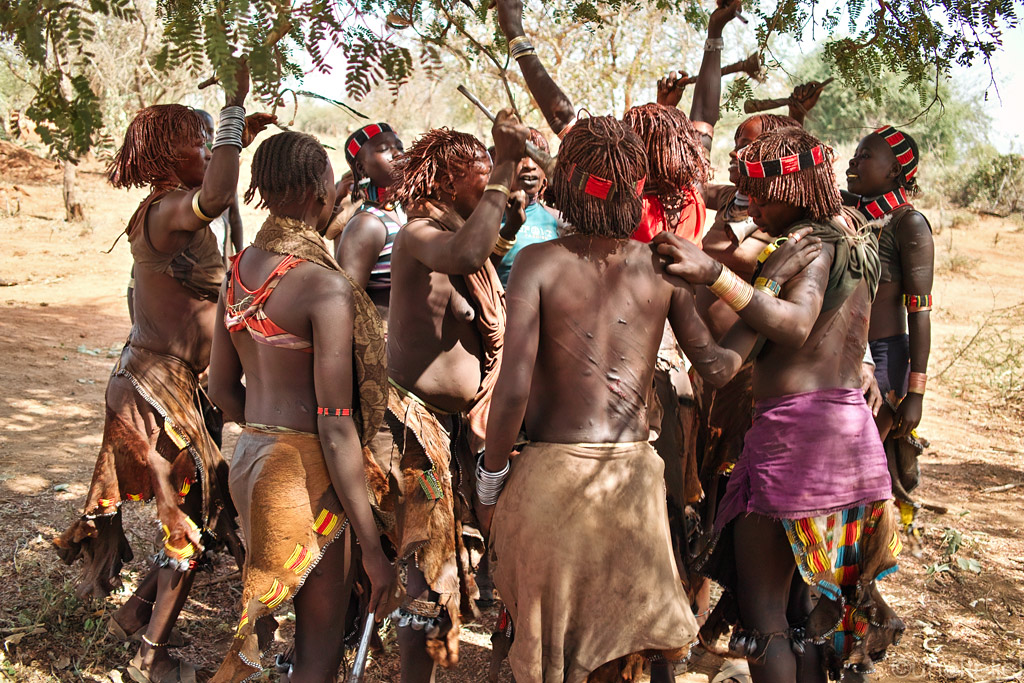
Hamer women dancing.
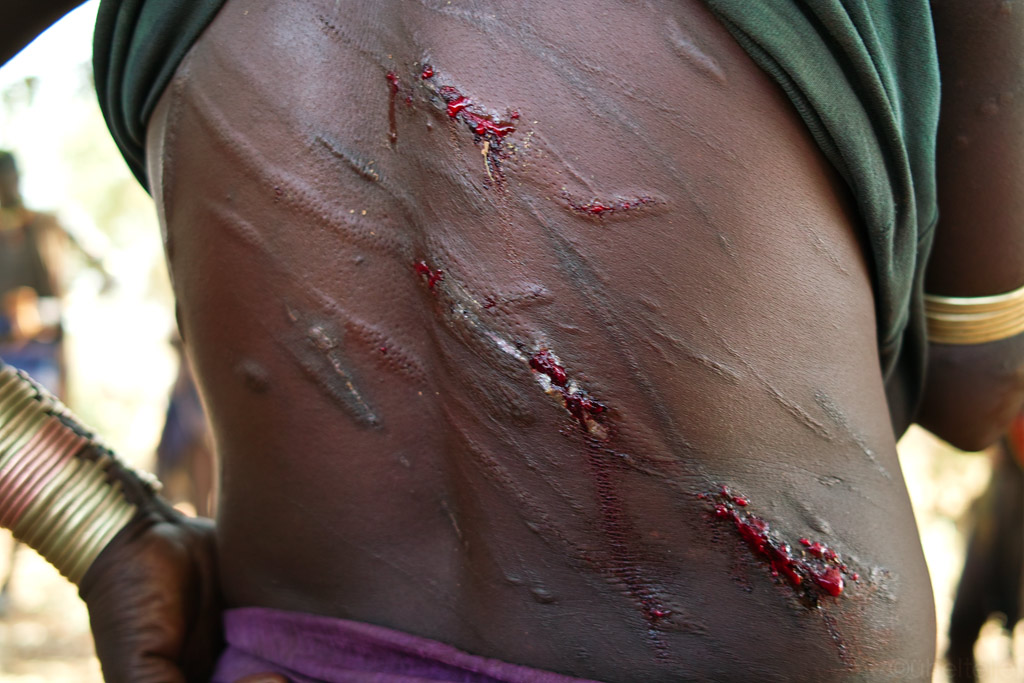
The scars of love, dedication and devotion.
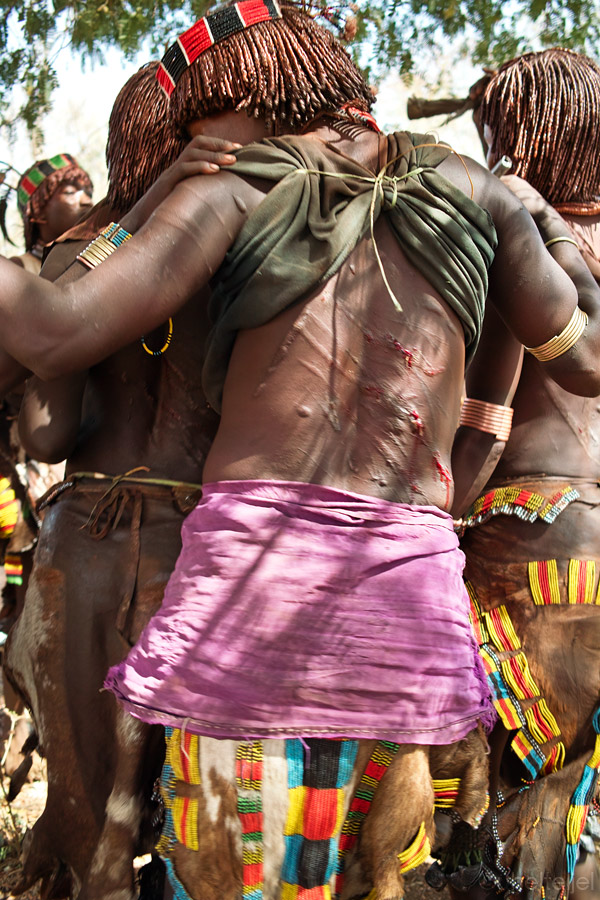
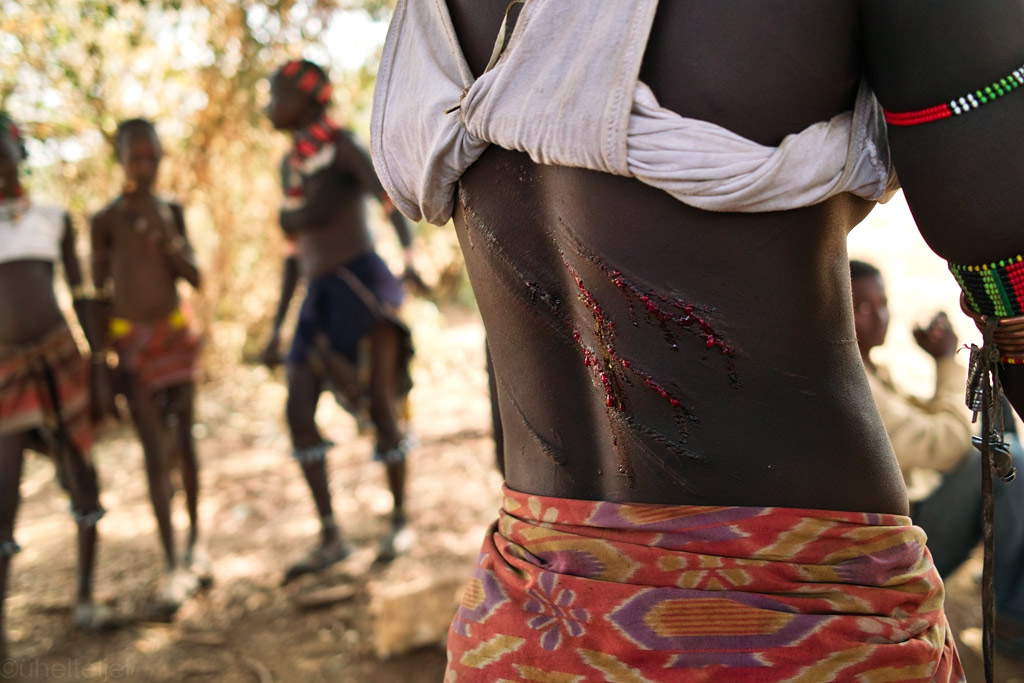
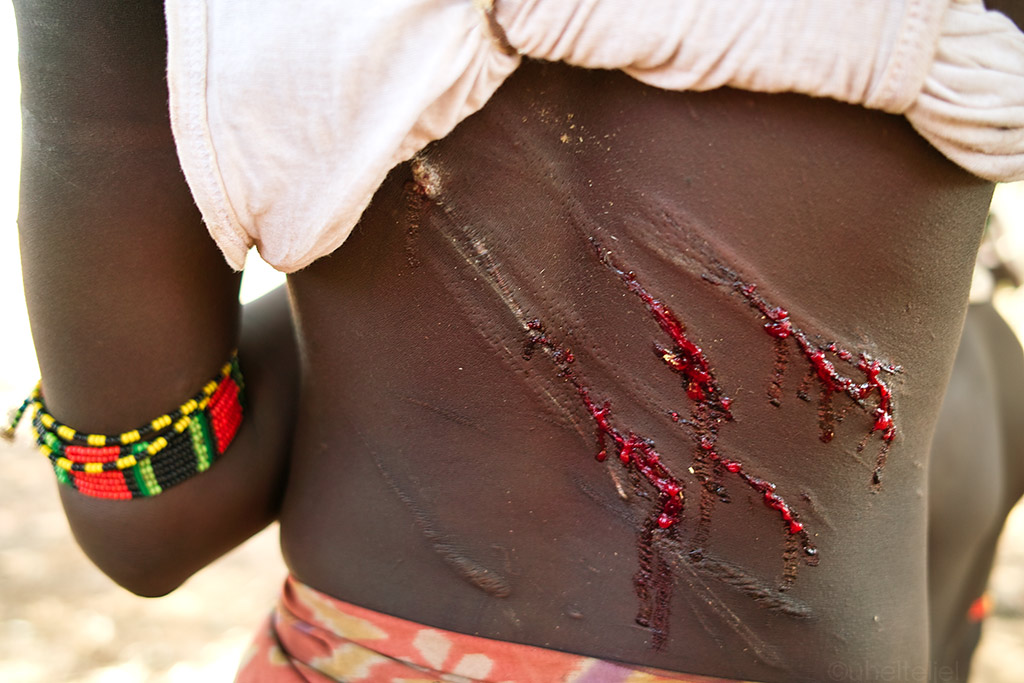
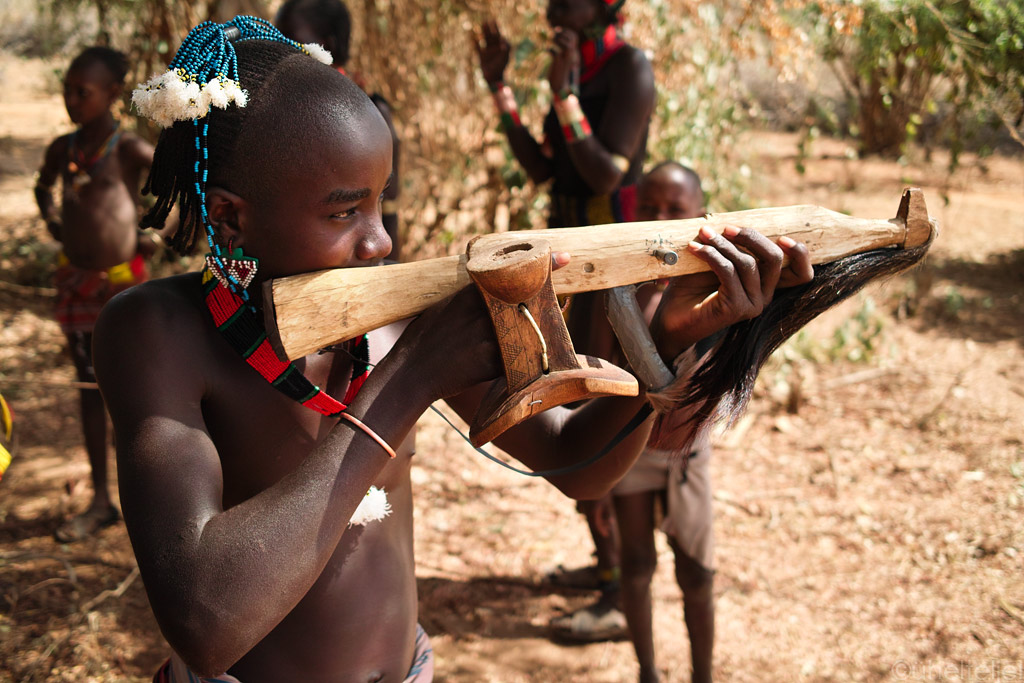
Hamer boy with a playgun - it had some strange meaning in the ceremony.
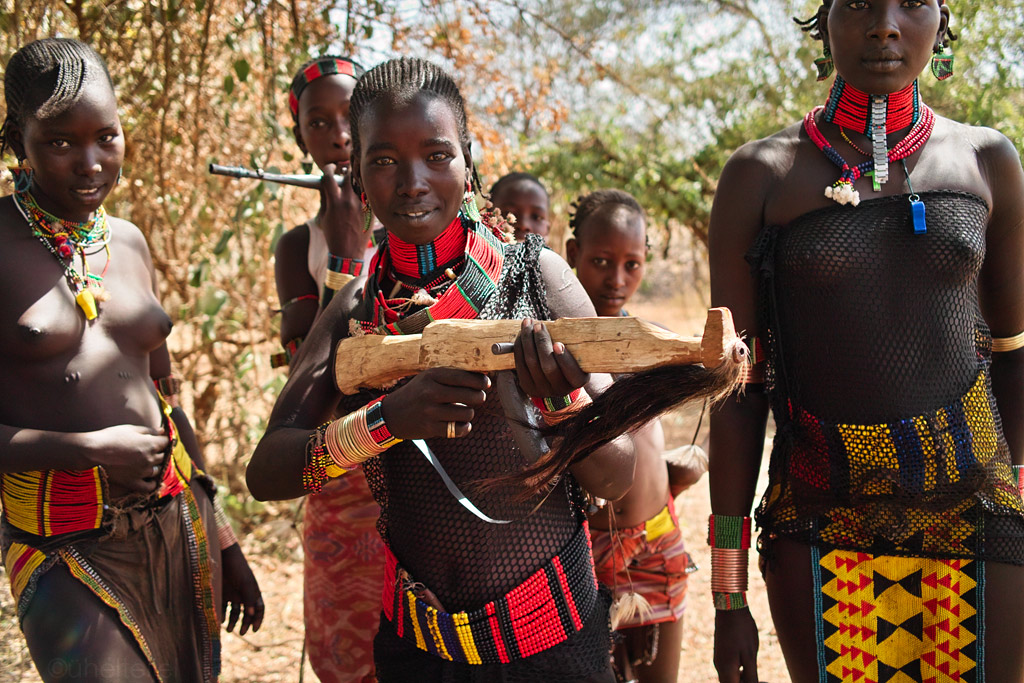
Attractive Hamer ladies posing.
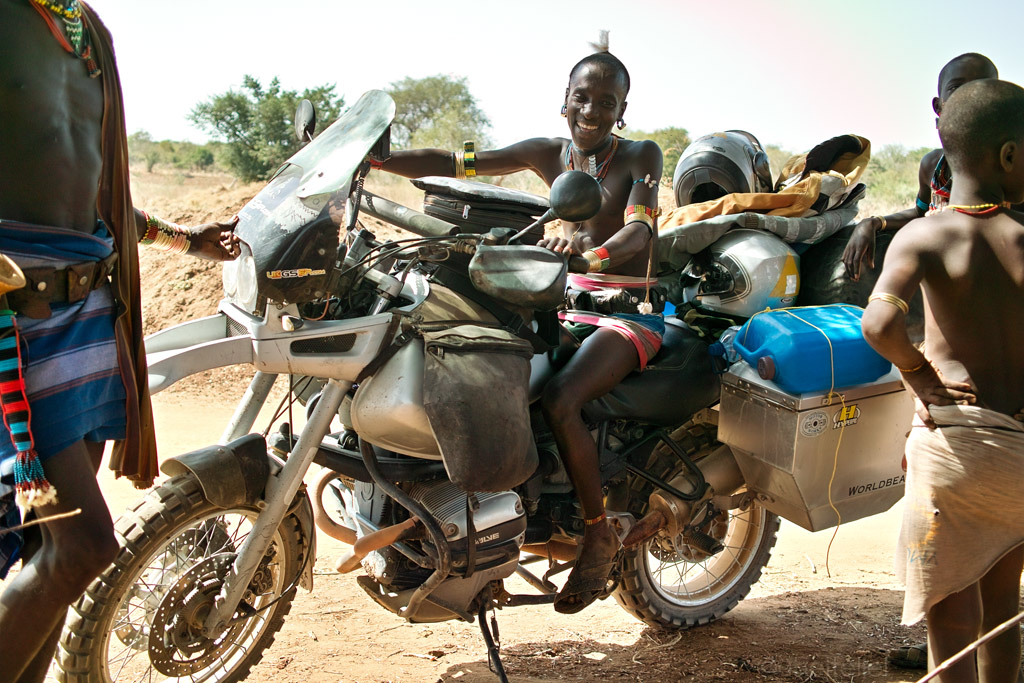
While men were checking our GS out.
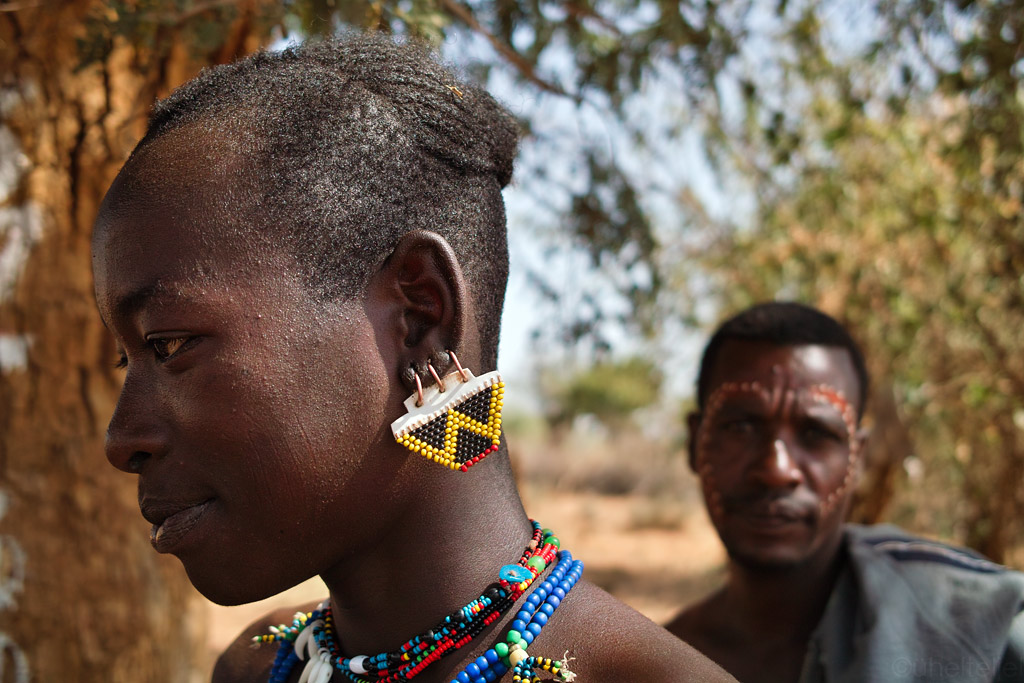
Hamer men.
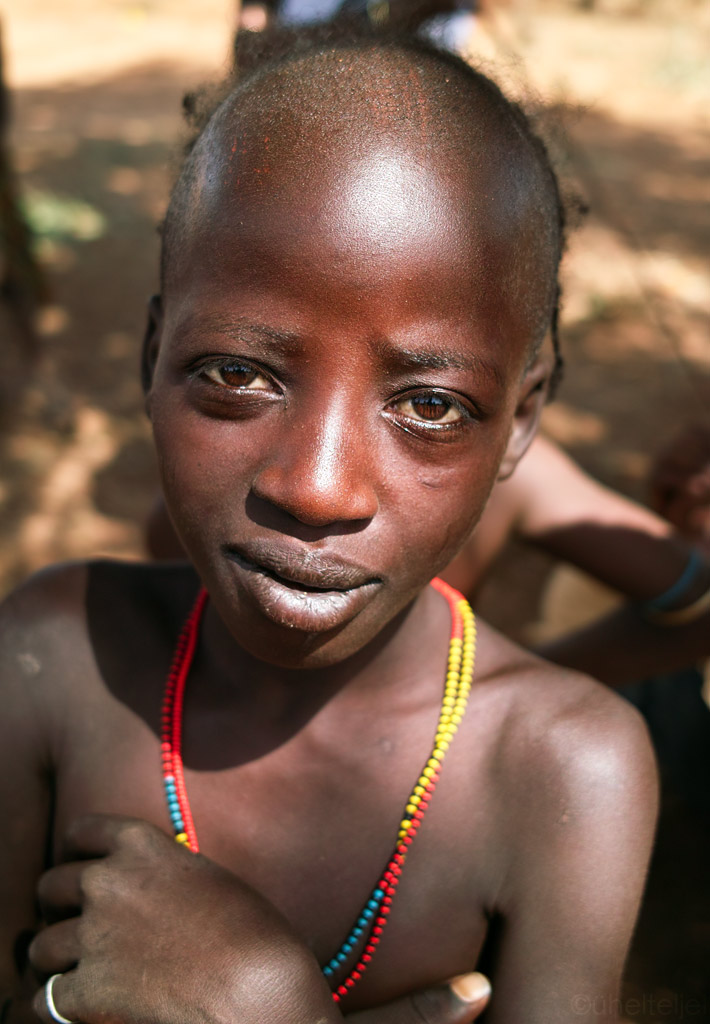
Boy.
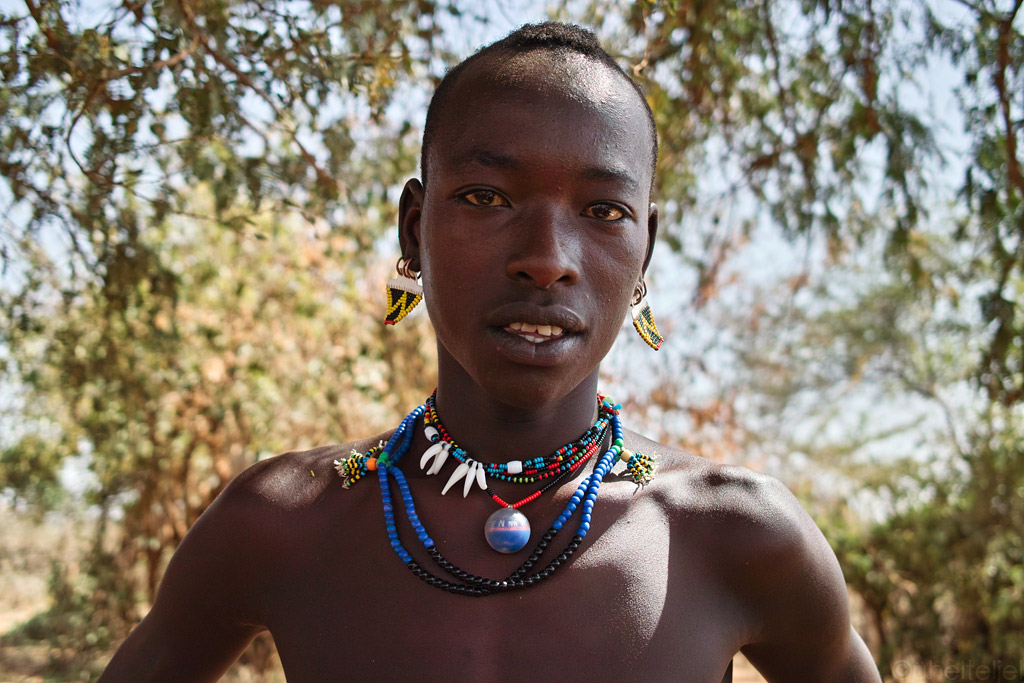
Young Hamer man with a working compass as a necklace - a future World traveller?
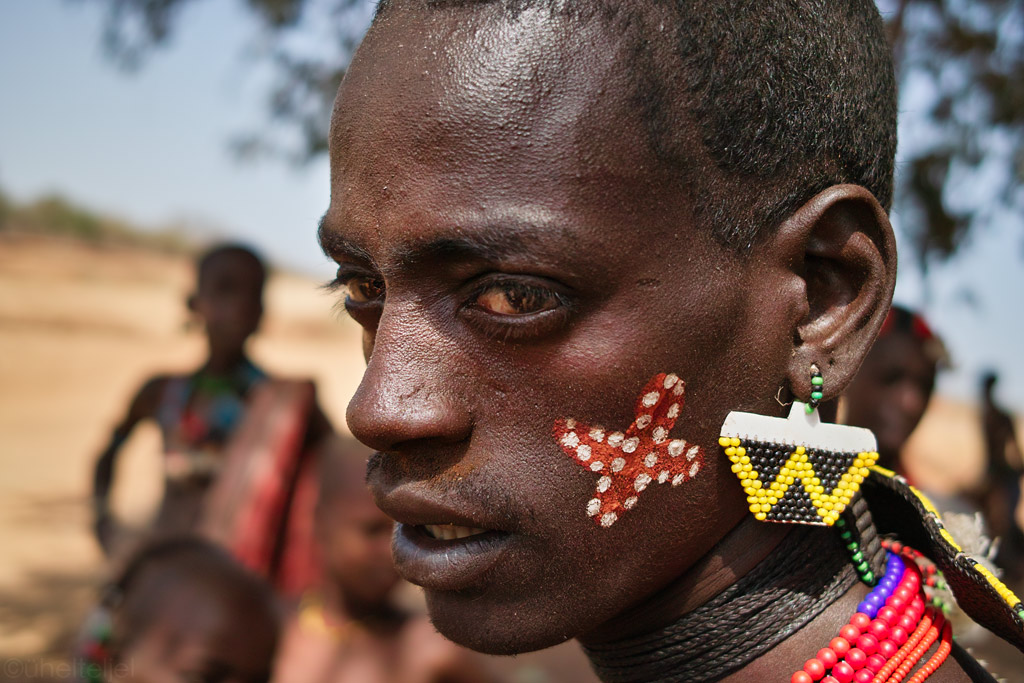
Portrait of a Hamer man.
Merry Christmas and a happy New Year,
Margus and Kariina
Of course we trusted our passports to DHL (and not regular post) to be delivered to the Ethiopian embassy in Sweden and then to be brought back again. I do not know if any other company would have performed better, but DHL truly screwed. They might be fast and efficient when it comes to transit, but it took them five days (!!!) to go and pick the passports up from the embassy once the visas were ready, and even that required expensive international calls and multiple visits to the office in Djibouti - just to get things moving. This was simply frustrating, and of course it all cost a fair bit (even though we were trying hard to keep down the cost by staying at the very cheapest hotel we could find, and cooking rice and lentils on our camping cooker in the very same hotel room, every day), but sure the DHL in Sweden is accusing the DHL in Djibouti, and vice versa. It is not the first time DHL has let us down, so I guess next time we'll be using some other company.
So after two weeks, when we finally had our passports, we just zoomed off towards Ethiopia.

Portrait of a Djibouti man.
Djibouti is a small country and there is not much to see, so on the way to the Ethiopian border we easily managed to squeeze in the major sight - Lac Assal, a salt lake situated at 150 meters below sea level, making it the lowest point on the African continent. Maybe not as syrreal as Salar de Uyuni in Bolivia, it still had its fair share of otherwordliness with turquoise blue waters licking the shores white with salt crystals.

Panorama of Lac Assal - lowest point on African continent (click to enlarge).

(click to enlarge the panorama)

Lac Assal.

Bush getting covered with salt.

A salt island on Lac Assal.

You can take pure salt from the beach of Lac Assal - note the salt forms smooth shapes around small rocks and sand particles.


Kariina searching for a good frame.

Colours of the Lac Assal beach.

Is it really the lowest point in Africa? Must be worth taking another pic then.
But to be fair, it must be said that not only was it the salt lake that made a positive last impression of Djibouti, but the landscapes and the nature were pretty spectacular, too. We got to see strange trees, canyons and a bunch of monkeys aside the road, so we were impressed and even felt slightly guilty for having had such negative thoughts about Djibouti.
The border crossing to Ethiopia had been making us anxious for a while because many a biker had become stuck on the border due to some very recent requirement by Ethiopian customs authority which says that a Carnet is not enough and one must have a guarantee letter by one's embassy in Addis Abeba saying that they take responsibility for you and your bike. Estonia, of course, has no representation in Ethiopia, so there was no way of getting the letter and we just had to go and try our luck without one. I do not know, maybe it is because the Ethiopian border with Djibouti does not have great significance in terms of tourism (it is crucial, however, in terms of transit to the Red Sea) and the officials there have not been informed of such requirement, or if there is actually no requirement at all (and it is all about greedy officials in certain border posts hoping to make an "exception" in return for some $$$), but the letter was never asked. What a relief!
The 40th country on our journey, Ethiopia greeted us with bright colours, and regardless on incessant "You! You! Money! Money!" coming from the local kids, we felt at home. It was truly good to be on the road again!

For a long time we hadn't seen churches, this time it's African style!

Remains of recent Ethiopia-Eritrea war...

Finding fuel proved to be relatively difficult on our route - fuel stations only offer diesel and gasoline (they call it "benzin") is mostly available from repair garages and private homes on the roadside - served from bottles and canisters.

Curious Ethiopian man checking us out.
There is an area in the North-Eastern part of Ethiopia that is called the Danakil Depression and that is pretty special indeed, populated by relatively unfriendly Afar tribesmen and home to glowing lava lakes and salt lakes smelling of sulphur. Never heard of it? We hadn't either. Not many people go there, regardless of all the excitement. It is also where the hottest place on Earth is, with only tracks leading through the sand, and it is damn close to Eritrea that is in a border dispute with Ethiopia. So the bottom line is - you have to go in a group of multiple 4WD-s and have an armed guide with you.
A tour would have eaten a good part of our budget, but we really-really wanted to get at least a glimpse of the Danakil Depression, so we decided to get as close as we could before sand would swallow us or we would be stopped by the police. We got as far as the Lake Afrera where the road ends and things start to heat up before we turned around. No police was there to stop us, but the perspective of digging the heavy bike from the sand in the oppressive heat at a gun point just did not appeal too much. Even there the temperature was +38C, so the common sense won this time.
It was a nice ride though, through endless lava fields and nice mountains.

Terara Afrera mountain (volcano).

Panorama of Denakil Depression's lavafields (click to enlarge)

Denakil depression, some 100 meters below ocean level.

Salt condensing and collecting at the Lake Afera.

Salt into bags and for sale worldwide - who knows, a pinch of salt for your fried eggs might come from here!?

Lake Afrera.
It is funny how some place can grow onto you. We stopped at a random truckdriver motel for the first night in Ethiopia (the sun was setting so we didn't risk riding on to find something more decent), and the next day, backtracking from our little Danakil Depression ride, we decided to spend there another night, although we could have ridden on for a couple of hours more. The shared toilets were stinky, the showers were slimy and the glass in our room door was broken so that hordes of mosquitoes could come feasting on us at night, but there surely was something about the place. Maybe it was the palm trees painted on the walls, or the cheap, good food, or the even cheaper beer (that costs just the same as a bottle of Coke!).

Berbere - a mix of sixteen or so spices.

Injera with goat meat.
We left with a good vibe, and the smooth tarmac was singing under the tyres. Then the mountains began, and the road - now gravel - started winding its way up the slopes. Compared to the arid landscapes of the North-East, it was a different world with lots of green and fields spanning as far as the eye could see. Only 15 years ago a huge famine took around a million lives in Ethiopia.

Some roads are very good quality!

Abandoned tanks - leftover from recent war with Eritrea.

V12 engine with a decent gearbox in one of the tanks.

There's loads of green in Ethiopia.

Landscape.

On the road.

Panorama of East-Ethiopian landscapes (click to enlarge each one)





In the mountains, the architecture is quite remarkable with thatched villages resembling something out of a fairy tale.

The farirytale land of Ethiopia.

Ethiopian huts blend well with the surrounding environment.



Ethiopian woman in front of her village
The road kept ascending and the air became colder and colder with every hundred meters. Would not have thought we could be freezing in Africa, but that was exactly what we were doing. The people were wrapping themselves up in whatever piece of cloth they could find.

Portrait of Ethiopian girl.

Young man.

Christian woman - cross on the forehead and drawings under the chin are religious tattoos.

Woman.

Children.

Young shepherd fighting with cold and rain in high Ethiopia (3500 meters above sealevel)

View from 3500 meters (11 400 ft)

Portrait of a local.

Portrait of a girl with stunning eyes and looks.

With that look, she could probably be a model in the Western world.

Farmer bringing tools to his field - all is whether man- or bull-power.

Ethiopian farmer with tools attached to his body.

A child.
Then, just before the sun began to really set, we crossed a 3500 meter pass (have we somehow wandered back to the Himalayas???) and found ourselves on a high plateau. The air was oh-so-crisp and the landscapes painted in sunset shades and colours were truly mesmerising.

Light play seen from the high Ethiopian plateau.

Farmer's field and house on the plateau.

Covered up for the cold.

Fields as far as an eye can see...


Portrait of a local girl.
We would have liked to camp, but the area was all just villages and cultivated fields so we stopped at the first house with a sign "Hotel" on it. The room was dark and dank, and the dry loo was somewhere fifty meters away, but hey, what do you expect for $ 1.20? The family cooked us some very simple food and some hot tea, so we actually could stop shivering before going to bed.

Who said Africa is hot? Flippin' shivering cold it is! A cup of hot tea helps tho.

Strange as it is, we had never seen people so devoted to Christian practices than here in Africa. Christianity, which only arrived in Ethiopia in the 4th century, is the faith of some half of the country's population - thus it is no wonder one can see white robed pilgrims, holding open umbrellas above their heads, walking to some important site (obviously there are many of them), and every now and then some cross or church protrudes the horizon.
But the most remarkable churches in Ethiopia are not those very high or colourful, but those buried in the ground. In Lalibela, one of the most important pilgrimage sites in Ethiopia, a cluster of churces was built in the 12th to the 13th centuries. What is striking is that they were actually not built but hewn into the rock, making them true masterpieces, confirming once again that faith can inspire people t do great things.
Lalibela in itself is nothing more than a village, but it holds an amazing 11 churches. The most famous of them, the one dedicated to St George (Bet Giyorgis) looks as symmetrical and perfect as if it were stamped onto the ground by some heavenly force.
But as the most important figure here in Ethiopia is the Virgin Mary, most pilgrims congregate around Bet Maryam, the church dedicated to her. There is a lot of action going on around there, with someone preaching, someone reading the Holy Bible, and someone singing a praise to the God.
We happened to hear a song which, enriched with some percussion instruments unknown in the churches in Europe, sounded interesting.
..:: LISTEN ::..

Pilgrims playing drum and singing devotional songs.

Religiously decorated shaker to make rhythmic sounds.

Men of faith.

Drums on the church floor.

Entrance to one of the churches hewn into cliff.

Christian pilgrim.

Bet Giyorgis church - hewn itno the rock - stunning piece of work!


Priest with his precious cross in a dimly lit church.

The same church from below the ground.

With pilgrim.

Young girl waiting for her turn at the church door.

Holy water is filled with life in the pool just aside the Bet Maryam church.

Pilgrim reading The Holy Bible in the direction of the church.

Pilgrims in Lalibela.

Some more pics from Lalibela...

Entrance to other rock hewn churches.

Women returning from a service - an umbrella symbolizes the holy glow of saints among Ethiopian Christians.

Roofs of traditional huts.

Unlike most rural huts, huts walls in Lalibela were made from stone and they even had electricity.

Women carrying water from the pool.

Tracks and doors in Lalibela.

Local fauna.

Lalibela's young man.
It turned out that not only was Lalibela a good place to get some religious enlightenment, but to get better acquainted with the local culinary traditions - on a higher level than in little roadside cafés off the beaten track.
Here we truly fell for Ethiopian coffee, which is of course no wonder because this is where coffee originated. Preparing coffee here is nothing like emptying a packet of 3-in-1 Nescafé into your cup and pouring some hot water over it. Here it involves a whole ceremony of burning incense, roasting the beans (and indeed, riding around Ethiopia one can very often smell the sweet and smooth aroma of roasting coffee), grinding them with a mortar and boiling it with the heat from glowing charcoal. One tiny cup of the strong and aromatic elixir was enough to make us appreciate coffee without milk - something we have never liked before, but Ethiopia has changed that.

Ethiopian coffe going strong on hot coal in an African styled coffeepot - afterall, it's the mother of all coffees.

Coffee is n ritual in Ethiopia, with careful preparation and serving.

This is where that strong and aromatic elixir comes from that wakes you up in the morning or keeps you going late at night.

Burning incence together with coffee is another Ethiopian thing - good smells go well along with coffee drinking.

And another interesting thing about Ethiopia is that coffee is served together with tea, sometimes even mixed. Here tea has some sort of local medicine in it.
Injera, too, the fermented "bread" of Ethiopia, had some surprises for us as it was far finer and more elaborate than the ones we had tasted so far. Here, many different fillings were put on top of it - boiled vegetables, chopped spinach, tomato salad, chickpea purée, lentils, meat - to be scooped up by the same injera. We could eat endless amounts of it, but one has to remember to leave some on the plate - in Ethiopia it is believed that empty plates invite hunger.

Ethiopian lady selecting lentils - the sauce made out of those very same tasted superb on the pic below!

Injera - a mix of vegetables and sauces on injera - eaten by hand only.
The arrival of Christianity is definitely an important milestone in Ethiopian history, but it does not mean there was nothing here before. Around 400 BC the pagan kingdom of Aksum was created in the North that thrived from the 3th to 6th century. Considered one of the greatest kingroms of the ancient world, it encompassed areas as far as Southern Arabia and parts of today's Sudan. We went to check out how its capital, Aksum, is doing today.
On the way there we stopped in Mekele, a university town, but although with some 200 000 inhabitants it was the biggest town we'd visited in Ethiopia so far, it really resembled more an oversized village. I can only guess that with a few exceptions, African sities will not be blowing us away with being too civilized or sophisticated, so we better enjoy what we have. After all, if this is not the exotic stuff we're after, then what is?

A street in Mekele.

Christian man with a cross cut into his forehead.

One of more modern-looking churches.

Window in Mekele.

Colourful houses.

Girl wanted a portrait, she got one.
On a Sunday morning we were awaken even before sunrise as the churches' (!!!)rupors started transmitting some sort of religious recitals. Coud it be that here, where Islam and Christianity co-exist, the priests have started to copy their "colleagues", reminding their congregations that Sunday is the day of paying a visit to the church?
On the way from Mekele to Aksum we got off the main road hoping to find some of the famous rock hewn churches, but once again it seems that the tourism policy in Ethiopia has employment as one of the priorities, so it is difficult if not impossible to find the churches on your own, without a guide, as they are not signposted. Just like with the Danakil Depression to visit which you need a guide and an armed guard - without you will not even be permitted past the checkpoints. So all we could enjoy were the fine views, and they were fine indeed, almost justifying the terrible road conditions.

Panorama from the road (click to enlarge each one)

Panorama of a village.

Panorama of the peaks.

Panorama from the road through some interesting peaks.

Panorama of the mountains.

Somewhere in North Ethiopia.

Road through mountains.

Children seem to be the main workforce in Ethiopia - you mostly see children working in the fields and herding the animals, very few adults.

Ethiopian huts.

In a village.

Stopped under a lone tree - of course people immediately come out of nowhere to check us out.

Shepherd girl.

A tree.

"Money-money!" she said first, I took a pic, showed it to her and that seemed to satisfy her.

A girl with a smile.

Carrying the younger brother.

Shepherd.
Aksum, once capital of the mighty kingdom, was again nothing more than a village. We paid a mandatory visit to ancient stelae standing above tombs of important figures of past times and found them to be pretty outlandish. Standing up to 33 meters high they are definitely a great source of information for historians about the life in the kingdom, but what is the most intriguing is how they managed to erect these huge slabs of stone in the first place. Some believe it was the heavenly creatures, some say elephants were used. The highest of them, weighing 360 tonnes, was actually never erected - it fell down and to pieces in the process. Some, of course, interpreted is as a sign from heaven that it is finally time to convert to Christianity. Although it might as well been a sabotage.
In any case, regardless of all the intrigue and the obscure goings-on, the stelae are a magnificent monument left by the peope of times long gone.

Stelae of Aksum kings.

They are VERY tall.

Some had to be artificially supported.

The biggest monolithic rock man ever has attempted erecting in history fell down - the very same one.
Otherwise, Aksum is a friendly kind of place with good food and local rhythms and melodies.
One morning we went to get a breakfast in a restaurant without any signs, and picked a random thing from the menu as we have not really become experts yet on Ethiopian culinary terms. It was "fata". The waitress came to our table with a bowl of bread, and started ripping the bread into little pieces in front of us. We were slightly confused but enjoyed the show. Then she disappeared with the bowl, and five minutes later appeared again the contents of the bowl looked like this:

Fata.
The pieces of bread were mixed with spicy tomato sauce, and added to it were scrambled eggs and natural yoghurt. Does not look like much but is actually tasty and filling. Gotta try other unknown things too!
The North Ethiopian landscapes had been cool, but the Simien mountains were definitely the pick of the bunch. I am not even sure why exactly, but something kept on telling us that this was the place we had to go see - otherwise we would have limited ourselves to Lalibela and turned south towards Addis Ababa instead of going further north and braving the terrible roads.
Up until Aksum it wasn't actually that bad, but from there on the corrugations became even more spiced up by sand, dust and big rocks, so we really hoped the Simiens would live up to our expectations and justify the terror. In addition, the sky was overcast and as we left Aksum, the landscapes seemed extraordinarily bleak.
Of course, the views soon became more and more promising, almost resembling the Monument Valley in the USA.
As usual in Ethiopia, the entrance fee to the Simien Mountains national park cost us "non-resident tourists" a fair share of birr (Ethiopian currency, pronounced quite similar to "beer"), but we had not come so far to just turn around without seeing the mountains up close. So we paid all the entry, vehicle, camping and scout fees, and off we went. Without the mandatory scout ("to protect us from the locals who might not be honest") of course, as there is no space for a third person on our bike. The gatekeepers were quite confused because of our scoutlessness, but after some negotiations they gave up and let us go.
As it too often happens, as we entered the national park, the sun was setting so we had to find a place to pitch the tent, and fast. We had to stop many times for pictures before though - the view from the height of the 3000-metre plateau painted in sunset colours and glowing mist was simply mindblowing, even though the altitude also meant it was really, really cold.

Panorama of the sunset (click to enlarge)

Panorama of the Simien National Park.

Plant with leaves having thorns in Simien.
Locals wrapped into cloths came to check us out. Obviously they were not the dishonest kind as before too long the good old straightforward "money-money" and "gimme-gimme" talk began. Regardless, one could see it was nothing but an automatic reaction, and that they were obviously curious of us and the bike - without a scout. 4WD and bus tourists must be a more frequent occurrence here.

Local young ladies.

Ethiopian boy.
Although theoretically one can camp anywhere in the Simien Mountains national park, we decided to pitch the tent in a fenced area - we would have been too tired to be pleasant talking companions to who ever would stumble upon us at a random spot, and this one provided a good night's sleep.

Camping in Simien.
The next day we rode around a bit more, and took in the views of the wrinkled, chapped landscapes below. Amazing!

Panoramas from the Simien National Park (click to enlarge each one)




Our trusty twowheeler at 10 500 ft.
On the way from the Simien Mountains to what is called the Ethiopian Riviera, namely the town of Bahir Dar, we stopped and took some pictures of local markets. They are quite different from the ones in Asia for example, where goods are neatly displayed and really nice to smell and look at. Here, everyone sets up their "stall" where ever they fancy, and the overall picture is pretty chaotic - someone sells his ten potatoes, someone his bagful of cereal, and someone his astonishing array of basketware. Add to it a couple of confused sheep and donkeys, lots of dust and loud bargaining, and you get the "African market".

African souk in Debark.

Market at an old mosque.

Curious young lady came to check us out.

Debark souk.

The market in Bahir Dar was a tad more organised.

Ethiopian coffee going strong on hot coals - a refreshment for the market shoppers.

Spoons for sale.

Stuff at Bahir Dar souk.
Bahir Dar is located on the shores of the largest lake of Ethiopia, Lake Tana. The lake itself did not really impress - guidebooks rave about the old monasteries on the lake, but we decided we had had enough of religious stuff, so we skipped them and just relaxed in the tropical atmosphere amidst the coffee and other good-smelling plants.

Lake Tana.

Fresh greenery aside lake Tana.

Coffee tree just behind our guesthouse's window - grab the beans, dry and roast and you have your coffee.
As it was pre-Christmas time, one morning there were processions of white-robed people in town, with singing and drums:
But once they passed, the local pop music was again turned on. Ethiopian music is surprisingly and enjoyably original, with distinctive rhythms and harmonies we found to be absolutely tasteful.
Bahir Dar also turned out to be a good place to taste some more local specialities.
For example, for breakfast one can have genfo which is a sort of porridge served with butter and berbere. Very thick, it is normally made of barley flour, and fery filling.

Genfo.
The locals seem to like the variety of injera called fir-fir. It is basically a torn-up injera mixed with whatever sauce, but as always, it is eaten without ustensils so it is quite slippery between the fingers.

Fir-fir with 2 additional injera rolls.
And a local delicacy called kitfo - injera with warmed-up (not cooked!) mince and a little berbere. May sound gross, but actually quite good! (maybe it would be worth to go and have ourselves checked for tapeworms later though…)

Kitfo - half raw mince.
Surely, a local beer goes well with the food. Ethiopia produces a fair variety of brews, and since they are all cheap, we just keep on trying them out. Even Kariina who normally would only drink beer in sauna or if in desperate thirst, has started to enjoy it. Oh, dear!

Ethiopian beer - costs exactly the same as bottle of Coca-Cola!
When we arrived in Addis Abeba there was a lot of good Ethiopian music playing from TV. Being tired of western pop and hiphop, the Ethiopian music videos do have a certain charm in them with the love of countryside and fantastic choreography (try to perform those sharp dance movements yourself - not!)

<object width="640" height="505"><param name="movie" value="http://www.youtube.com/v/0lL5uGObHNo?fs=1&hl=en_US"></param><param name="allowFullScreen" value="true"></param><param name="allowscriptaccess" value="always"></param><embed src="http://www.youtube.com/v/0lL5uGObHNo?fs=1&hl=en_US" type="application/x-shockwave-flash" allowscriptaccess="always" allowfullscreen="true" width="640" height="505"></embed></object>
We only stayed in Addis Abeba, the Ethiopian capital, long enough to get our Kenyan visas (normally they are available on arrival but we were planning on crossing the Ethiopia-Kenya border in a place where there is no border post, so we had to do it in advance). Just like other African cities we had seen so far, Addis was more like an overblown village, and not a really attractive one, so we did not linger.
Exiting the capital towards the south, having stopped at a fuel station we discovered that the rear brake had given up its work contract, so we proceeded a little more cautiously, relying on the front brake only. This is also where we recorded the lowest fuel consumption on our trip - the recent cruising on curvy mountain roads, with smooth accelerations and decelerations had only taken 4,2 liters per 100 km, which is not bad for a heavily loaded 12-year old big bike running on poor quality Ethiopian petrol. Not to mention the non-existant aerodynamics of the boxer GS. They've built them bikes good.

A tank in the fundamentally best and most humane position - abandoned and rusting.

Barrel warning.

Lake Abaya.
Arba Minch, a town near Lake Abaya, is the last official place to get petrol for the next 1000 kilometers or so if going south-west - after that one can only rely on petrol from a barrel in someone's backyard, if there is left any, and which of course is of dubious quality but nevertheless costs double the official price. So we filled the tank and an additional 10-litre jerry can that would normally give us autonomy of 800 kilometers or so, but the expected harsh conditions and a few unplanned detours would require us to replenish the supply "unofficially" along the way anyway. And as we found out soon, it isn't necessarily an easy task - in one village it took us nearly an hour before a jerrycan full of petrol could be collected from here and there.

A crowd gathers everywhere we stop.

Curious african men.
The further south-west, the rougher became the road, but we were clearly in Hamer territory as we kept on spotting people wearing nothing but goatskins and beads tending their livestock in the bush.

Decent gravel in Ethiopia.


Hamer men we met on the road.
The Hamer people, some 40 000 of them, are one of the many tribes in the Omo valley in South-Western Ethiopia. To get a closer look at them, we decided to visit their weekly market in the village of Dimeka - the Hamer people congregate to Dimeka to sell their produce, wares and livestock from near and far, and of course, their looks and attire are so distinctive and colourful that one would think it is some sort of costumed parade, not a regular market day. In fact, colourful beads and feathers (which men are even more fond of than women) are an everyday accessory, as well as rope-like hairstyle (acieved by applying mud) of the Hamer women. Interestingly, most of those features have nothing to do with rituals or social status - they're just for beauty. And to be honest, the Hamer people do look attractive.

The usual crowd around.

Christian girl who for some reason held Kariina's hand all the time.

Features in face like out of "Avatar" movie.

Portrait of an African lady.

Local flora.

Building a house, African style.

Hamer women selling their stuff in Dimeka market.

Portrait of a Hamer man.

Hamer woman.
While in Dimeka we heard that nearby an important event in a Hamer person's life, a bull-jumping ceremony demarcating the "marriageworthiness", was about to take place. Sure we wanted to get a glimpse of it, so we looked up a guide and set out to find the village in which it was happening.
We arrived and were greeted by a bunch of men in their regular, colourful attire. But to add even more colour to the event, some body painting was going on, and even we got some paint on our face. Then the ladies came - some had more clothing on them, some had less - making lound noise with bangles tied to their legs, and blowing horns. Dancing and singing, they tried provoking men to whip them as the Hamer people believe that scars on a woman's body signify her love and devotion to her husband - the deeper the wounds and the bigger the scars, the more profound the devotion, and consequently the respect from the community towards the woman. So they are not exactly unhappy to be whipped. After an hour of chaotic hornblowing, singing, dancing and whipping, the backs of the women were bleeding and everyone was happy. An intense experience, if you like.

Hamer women on the move - something is about to happen.

Painting Kariina - they had a lot of fun with it, Kariina too.


This is how they make paint - it's grinded from rock and mixed with water.

Colourful Hamer tribesmen...




The boy is about to become a man.
It was all accompanied by quite a lot of noise, which sometimes nevertheless resembled some melody:
..:: LISTEN ::..

Hamer women dancing.

The scars of love, dedication and devotion.




Hamer boy with a playgun - it had some strange meaning in the ceremony.

Attractive Hamer ladies posing.

While men were checking our GS out.

Hamer men.

Boy.

Young Hamer man with a working compass as a necklace - a future World traveller?

Portrait of a Hamer man.
Merry Christmas and a happy New Year,
Margus and Kariina

